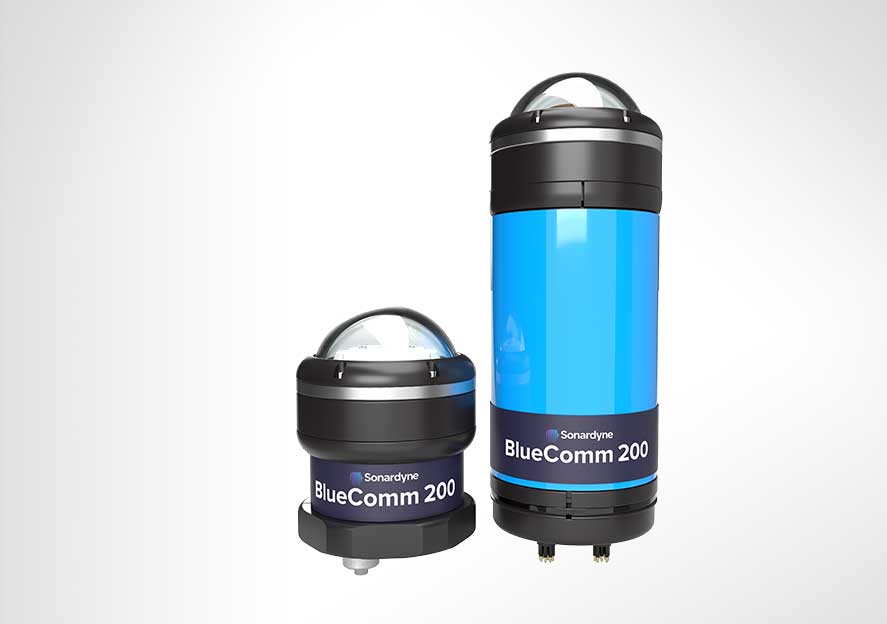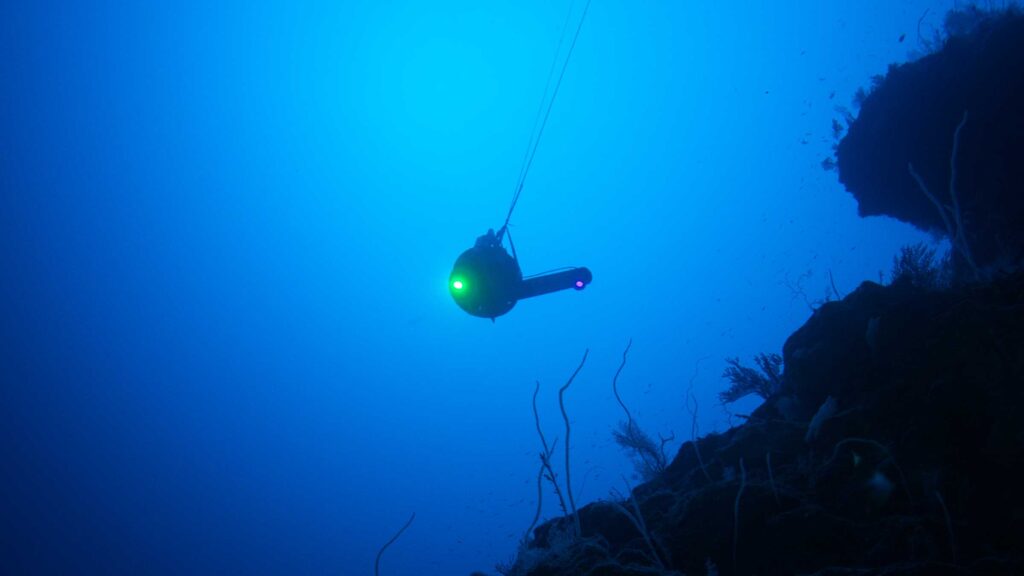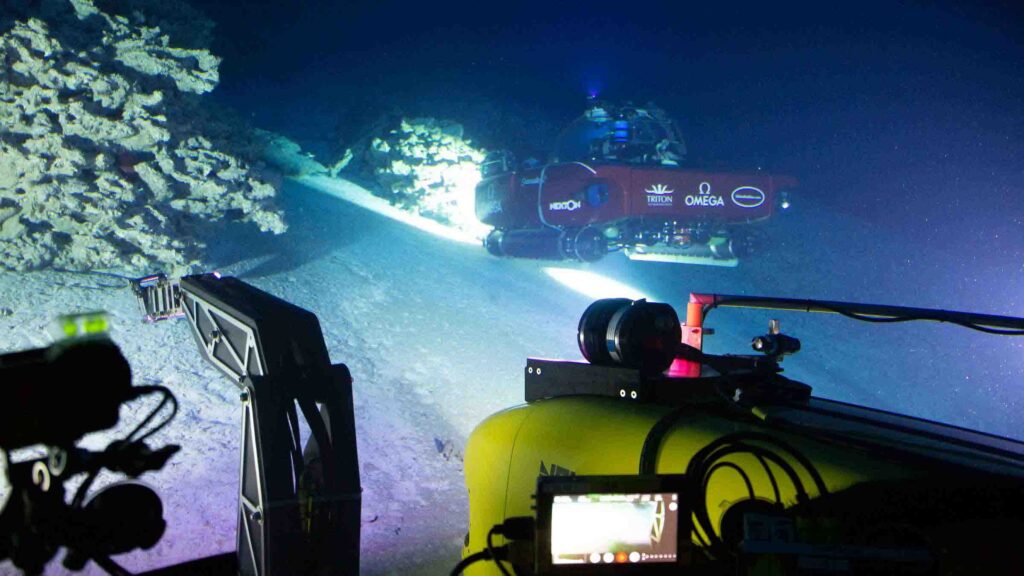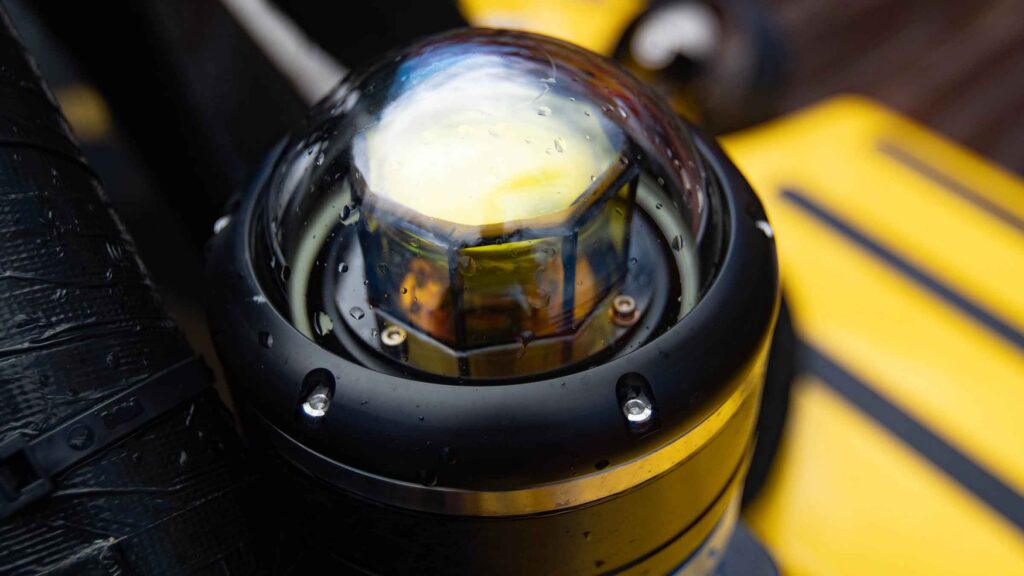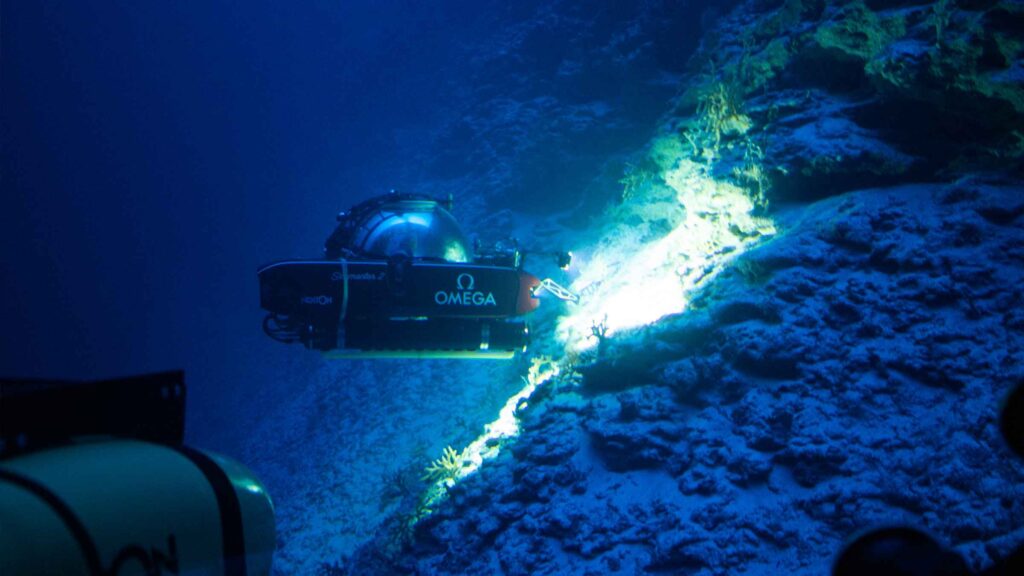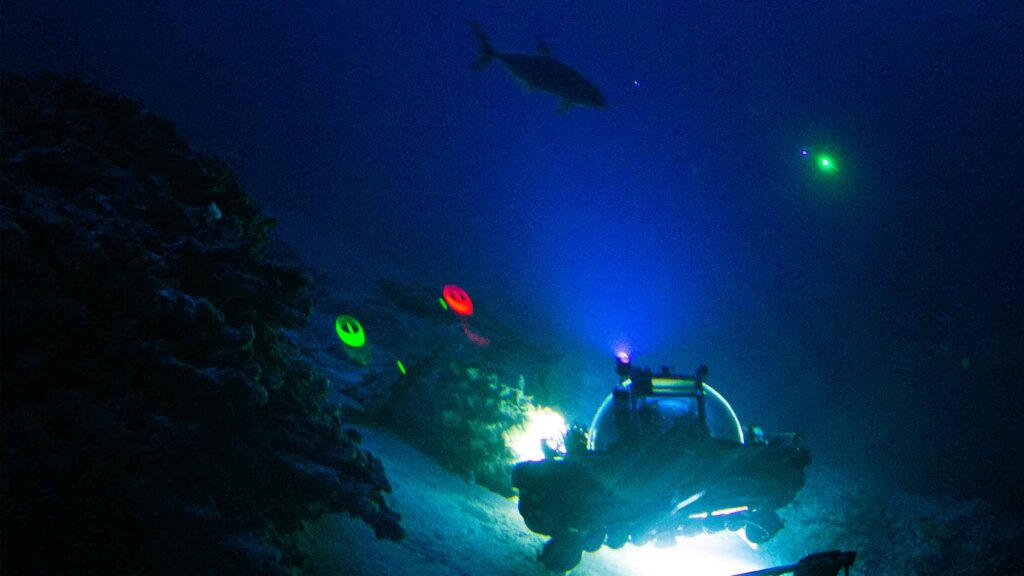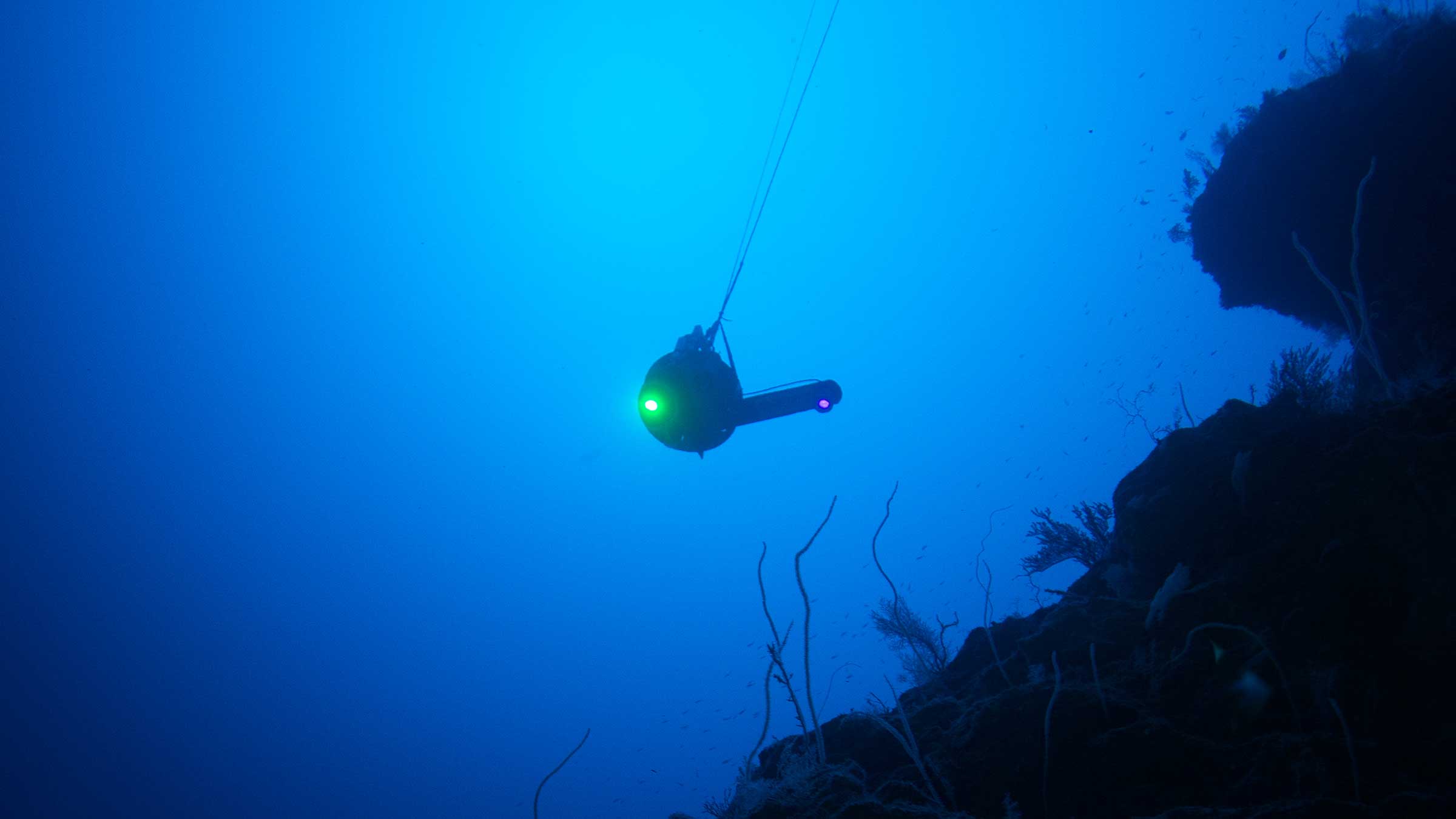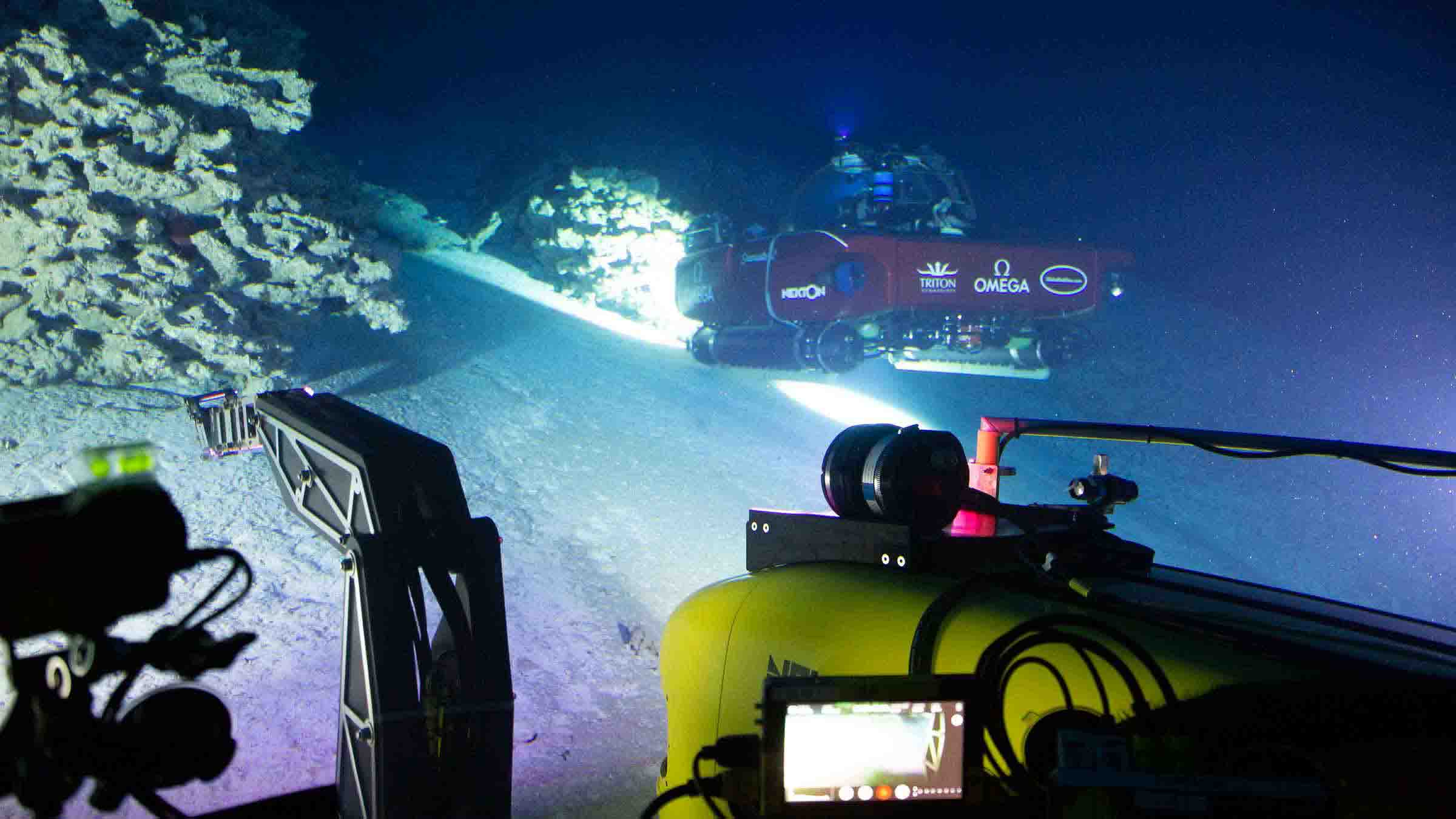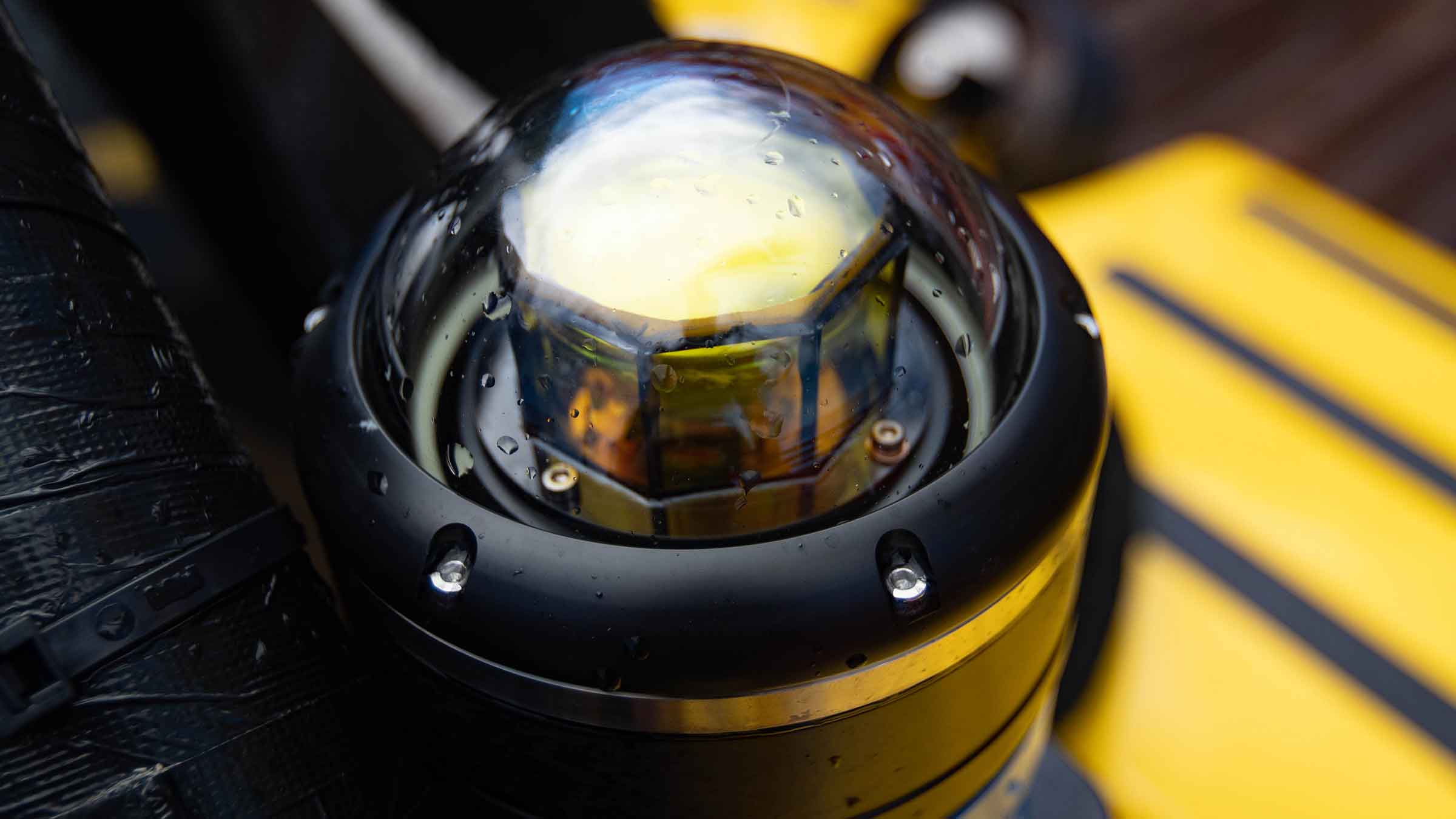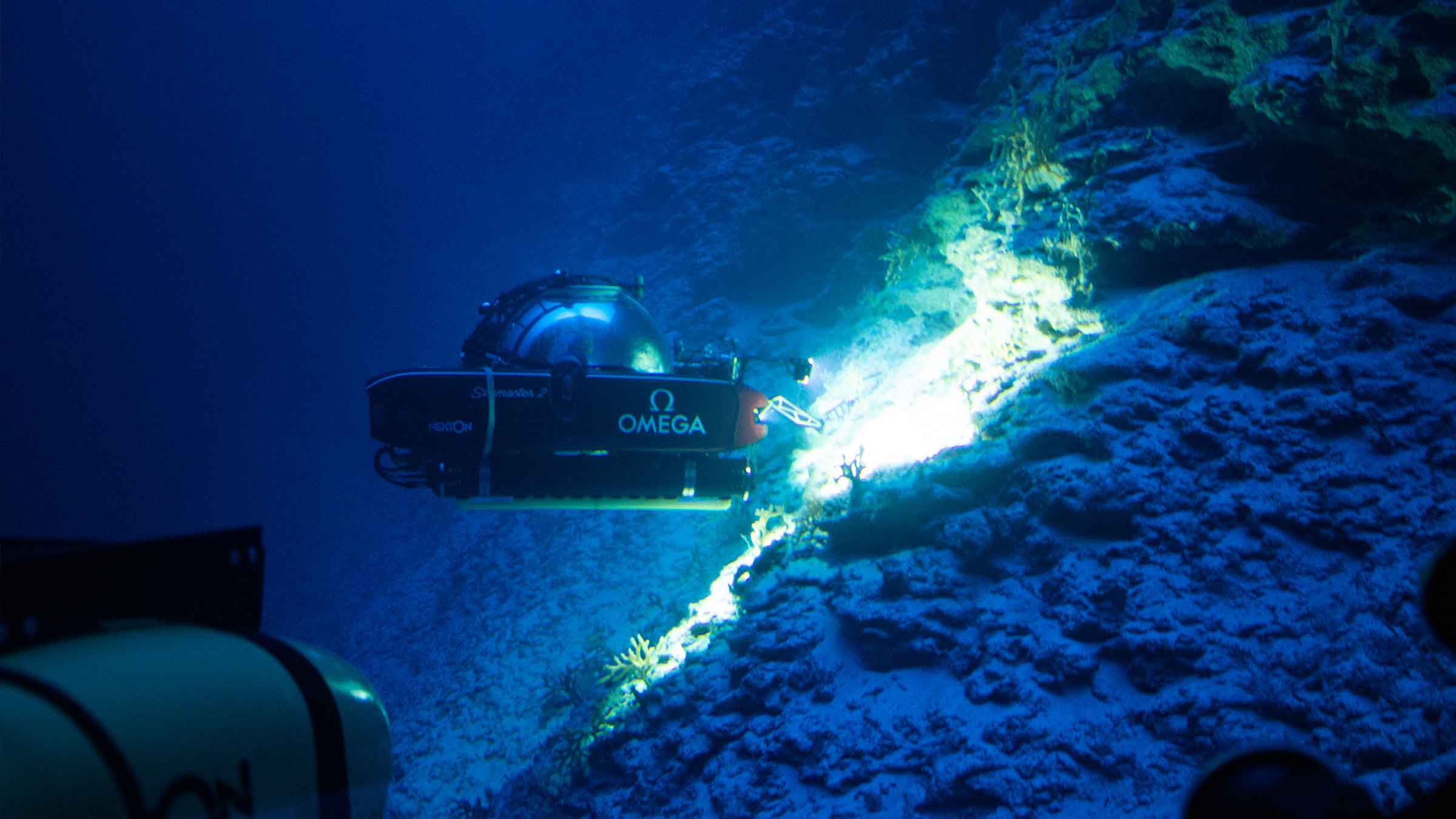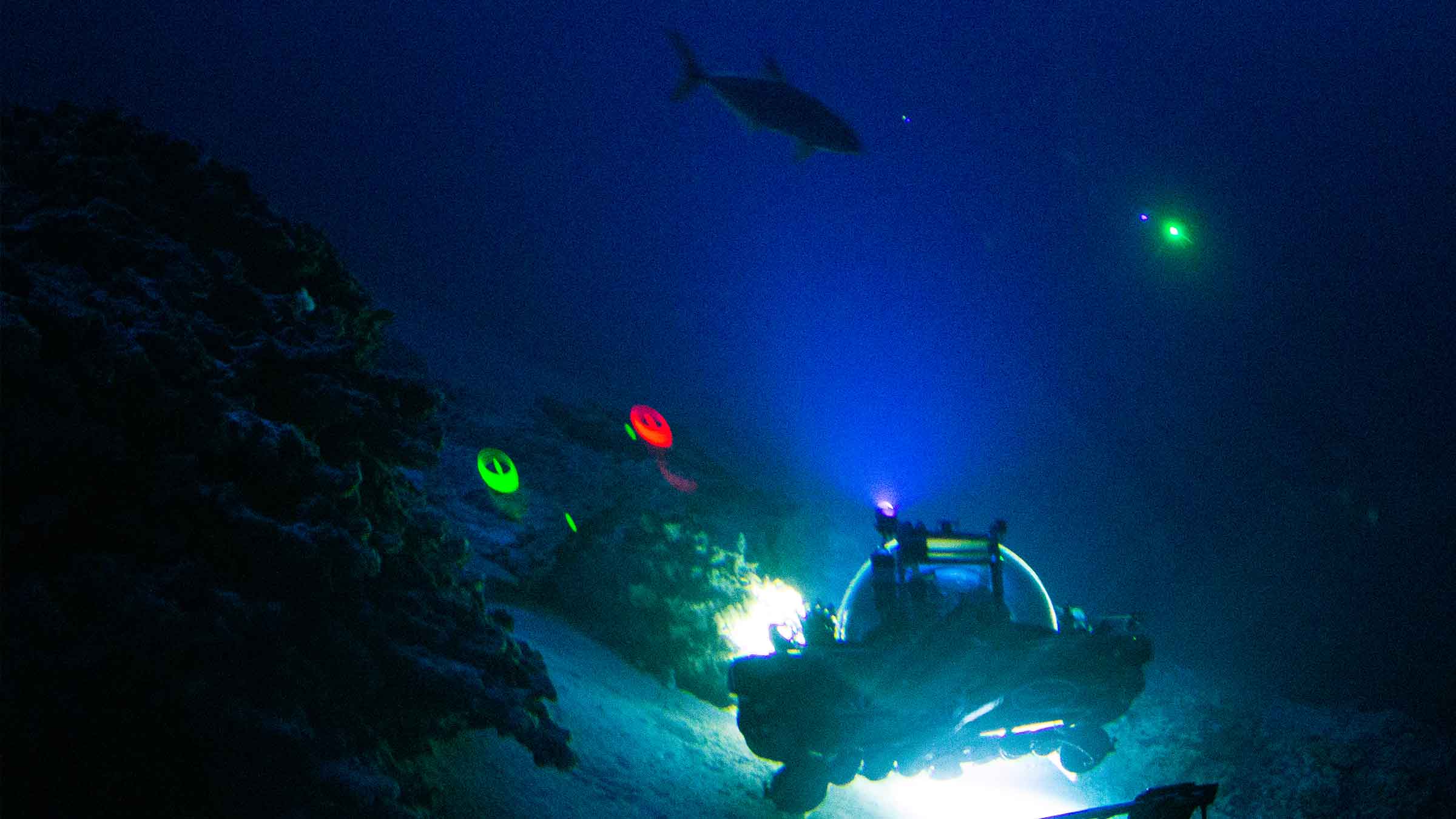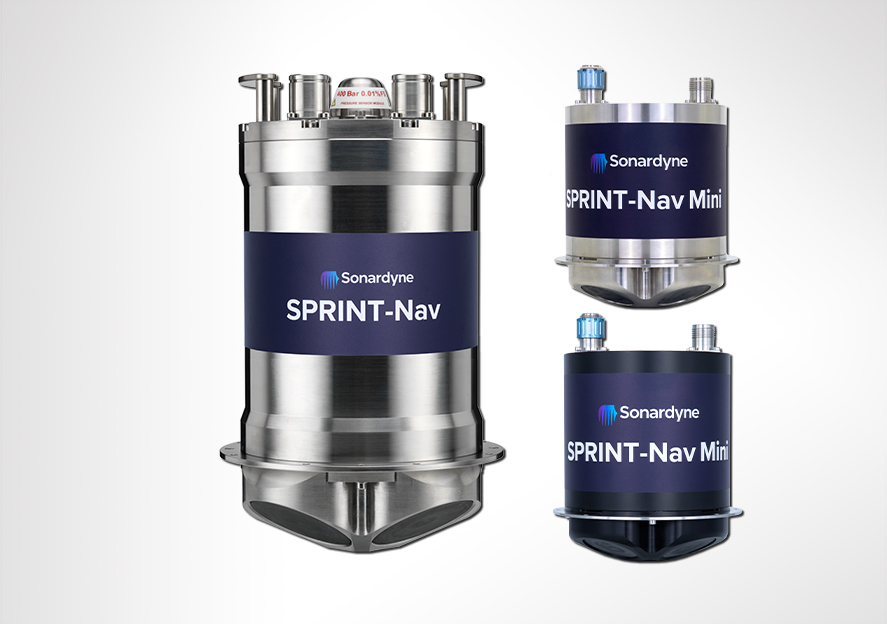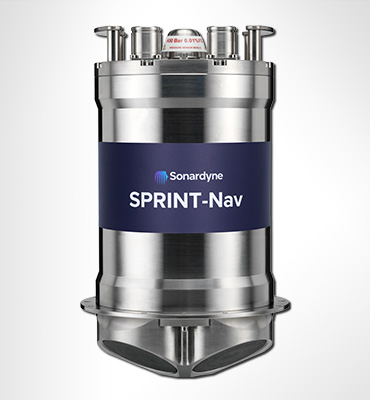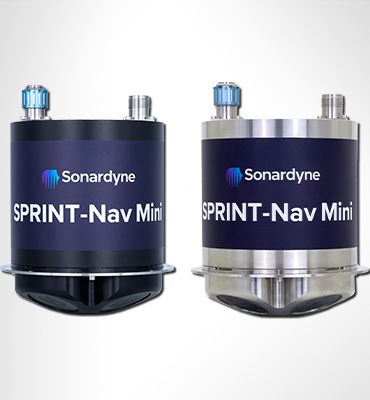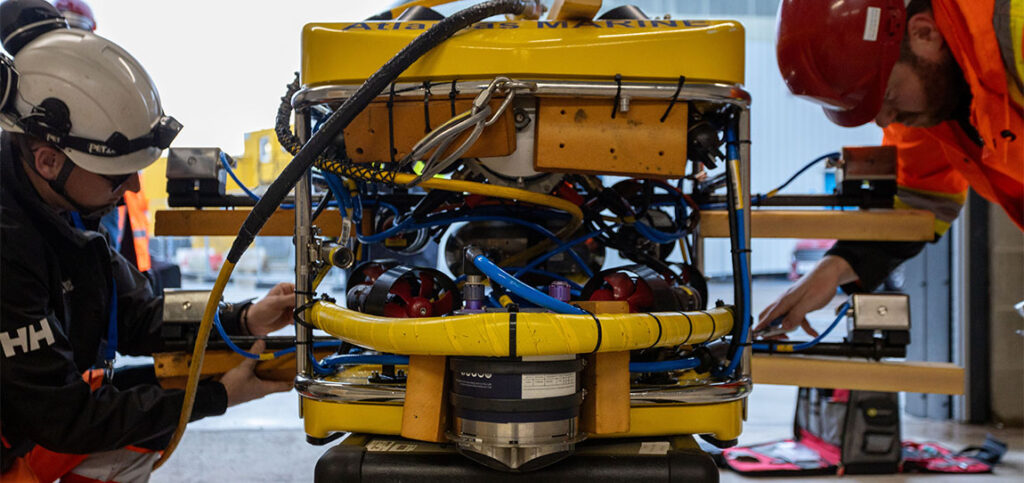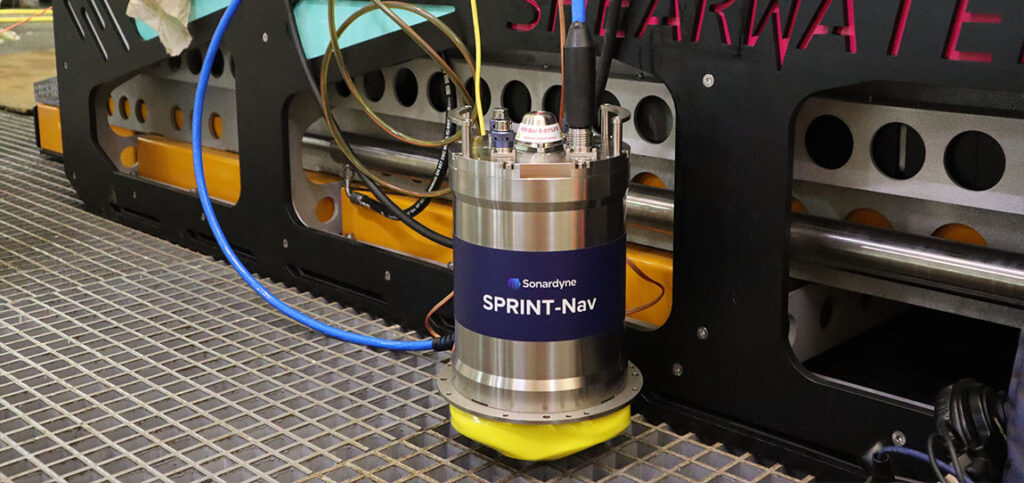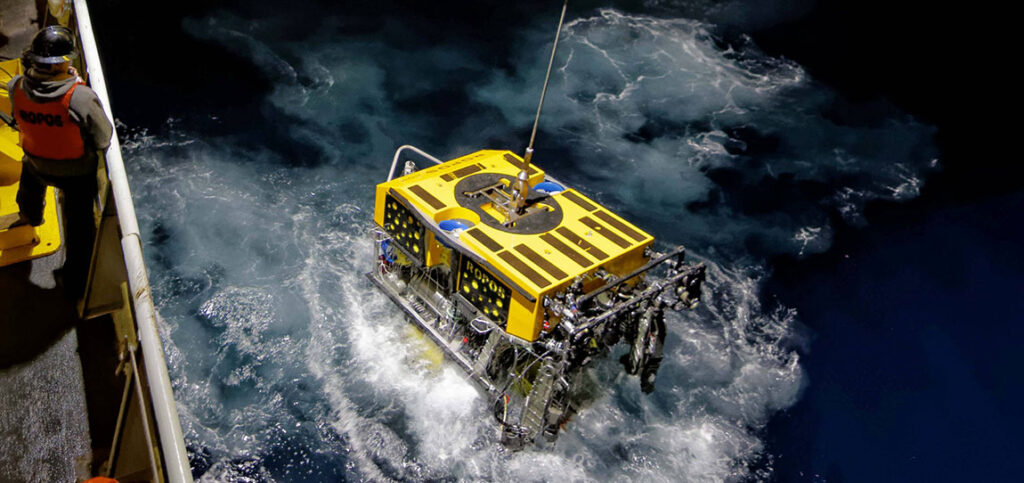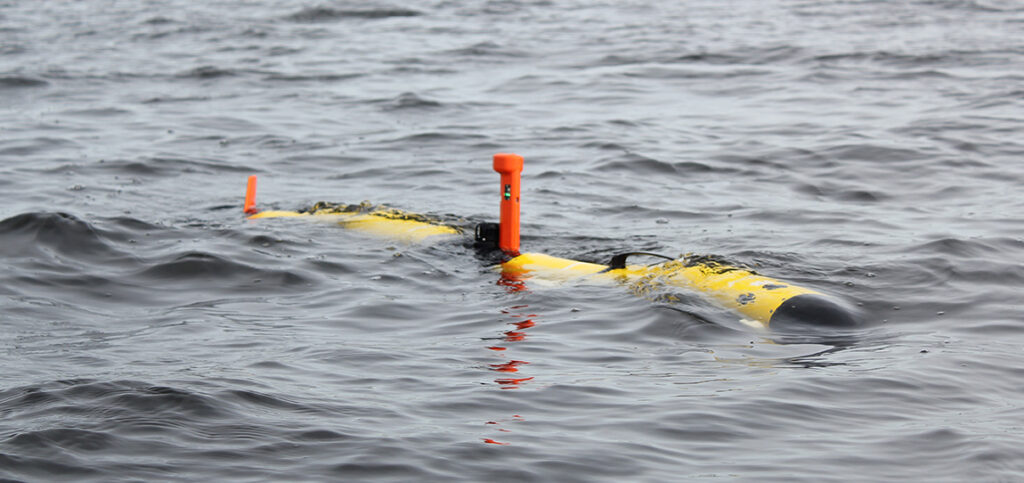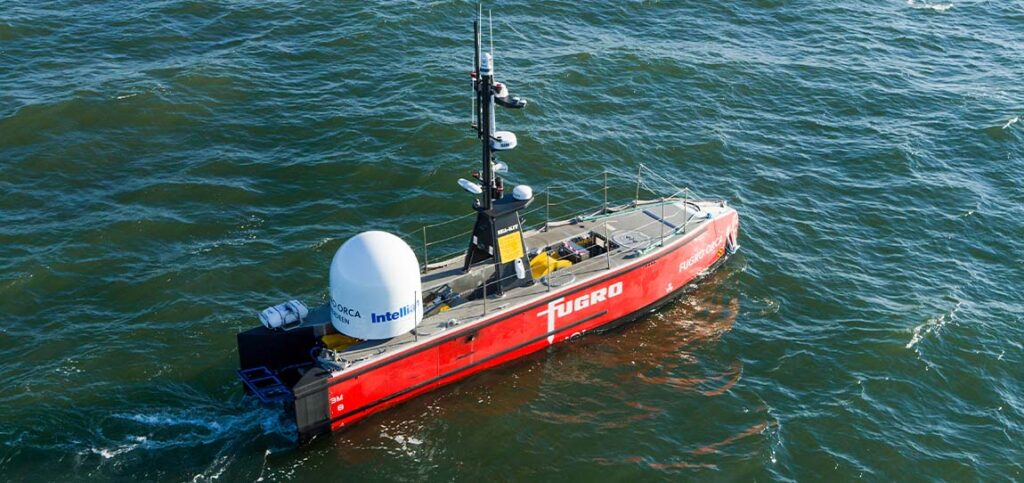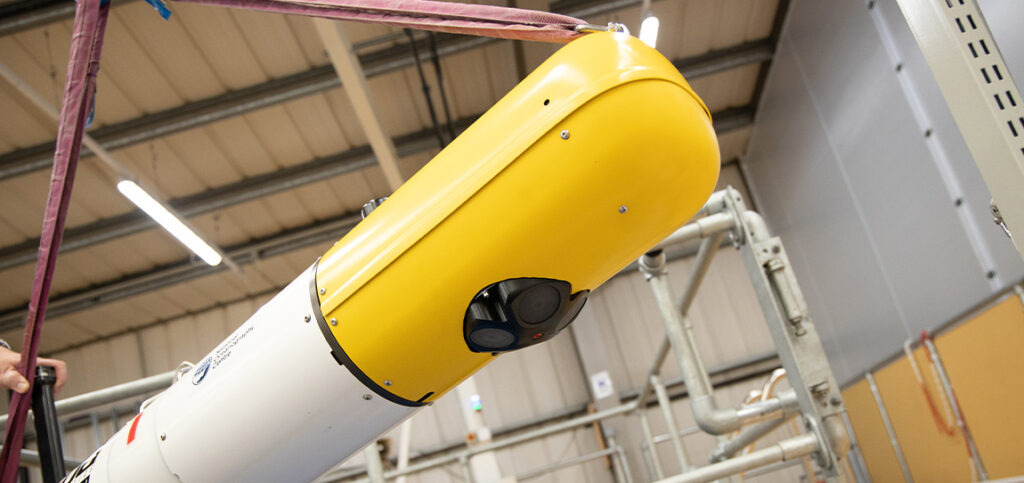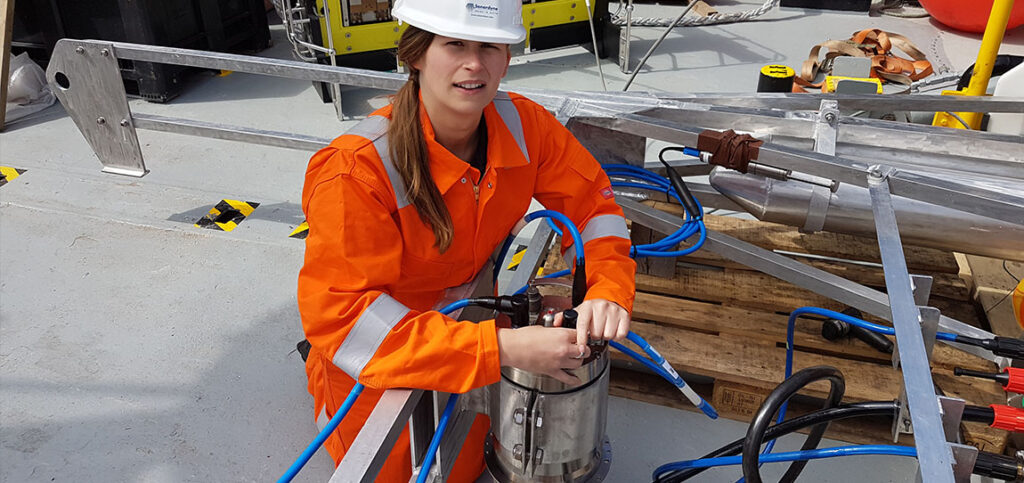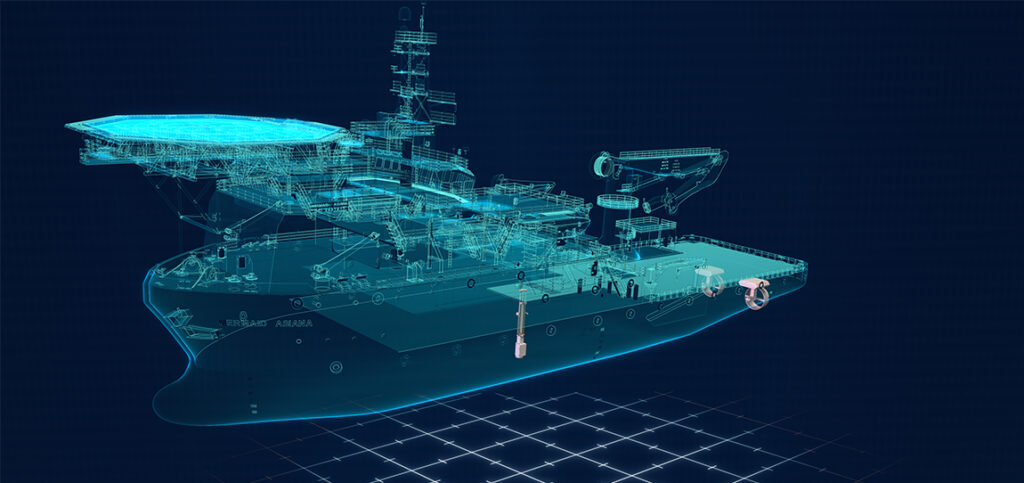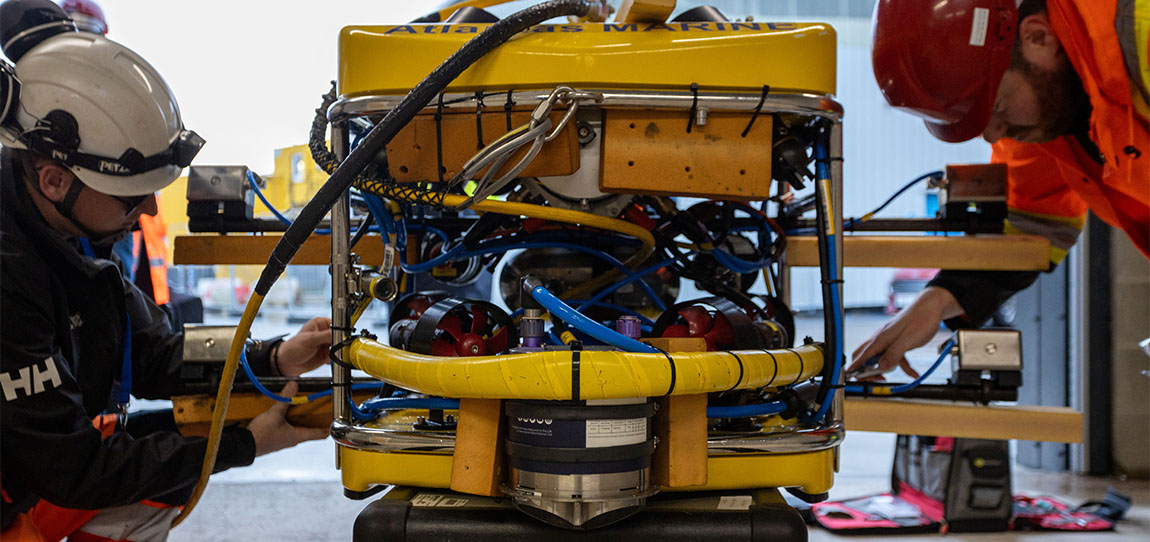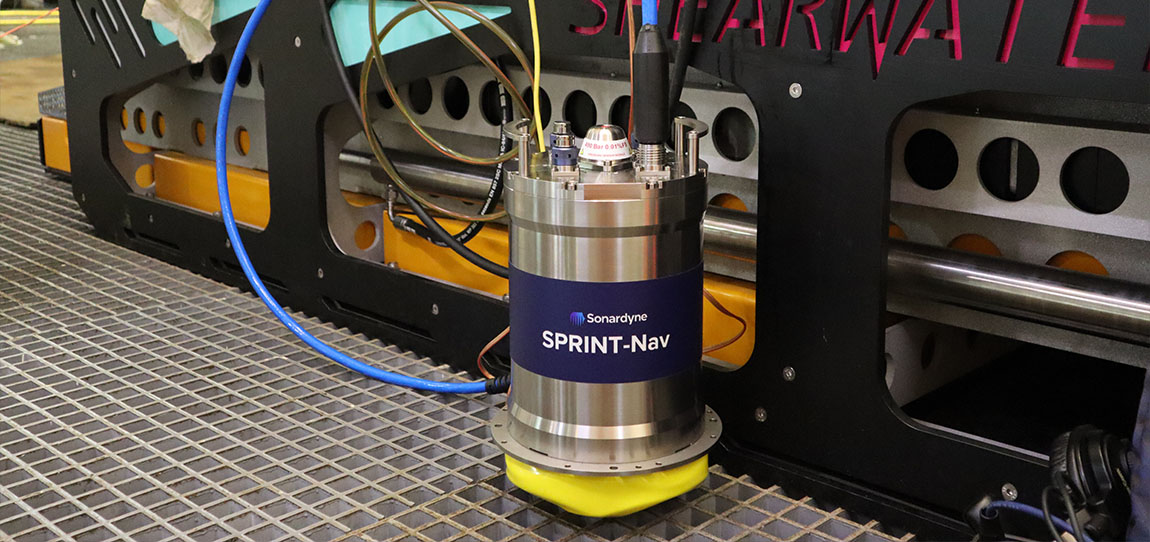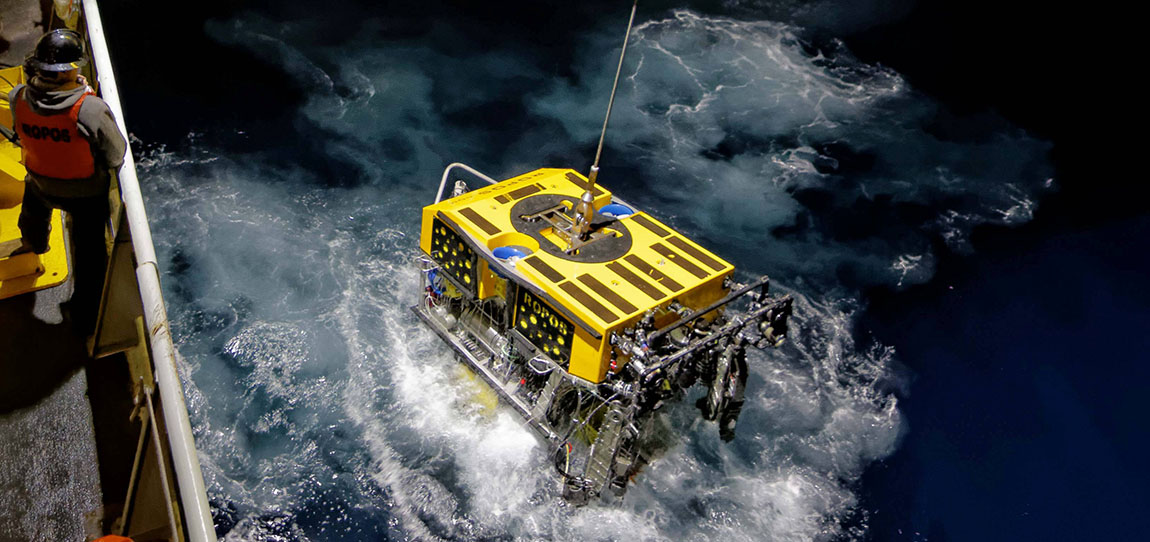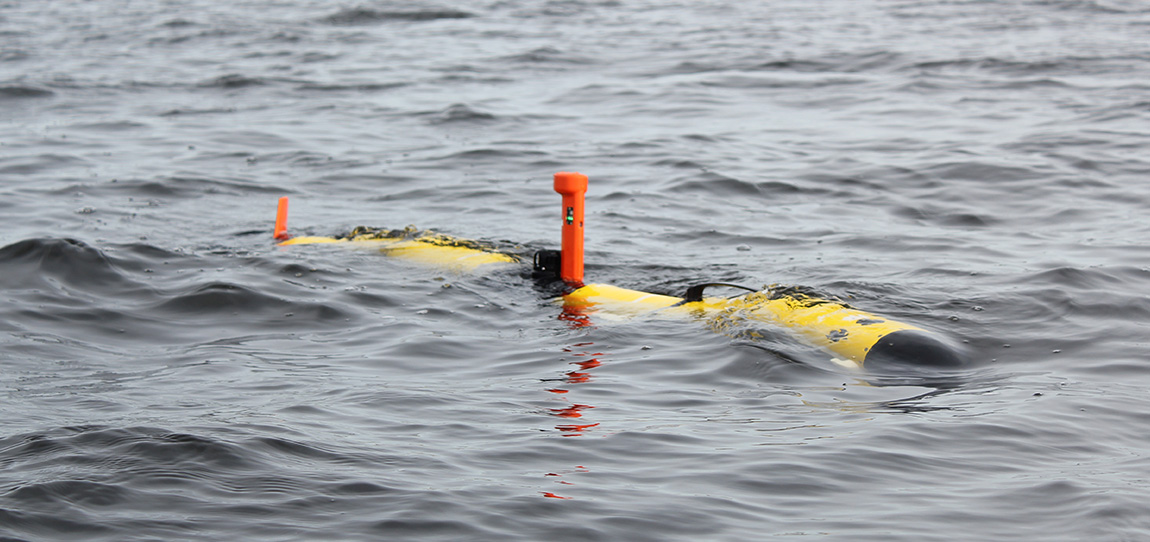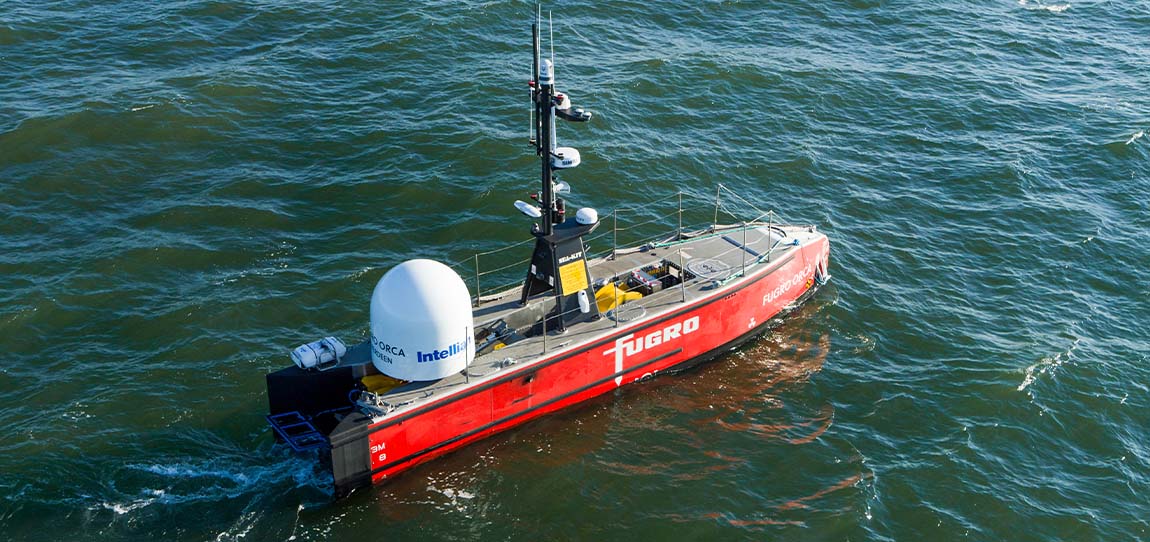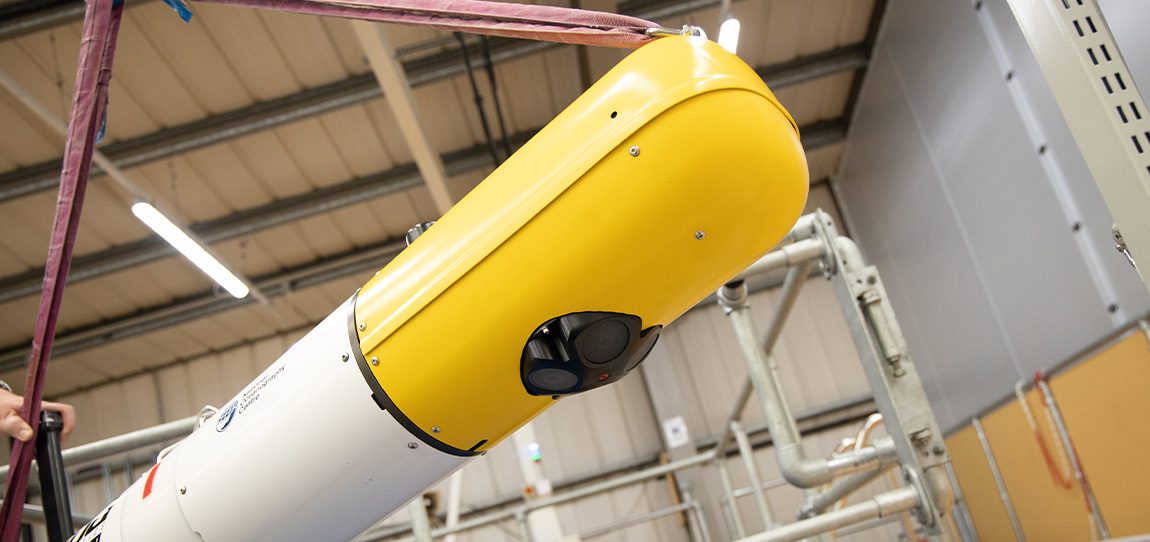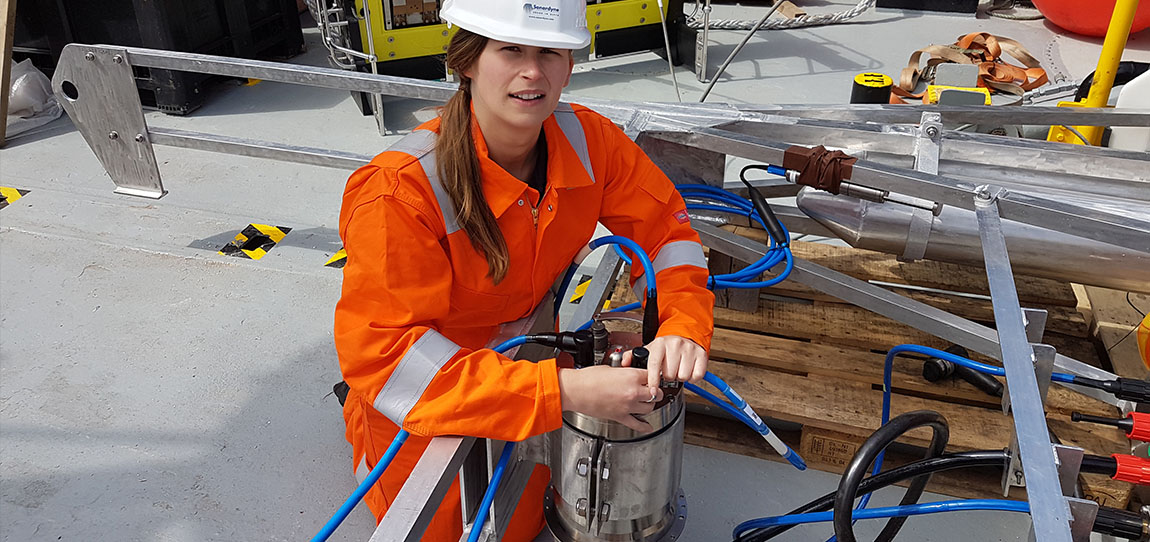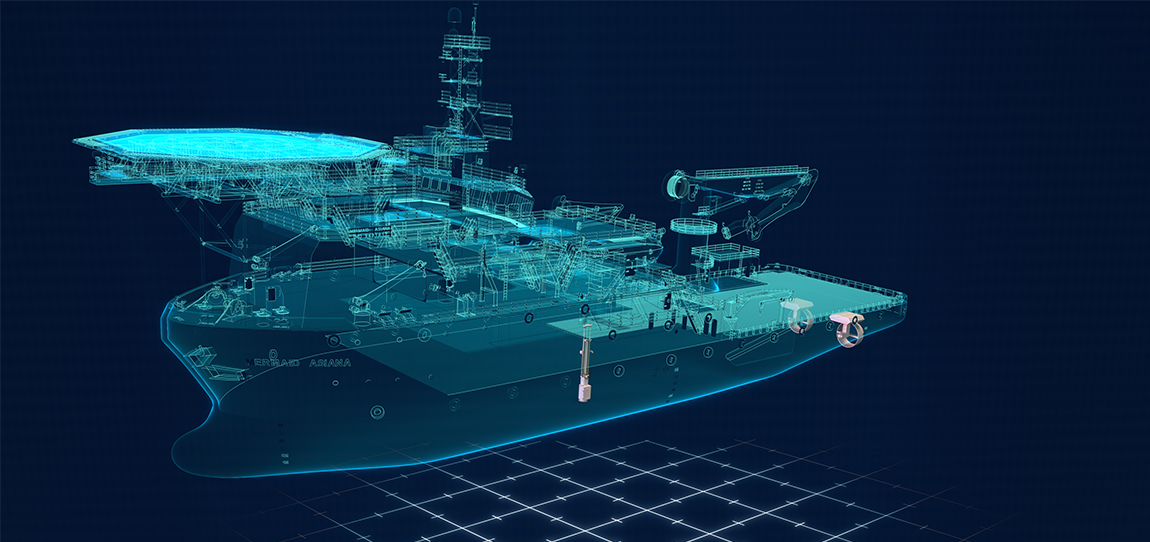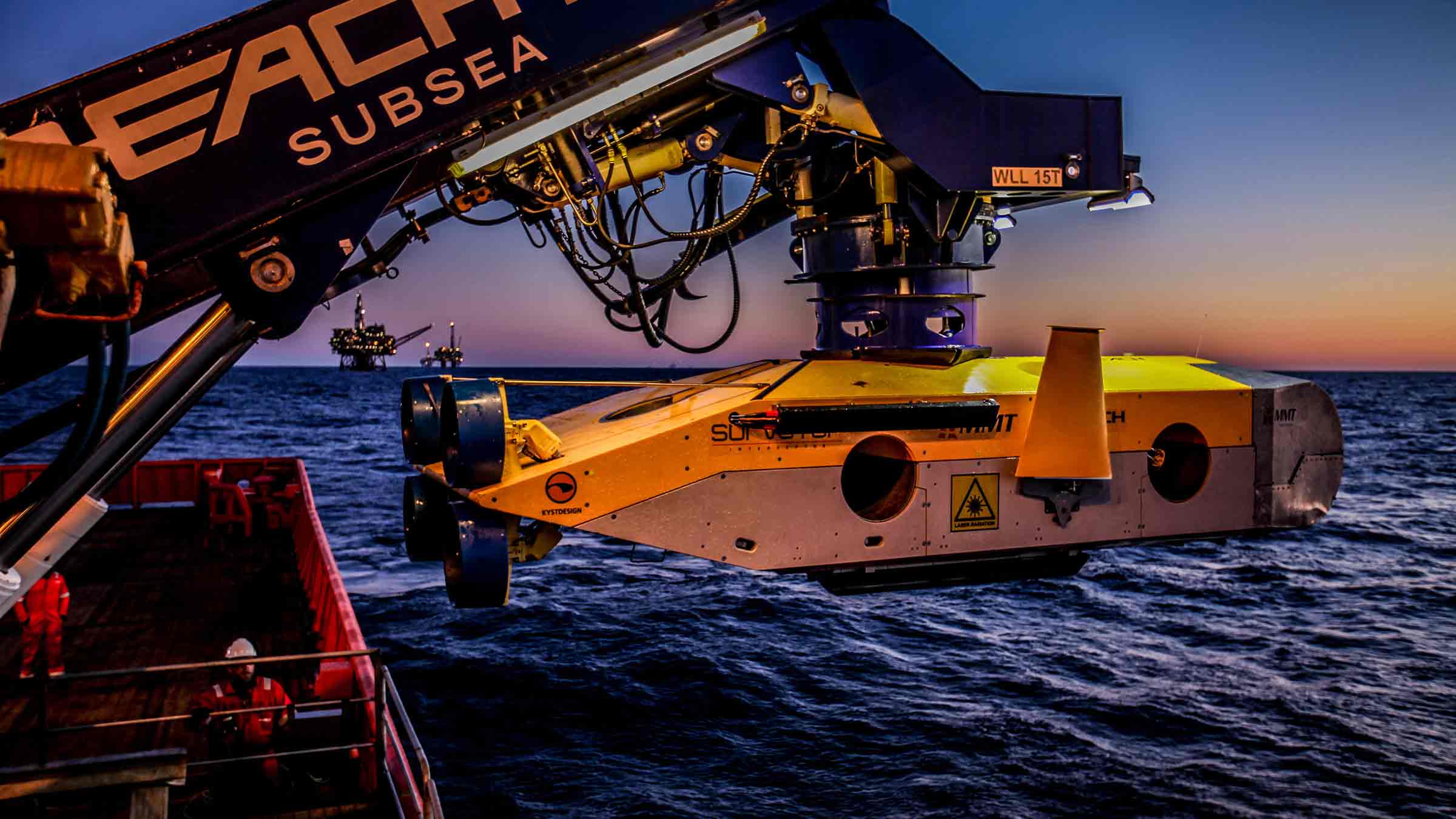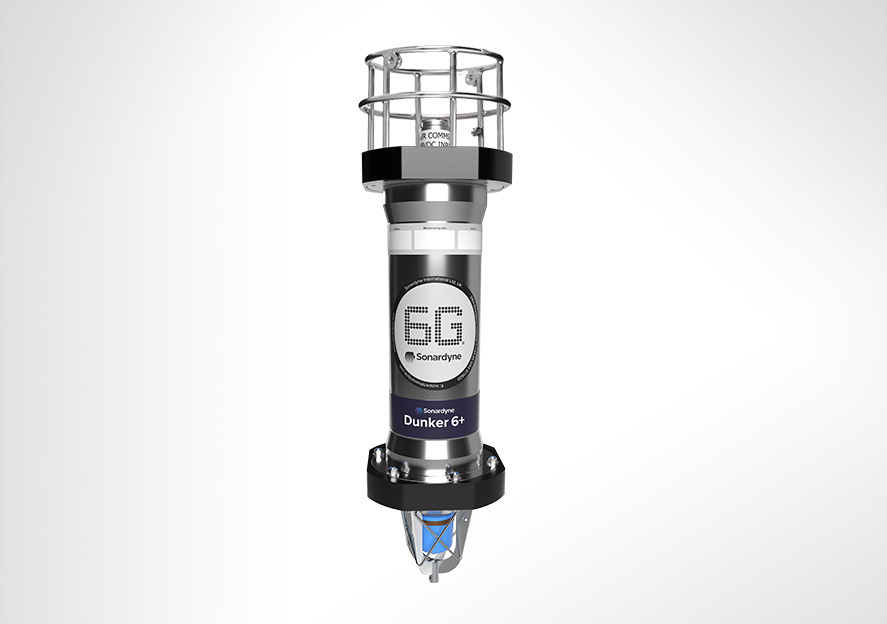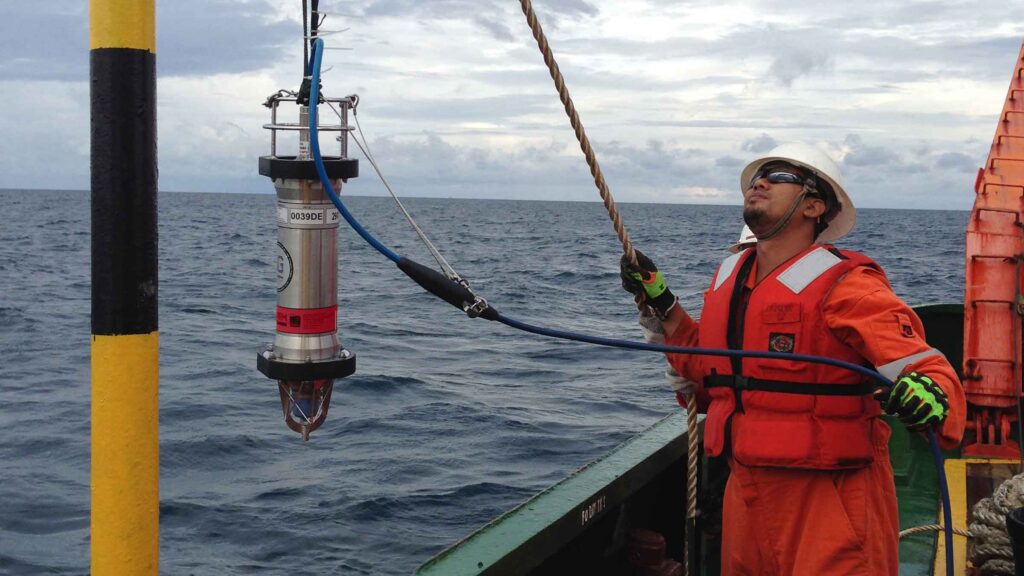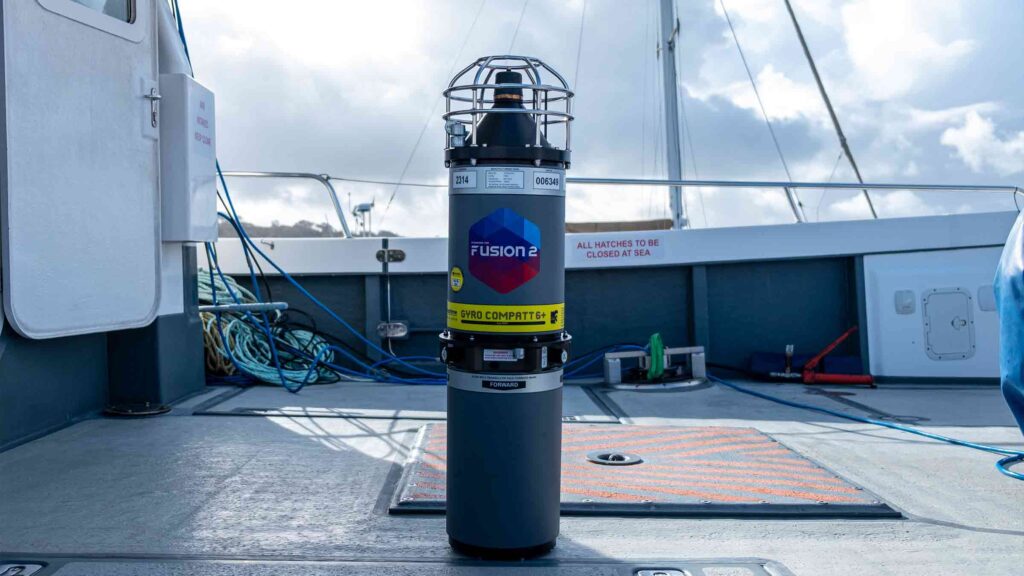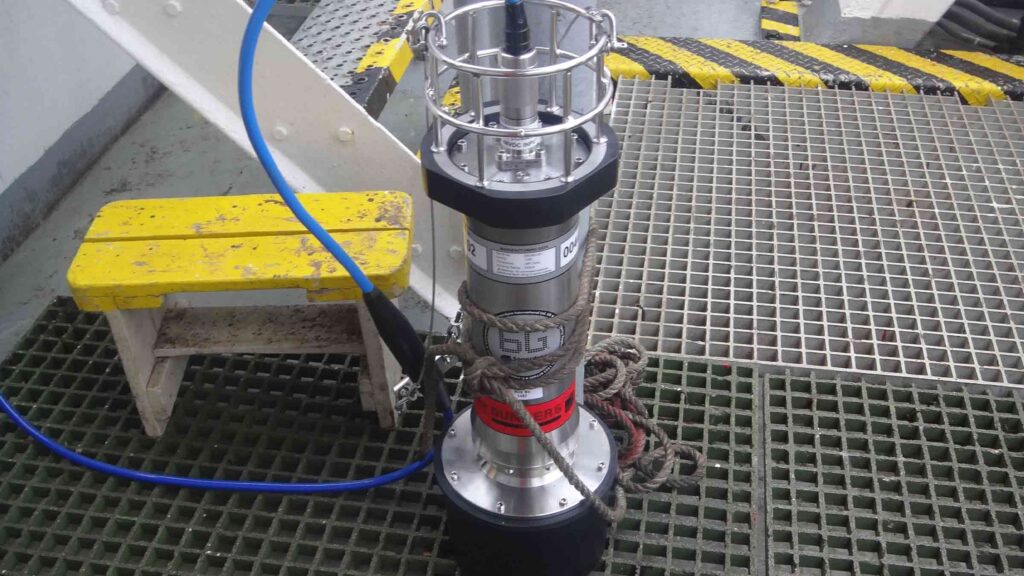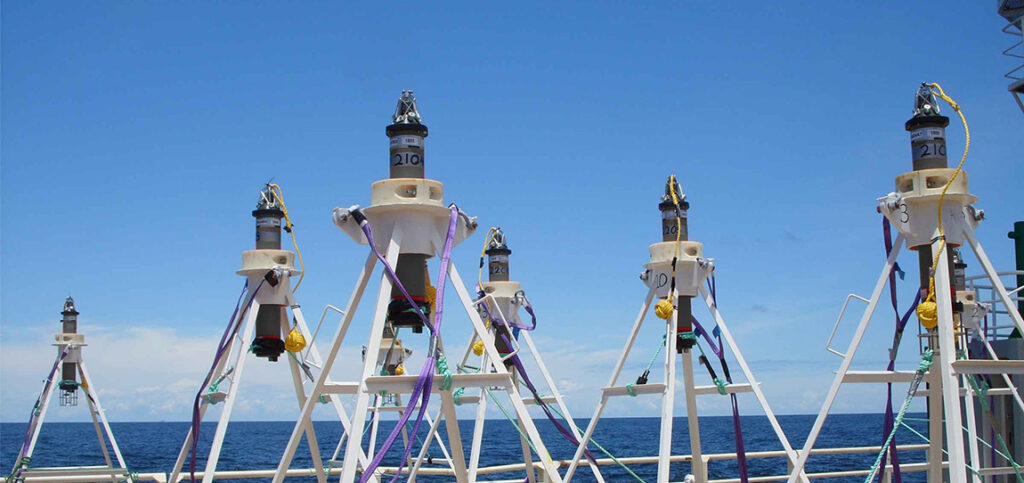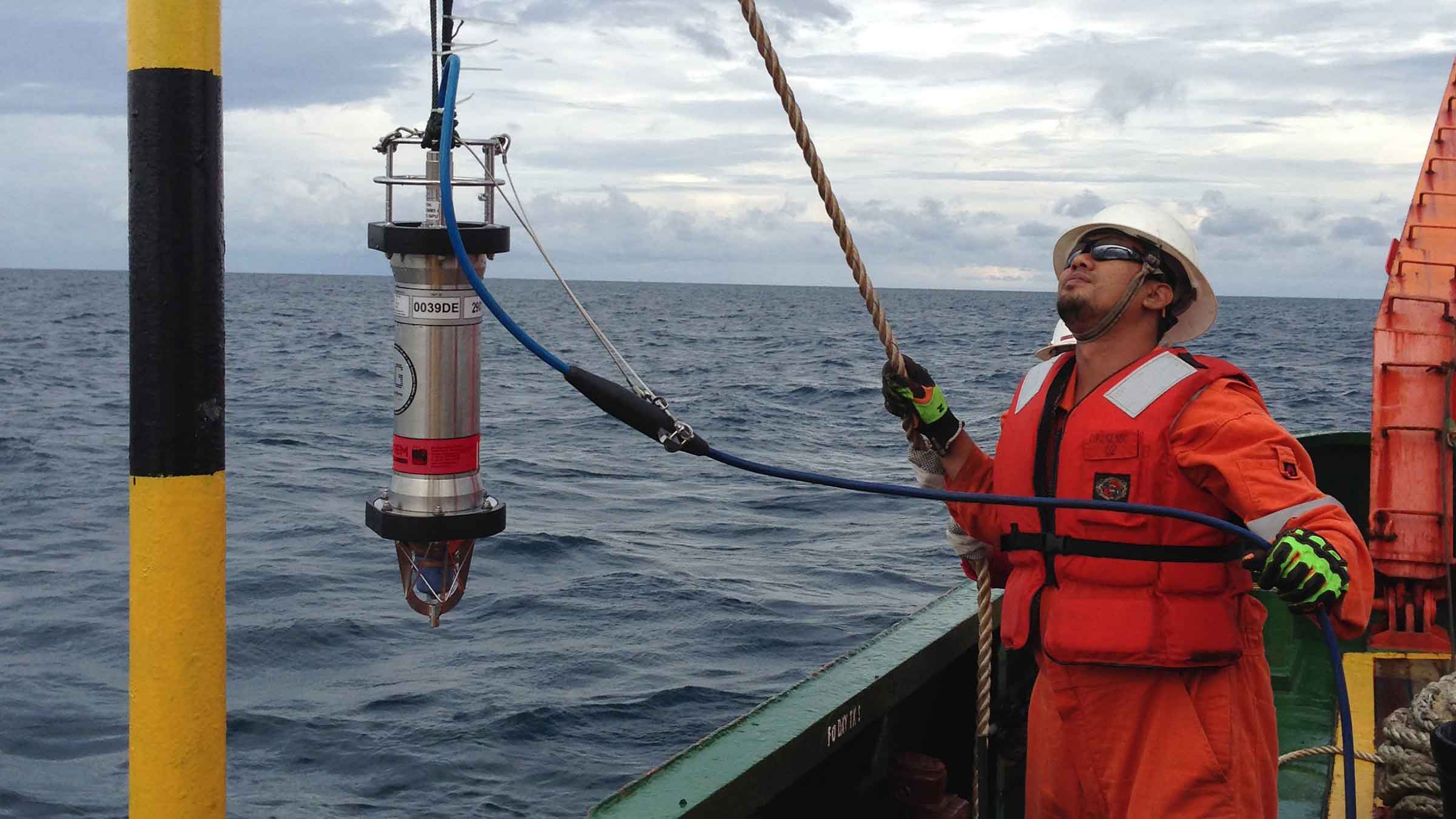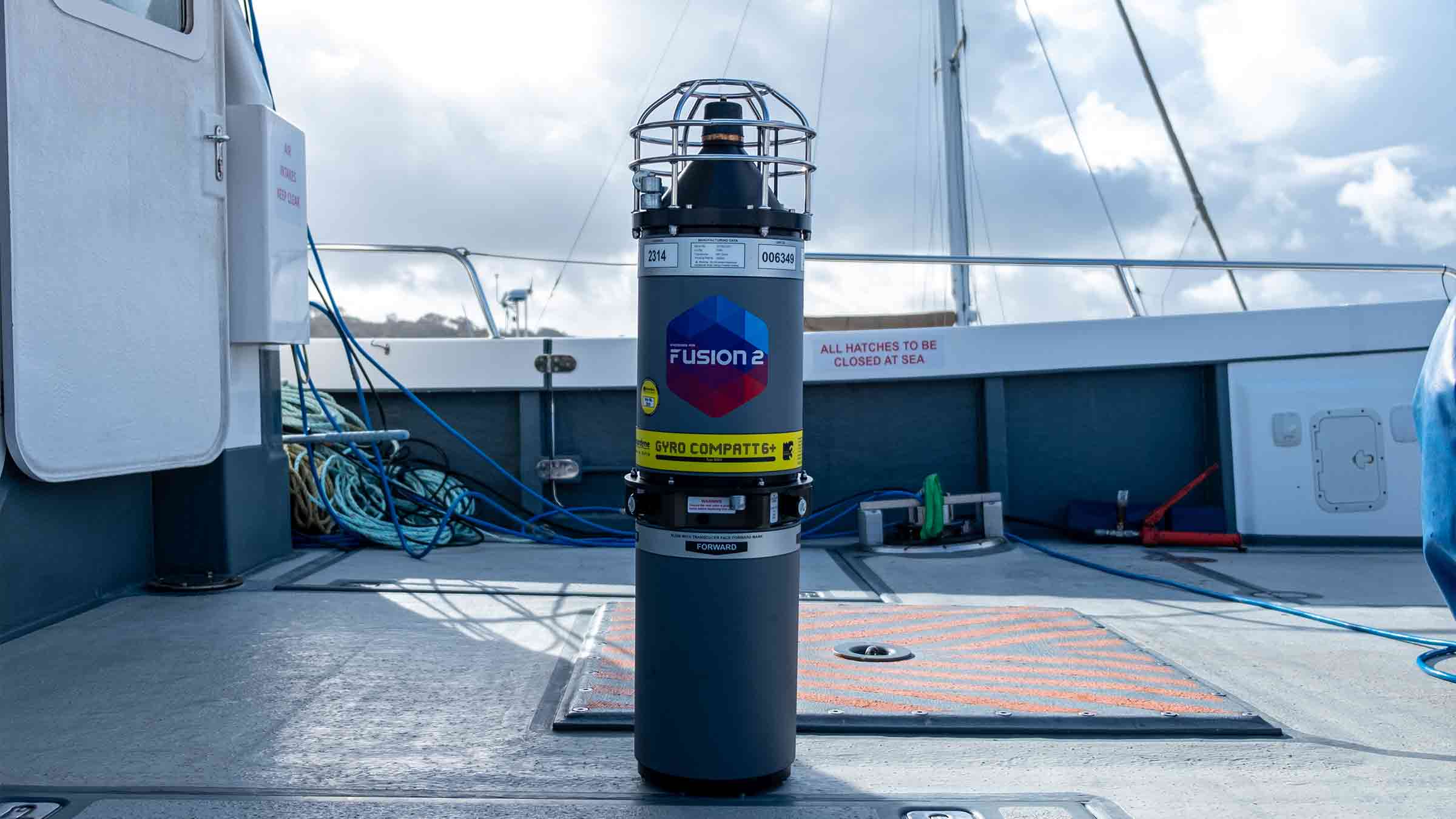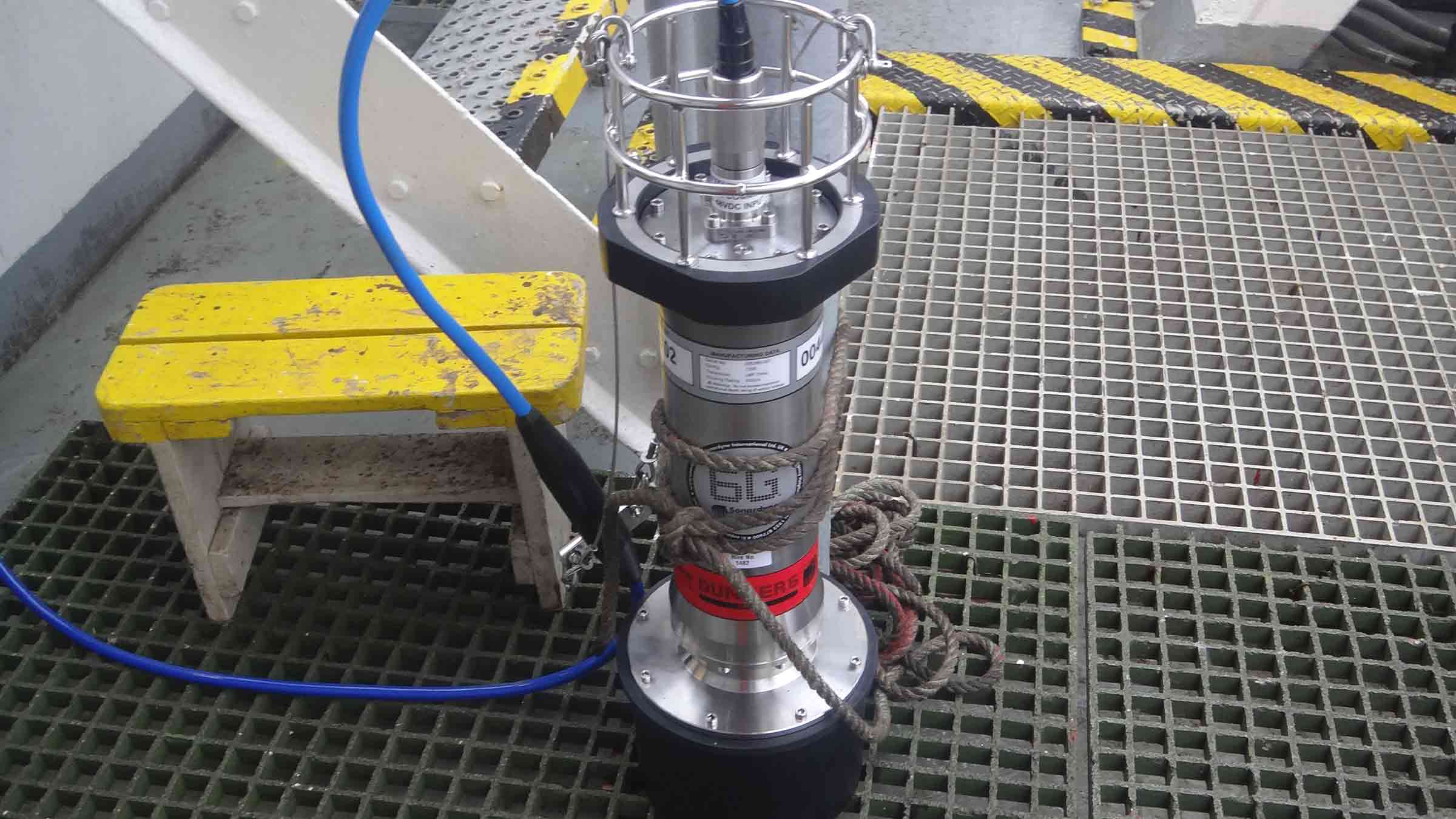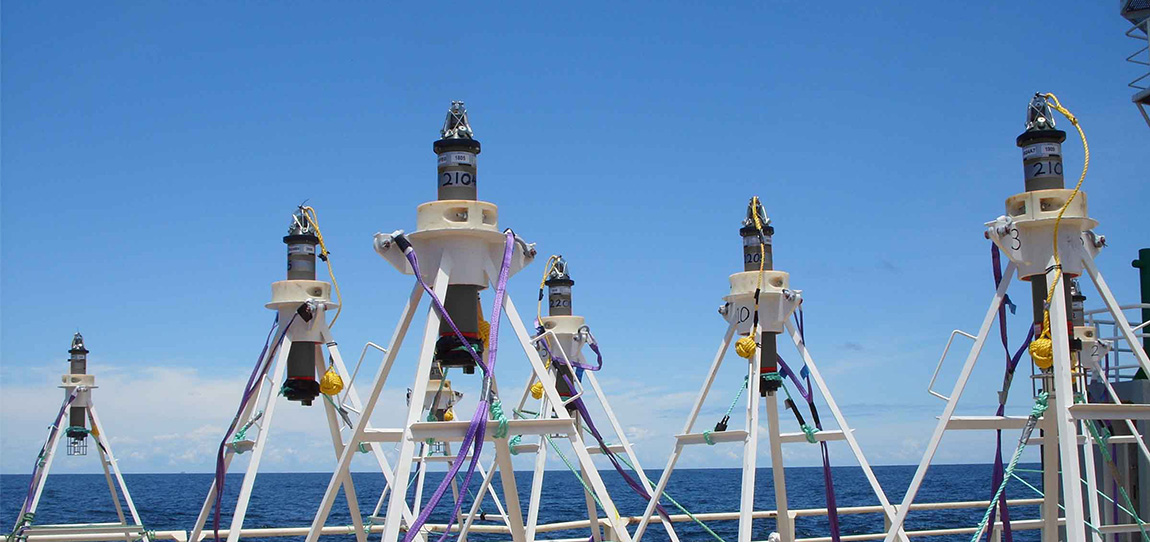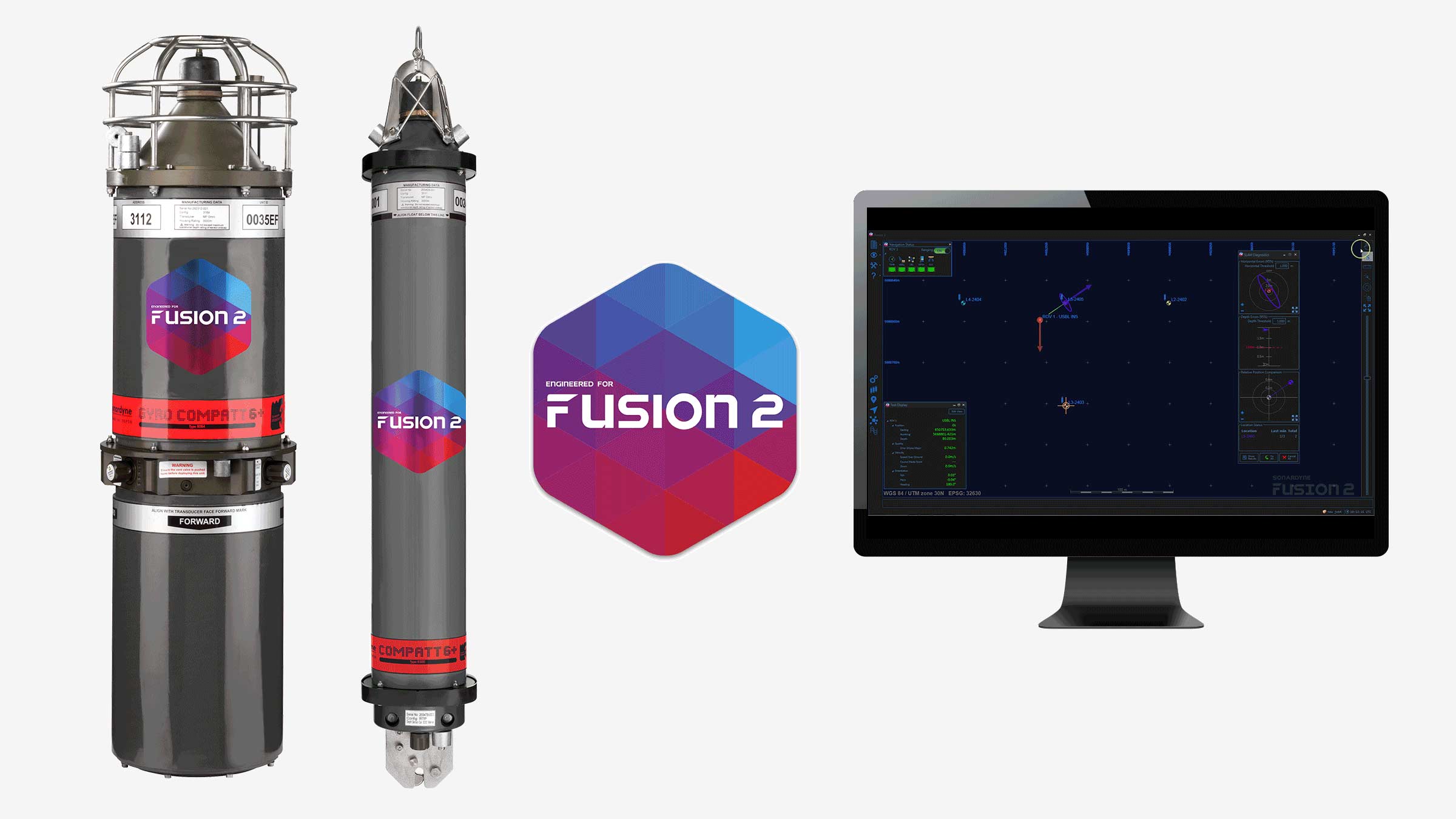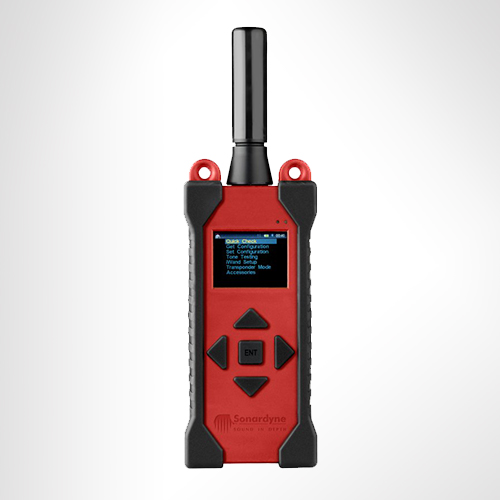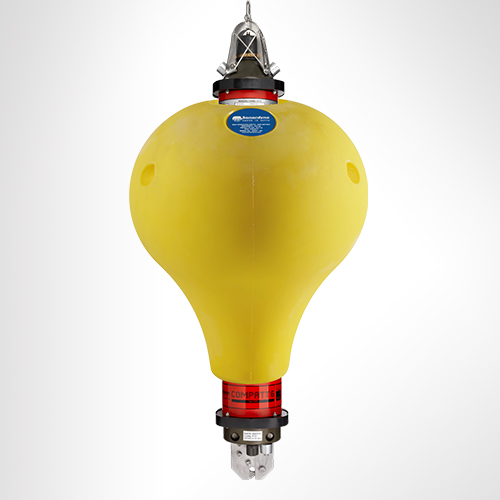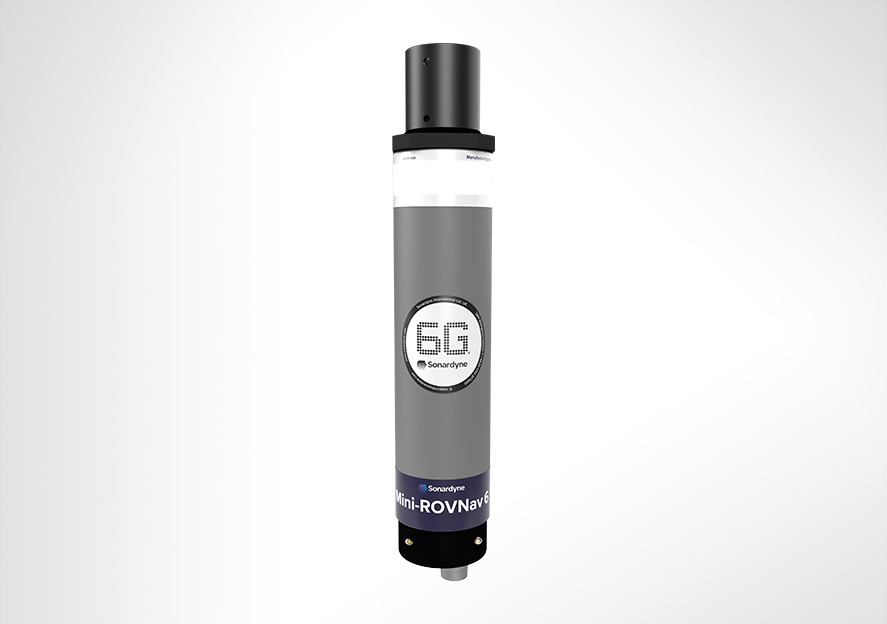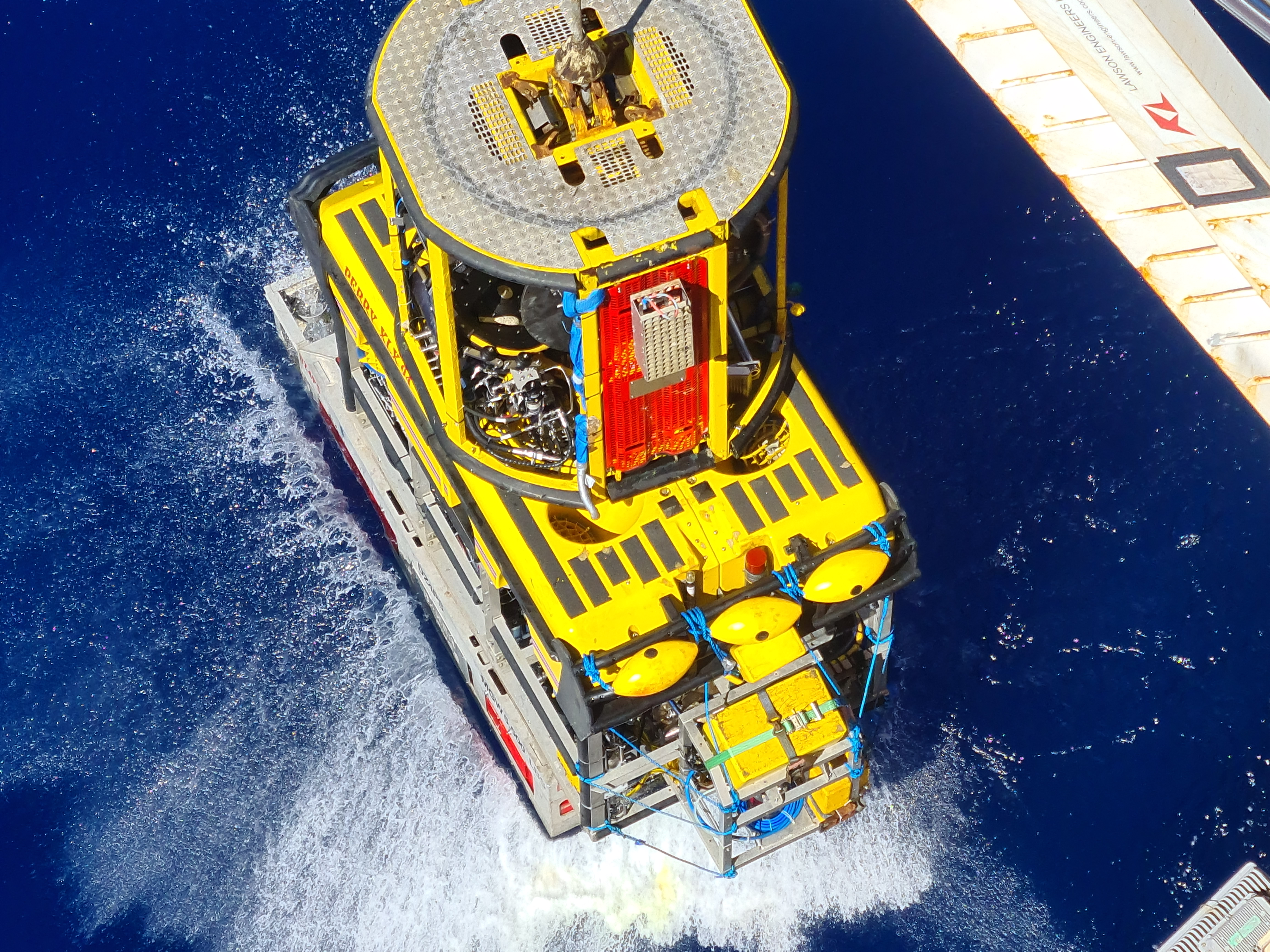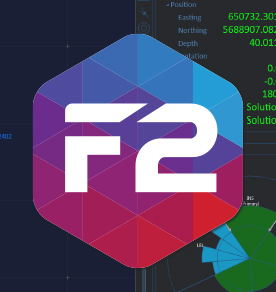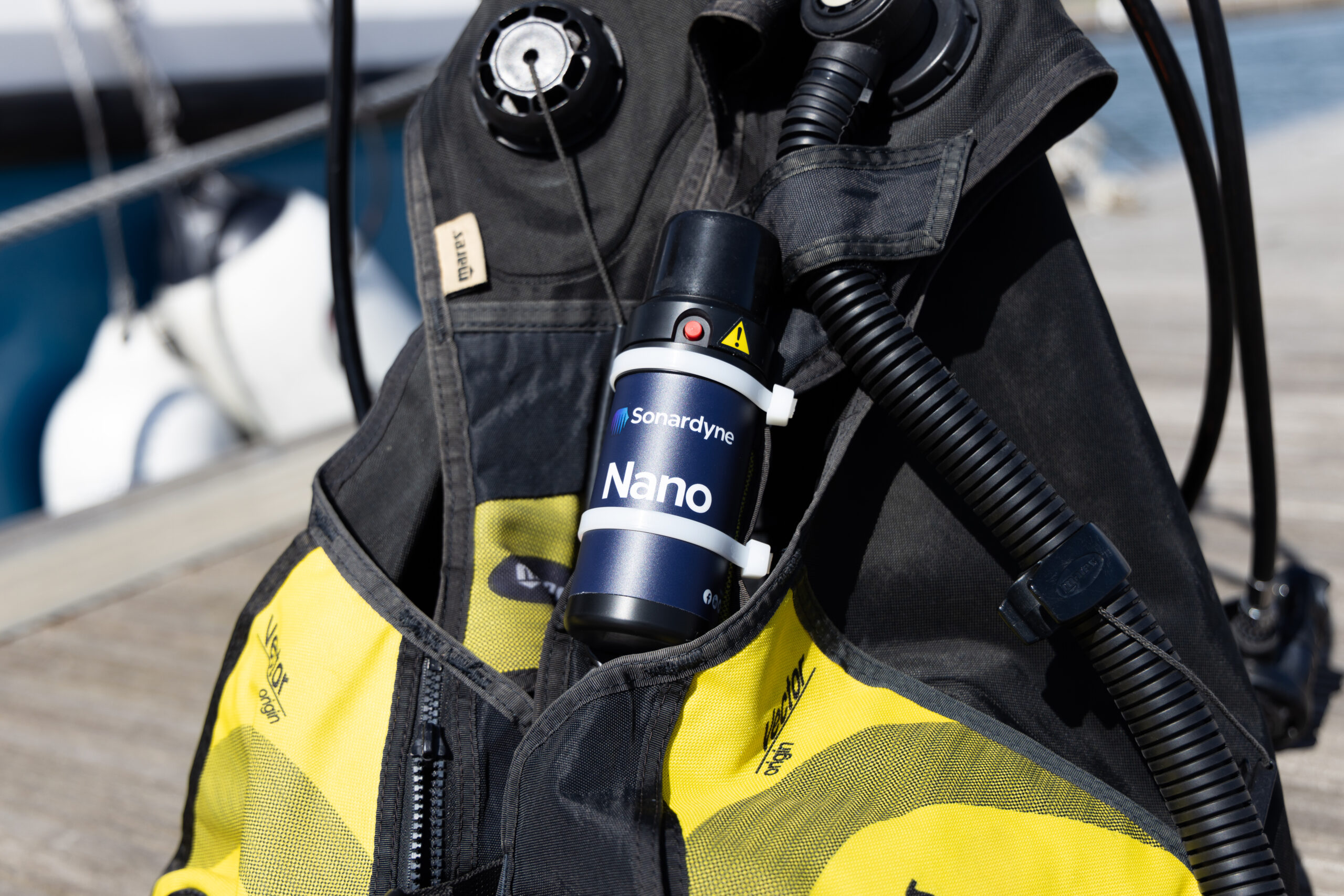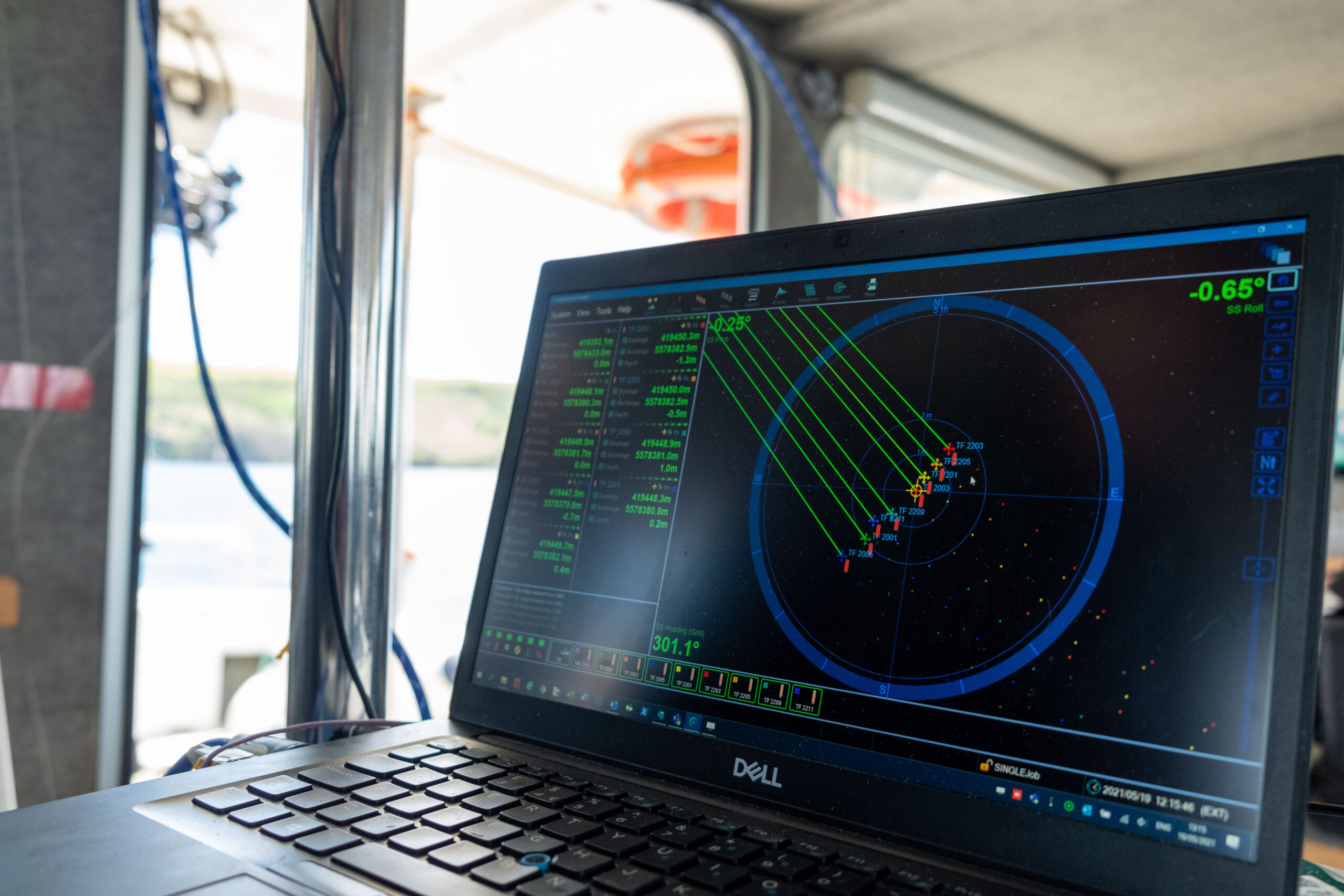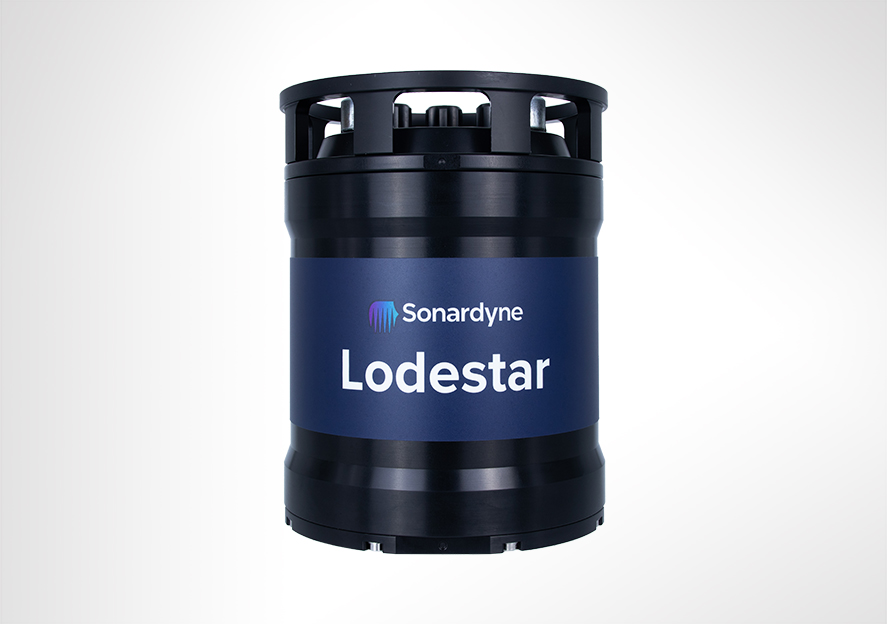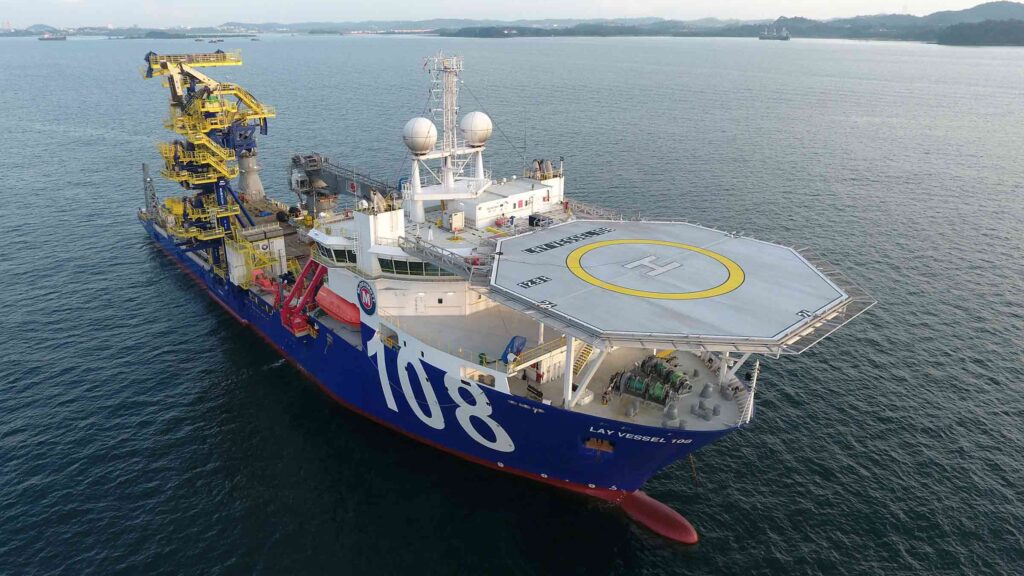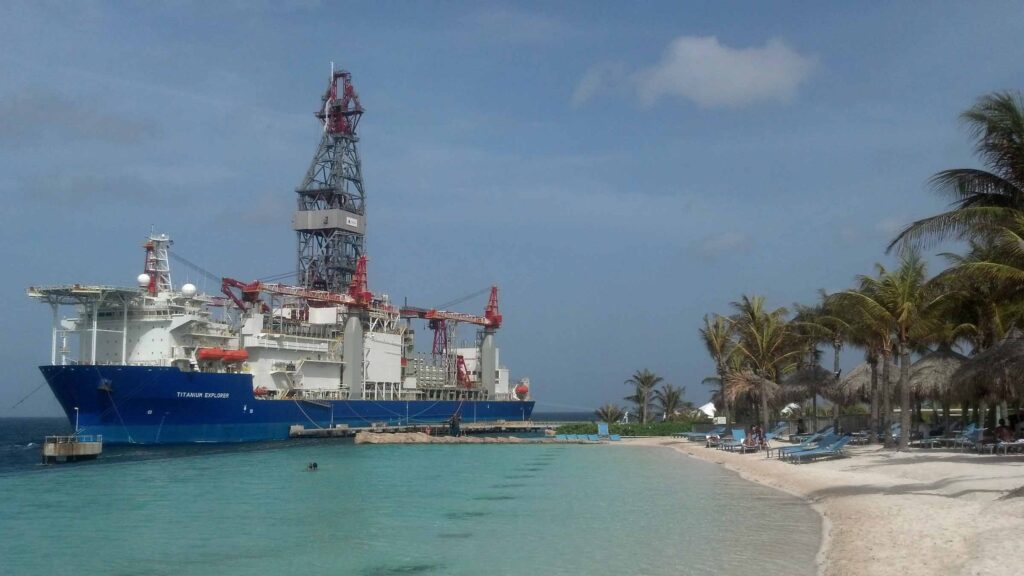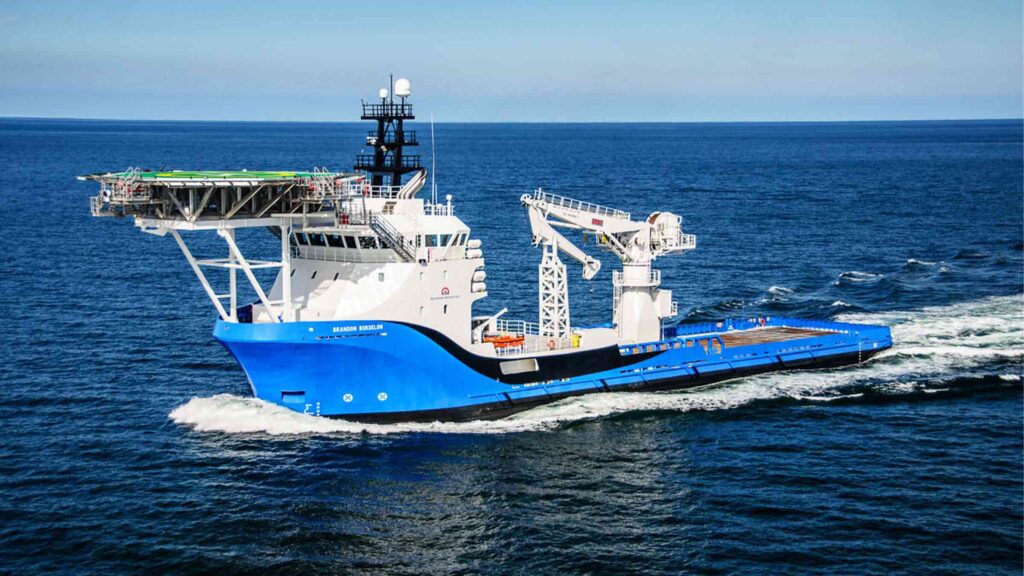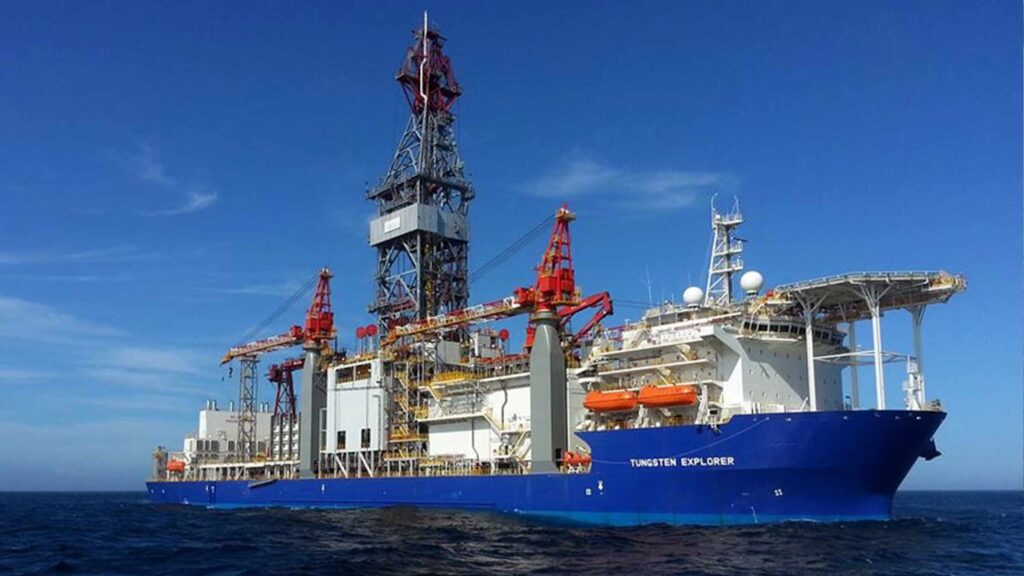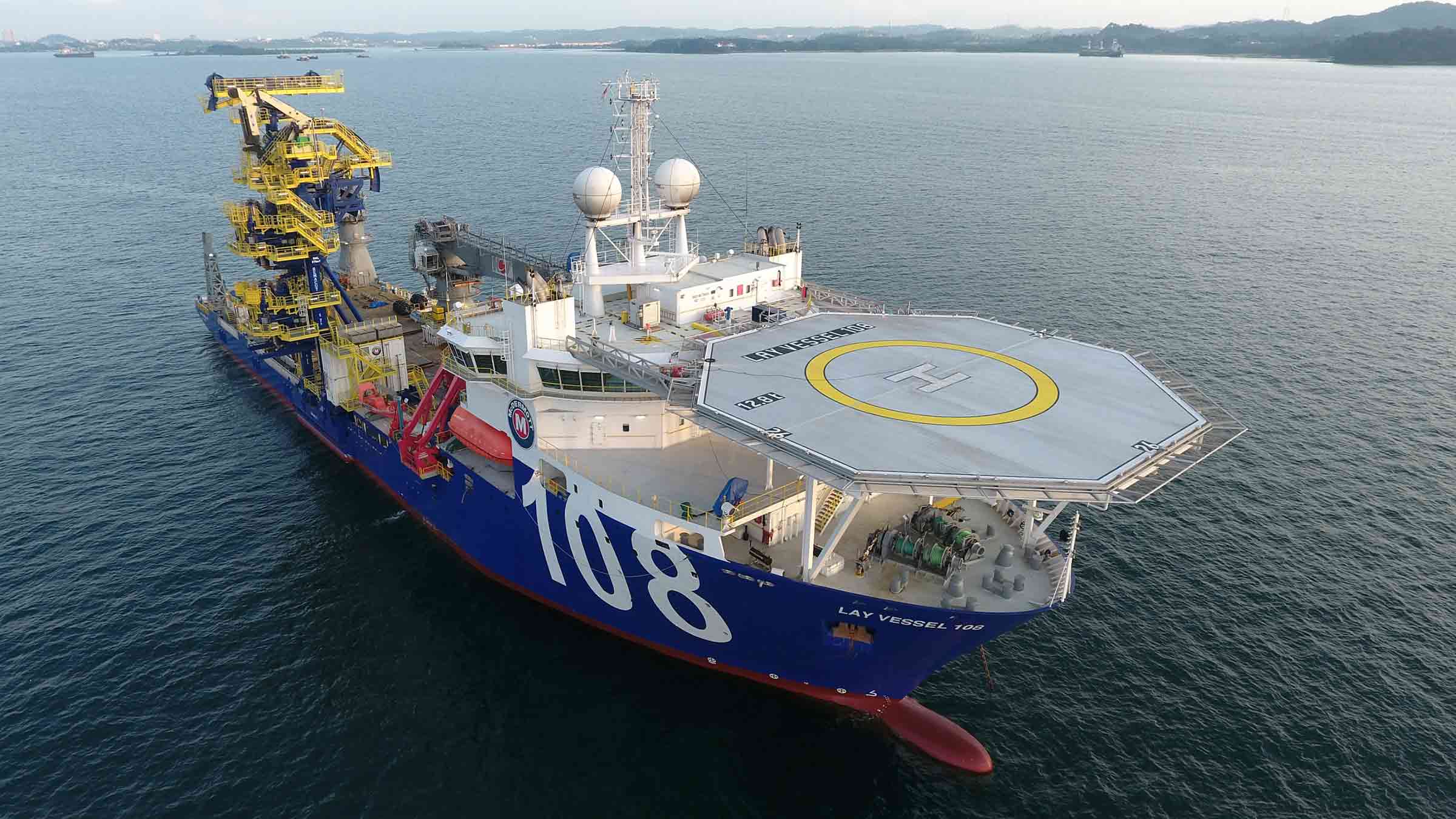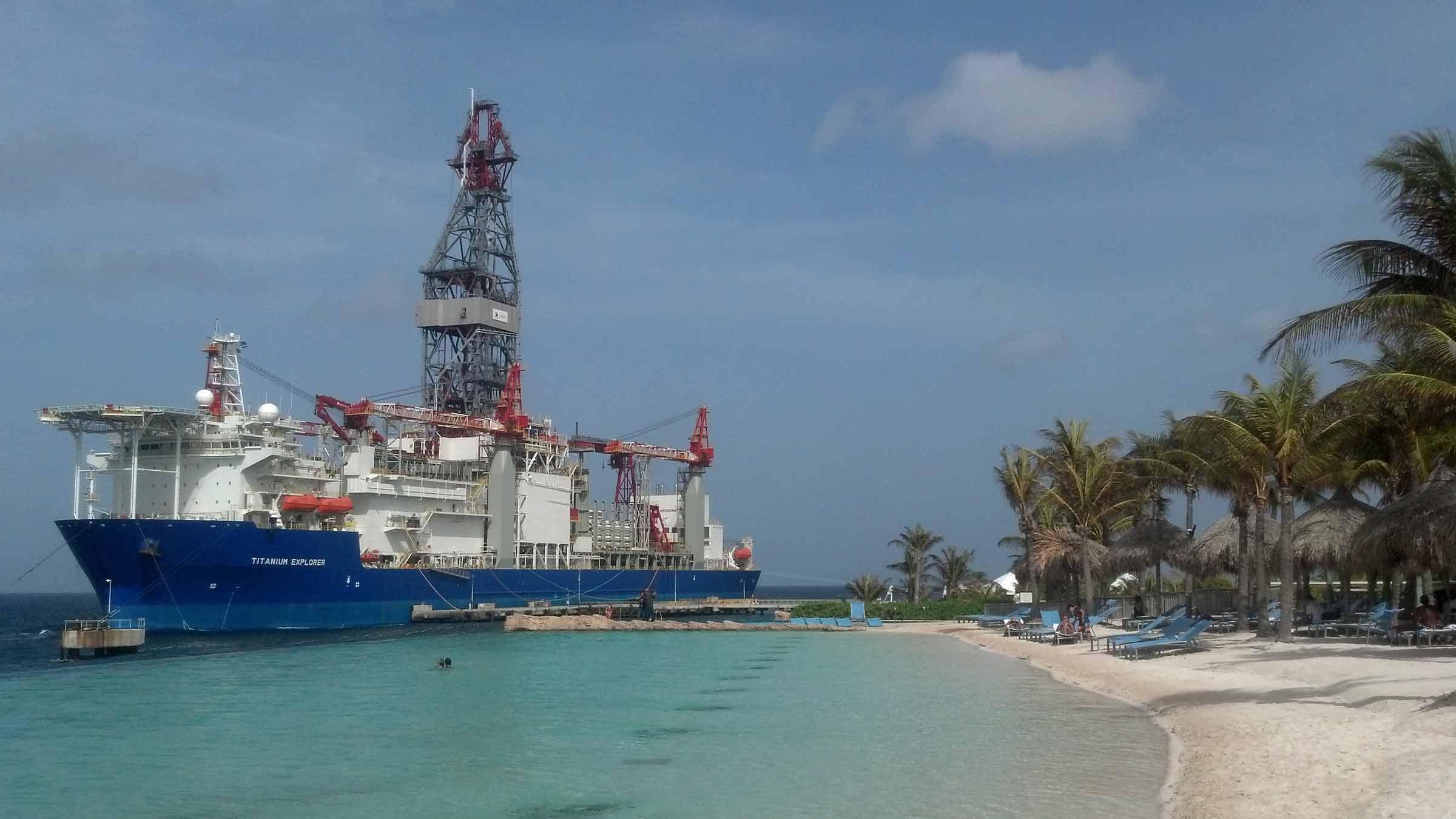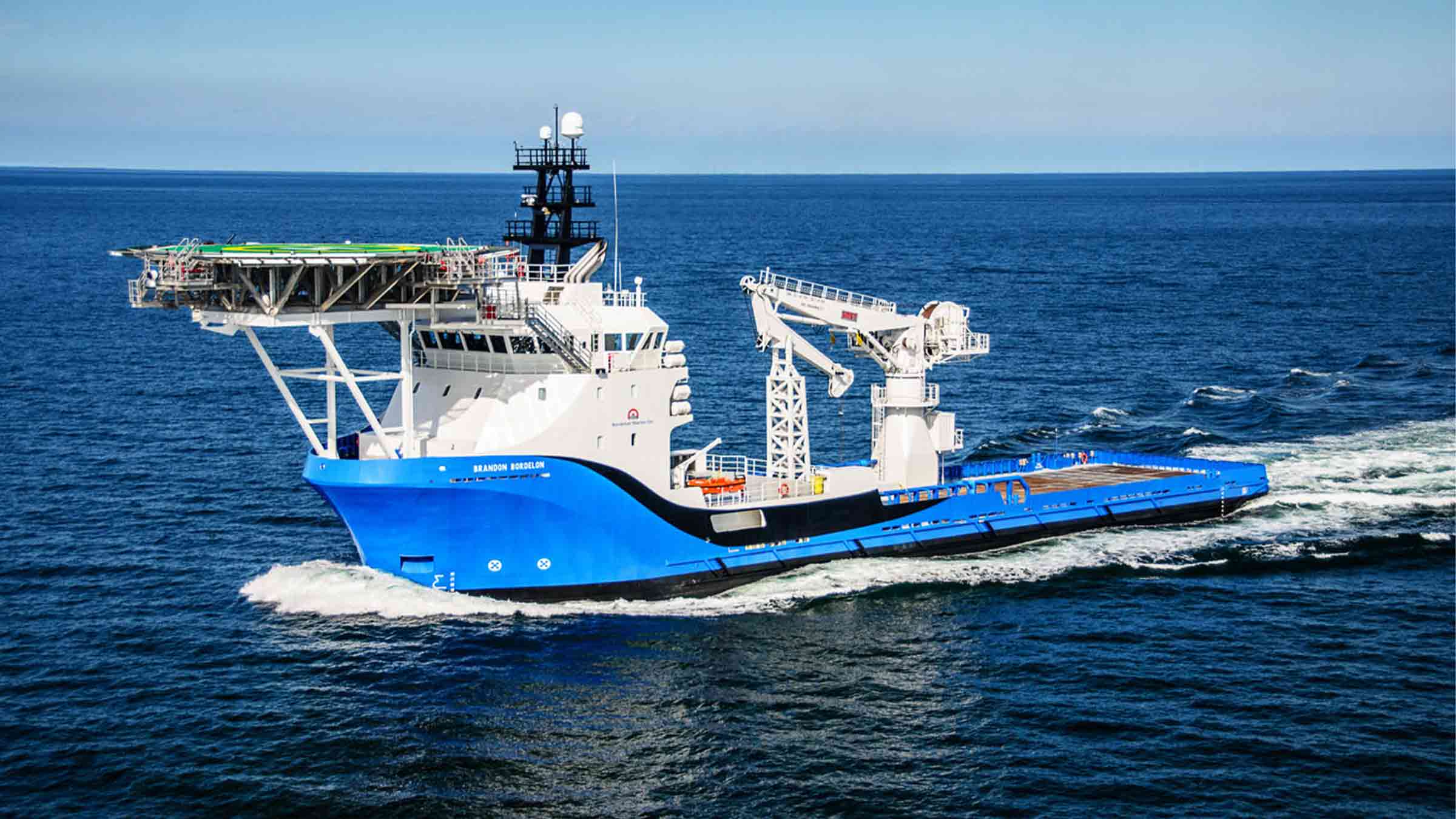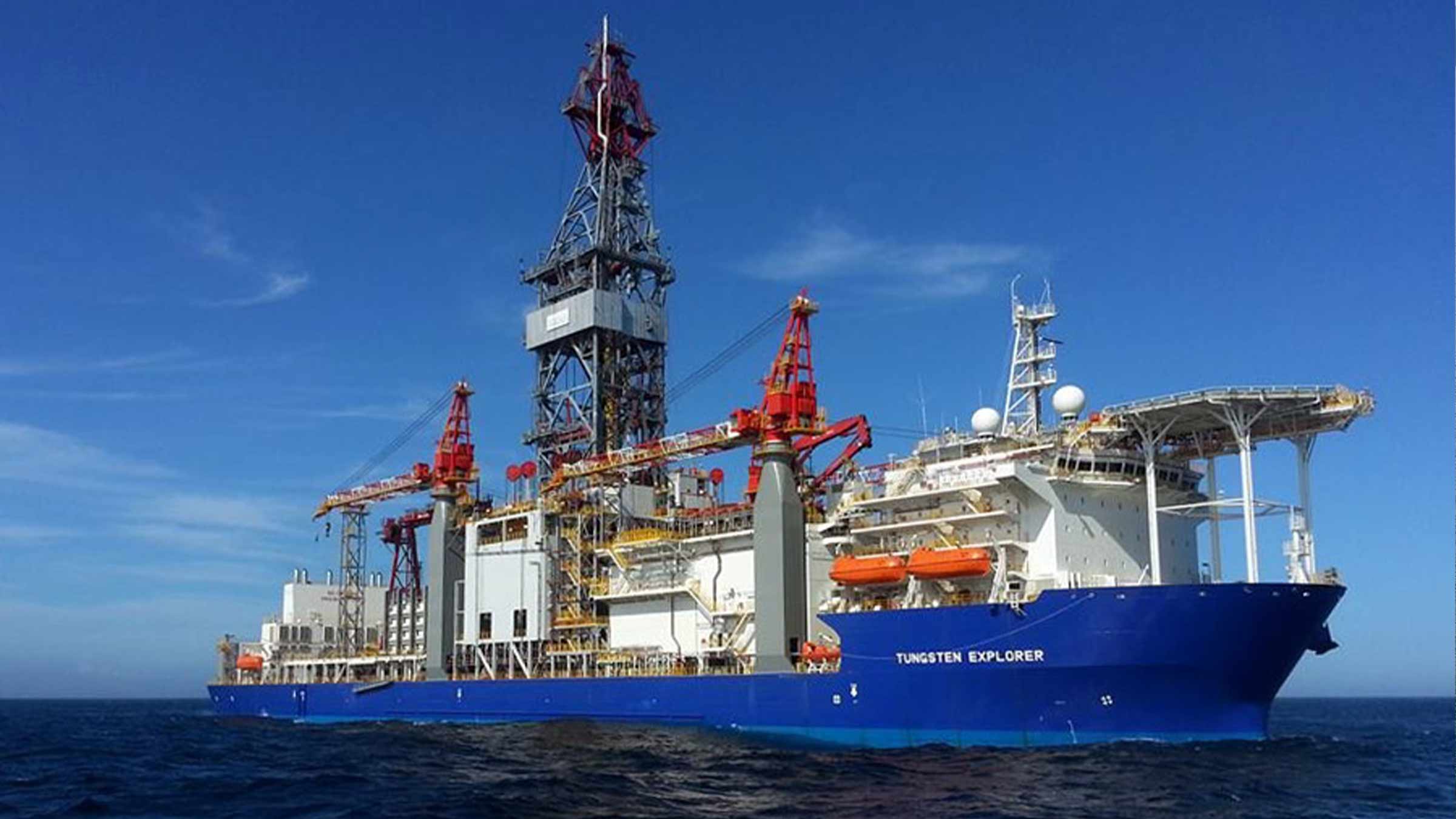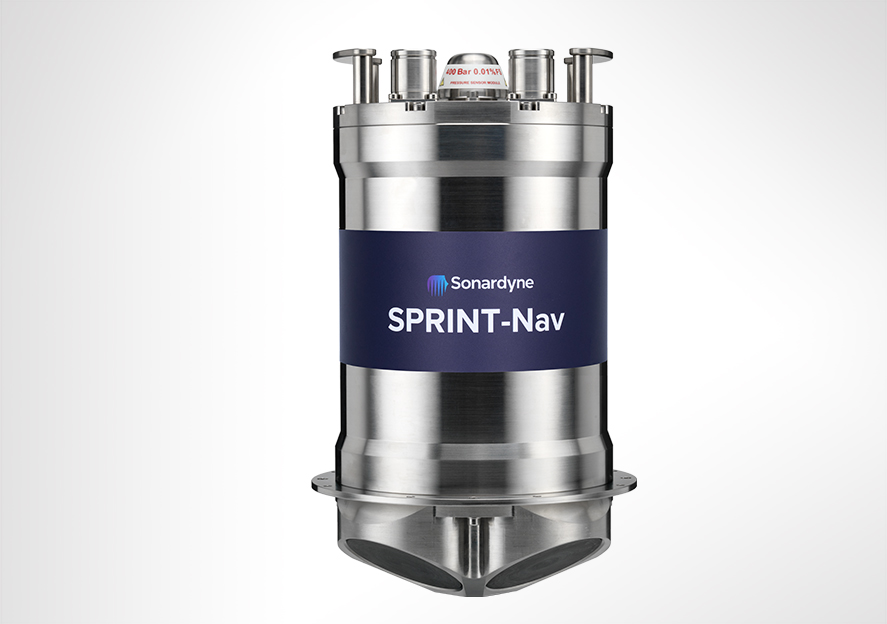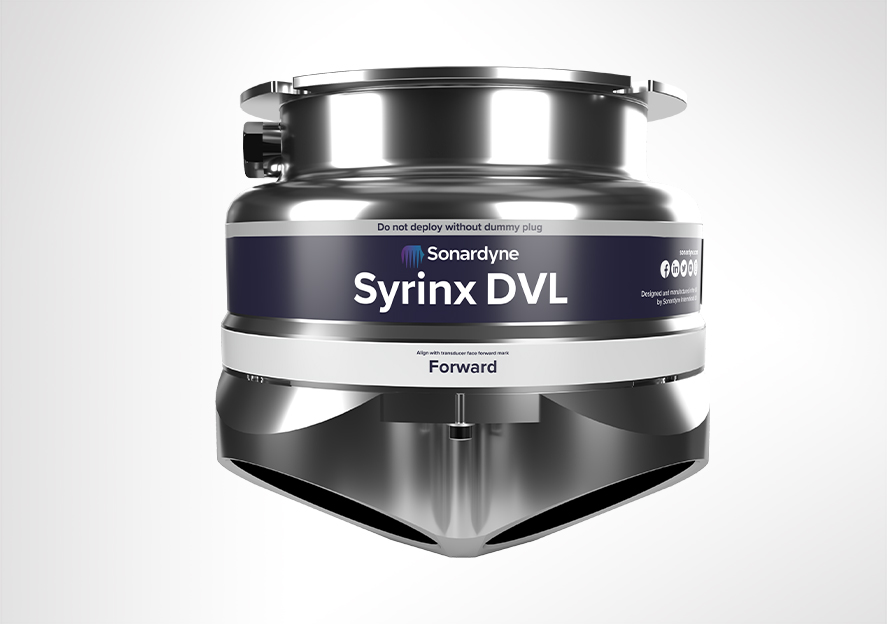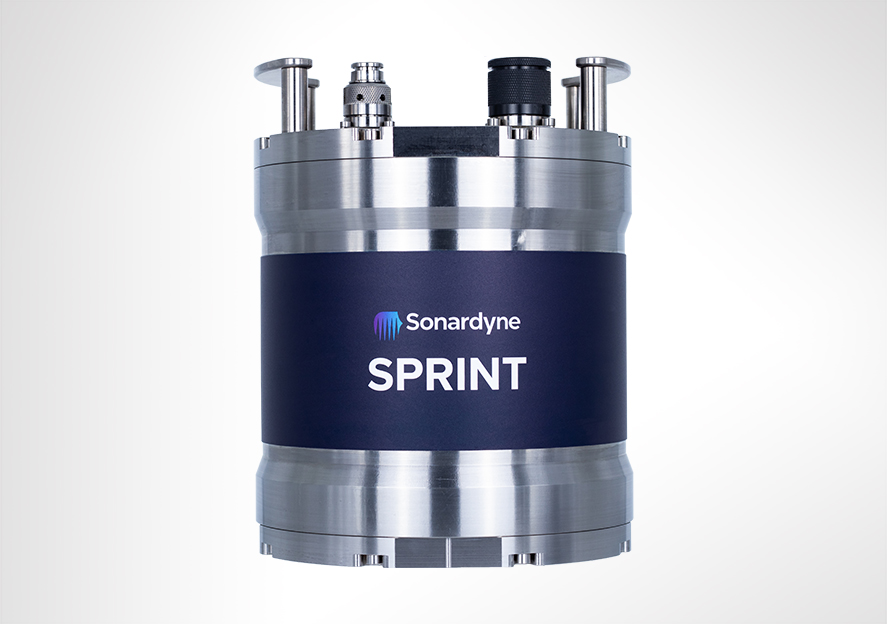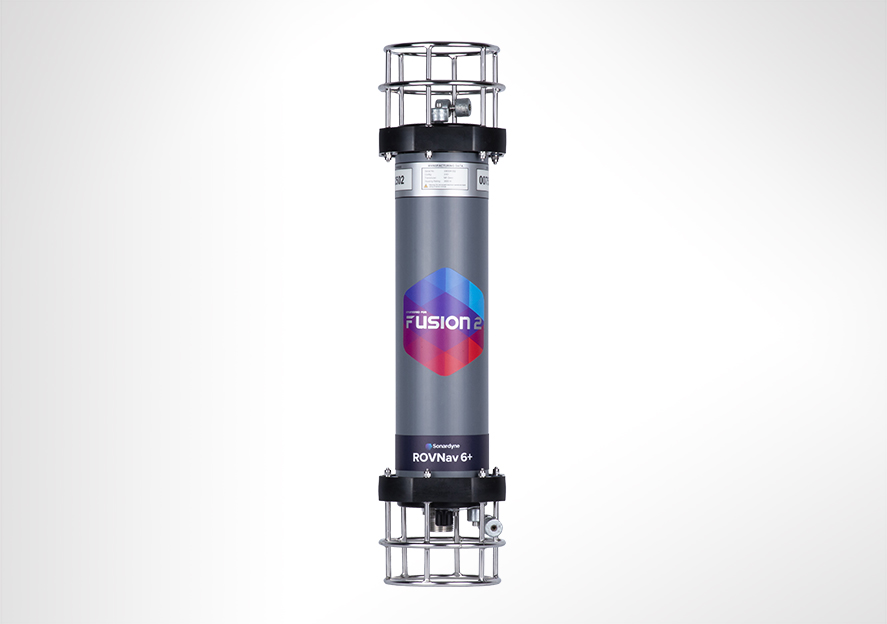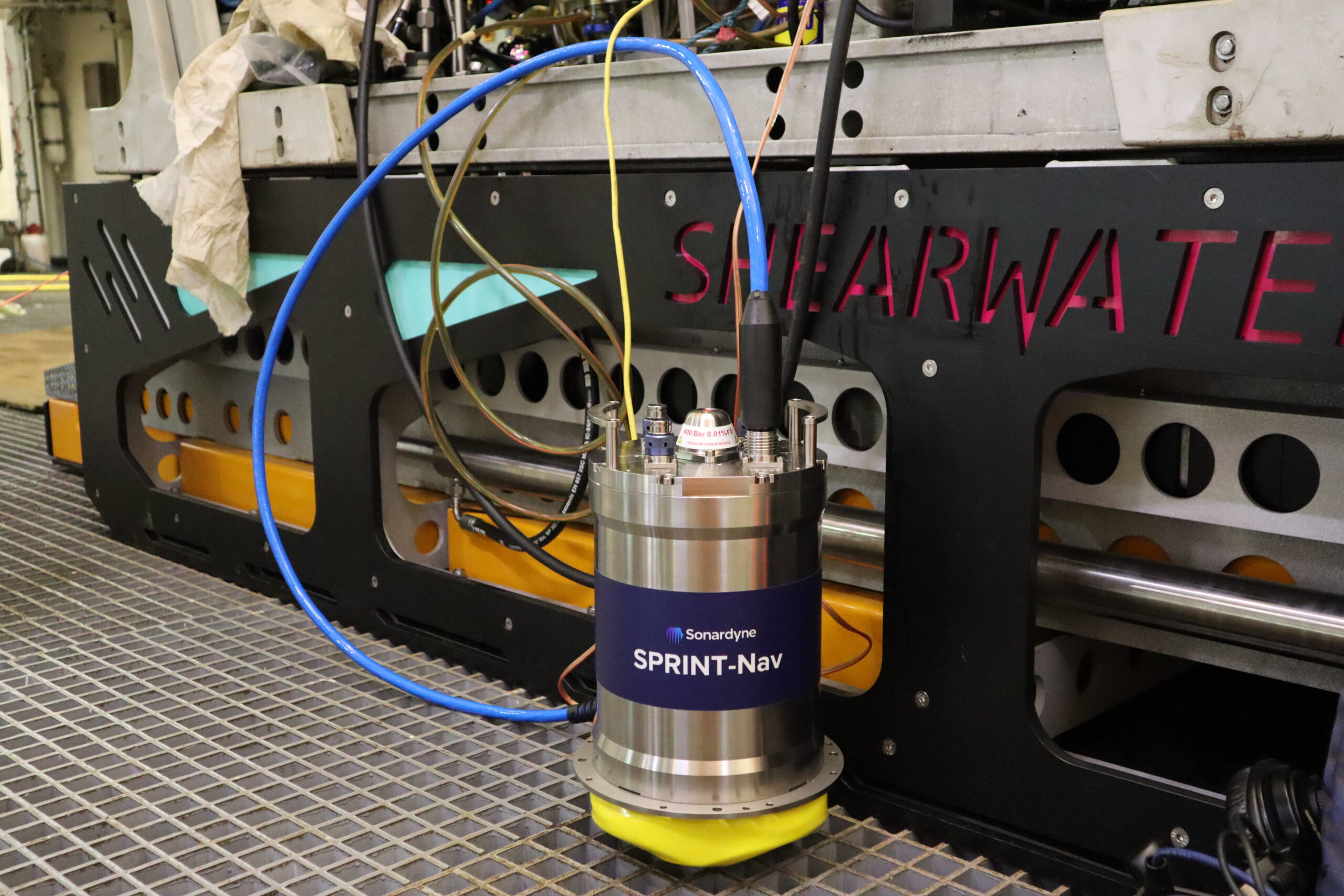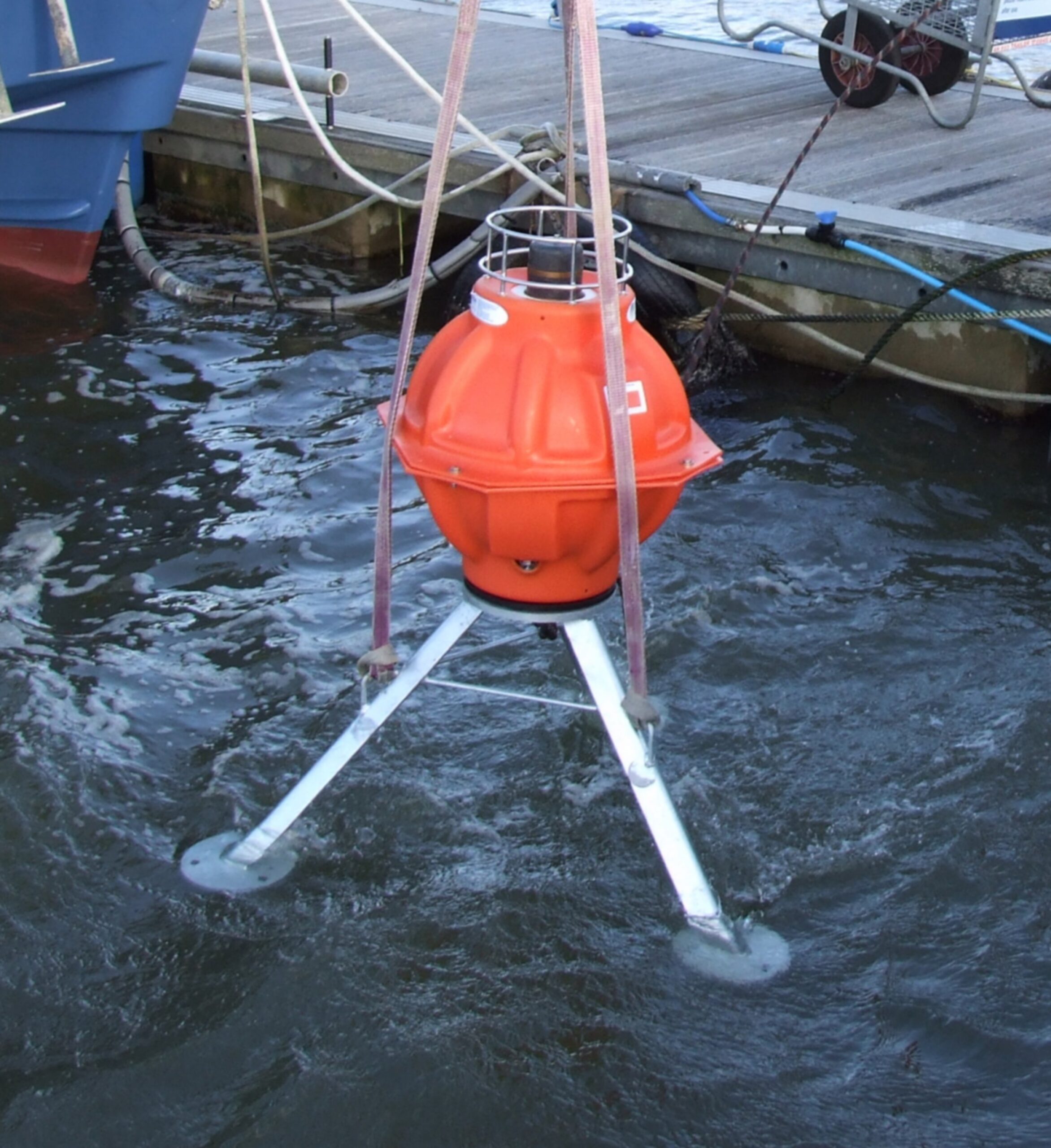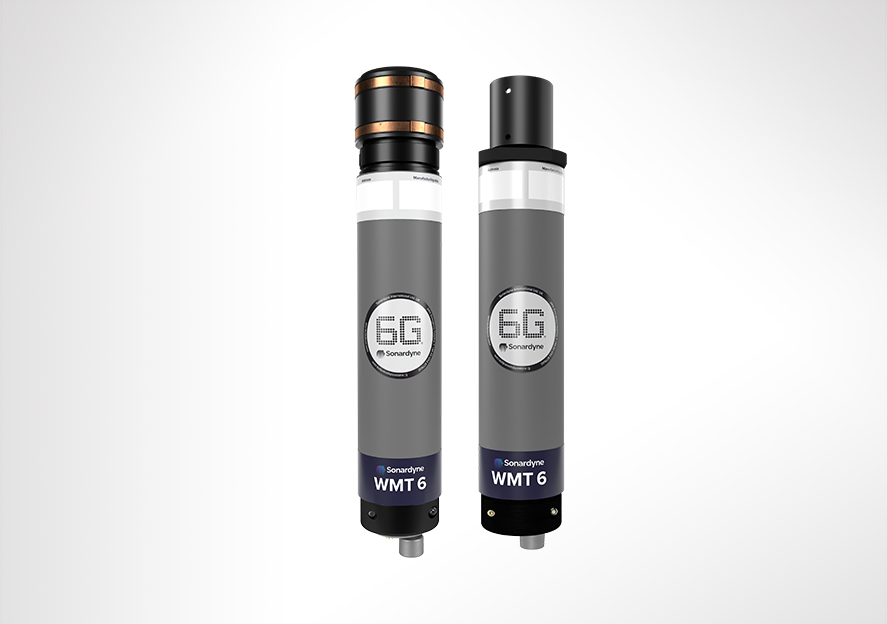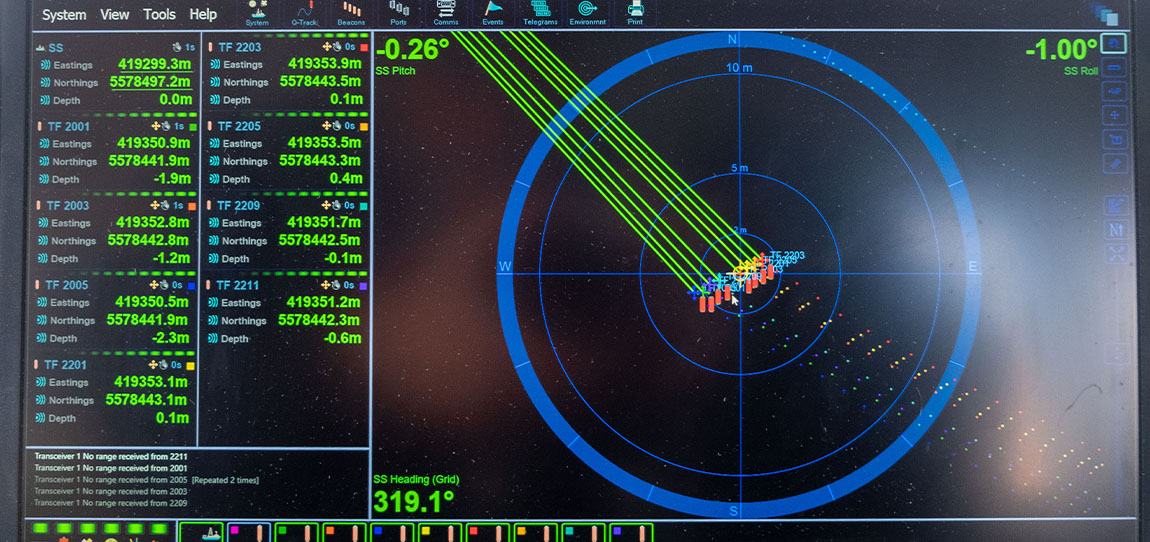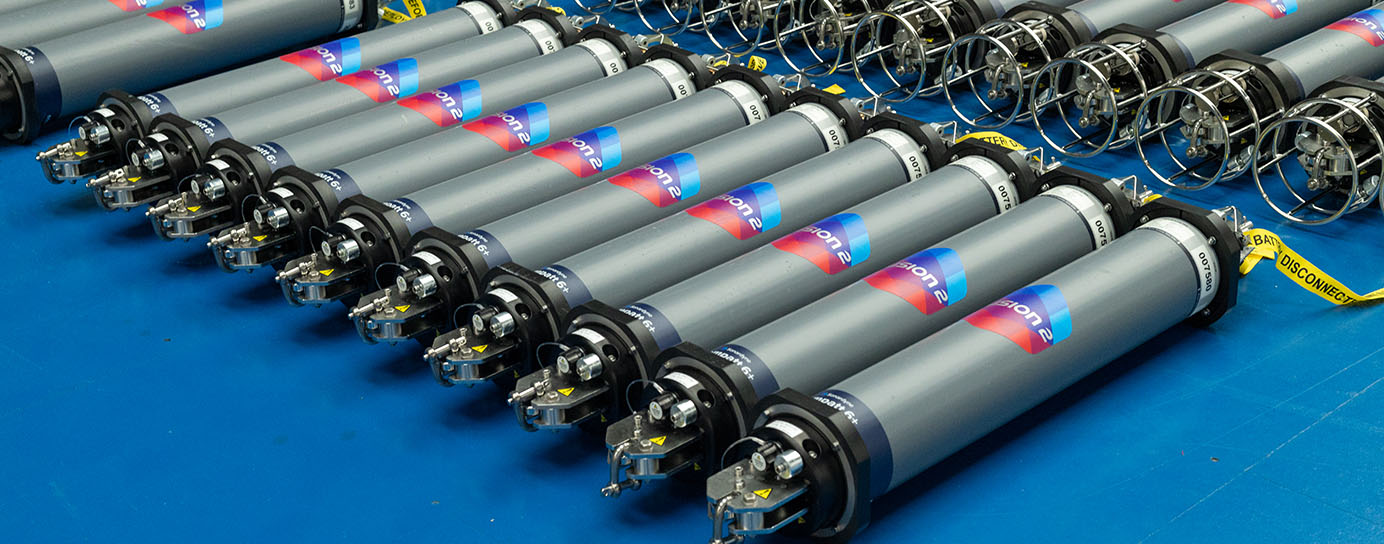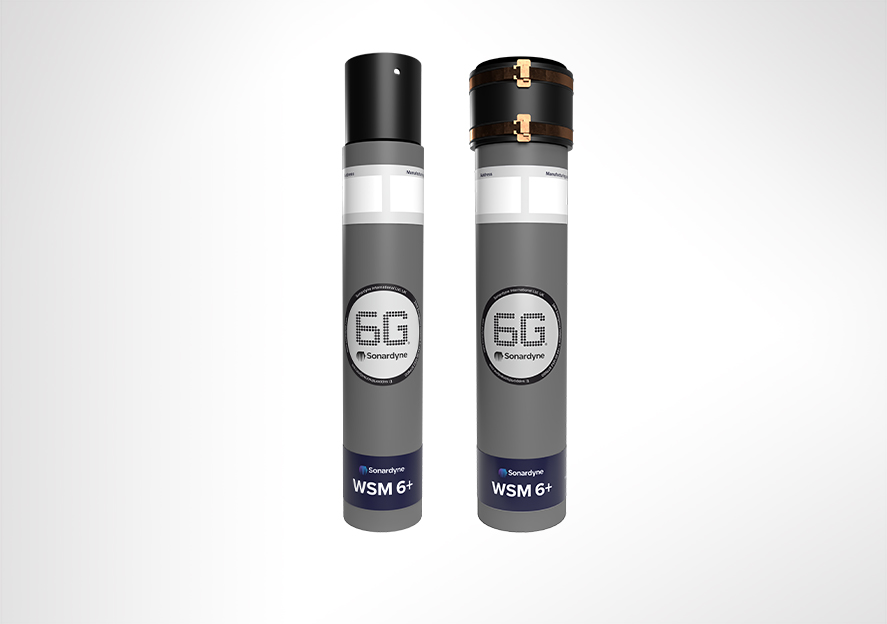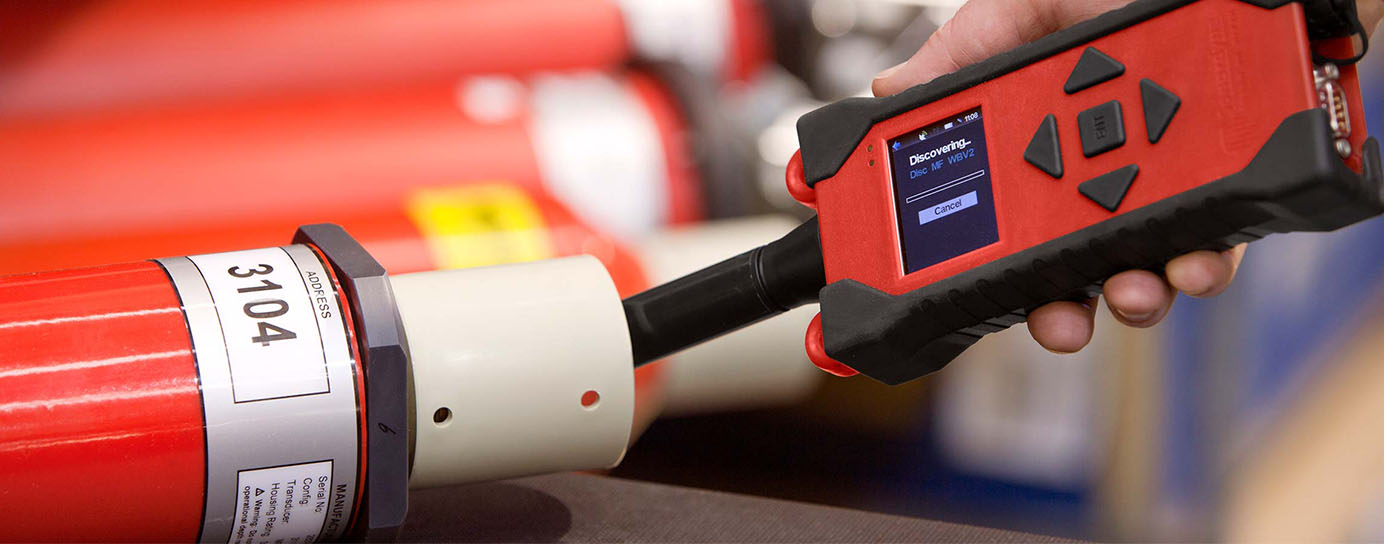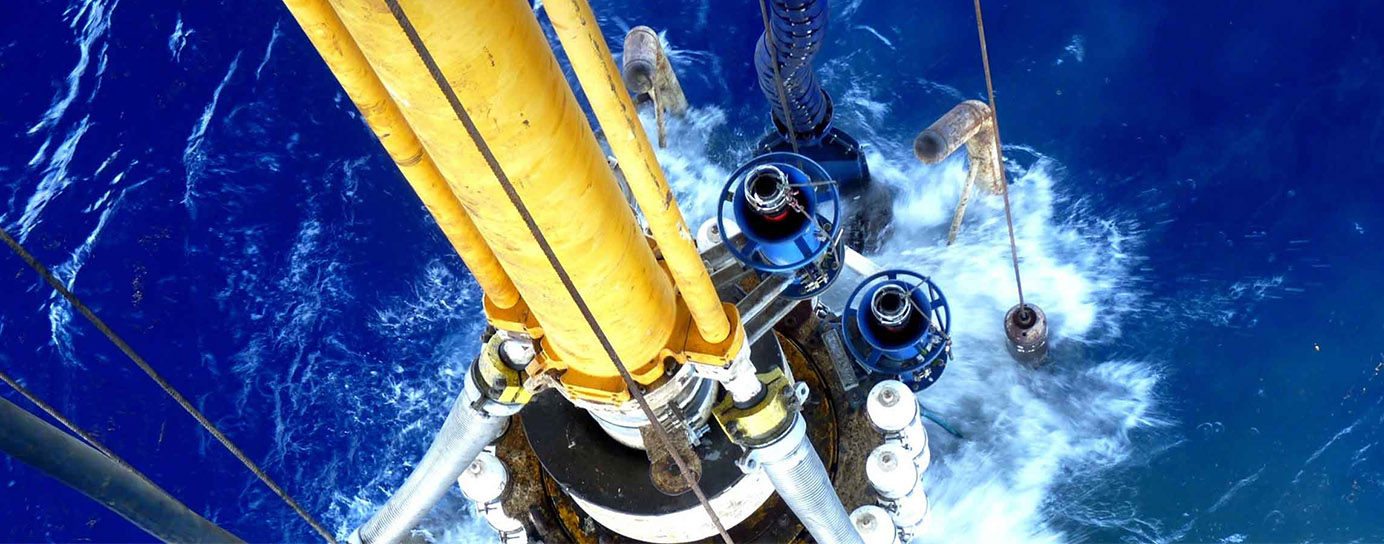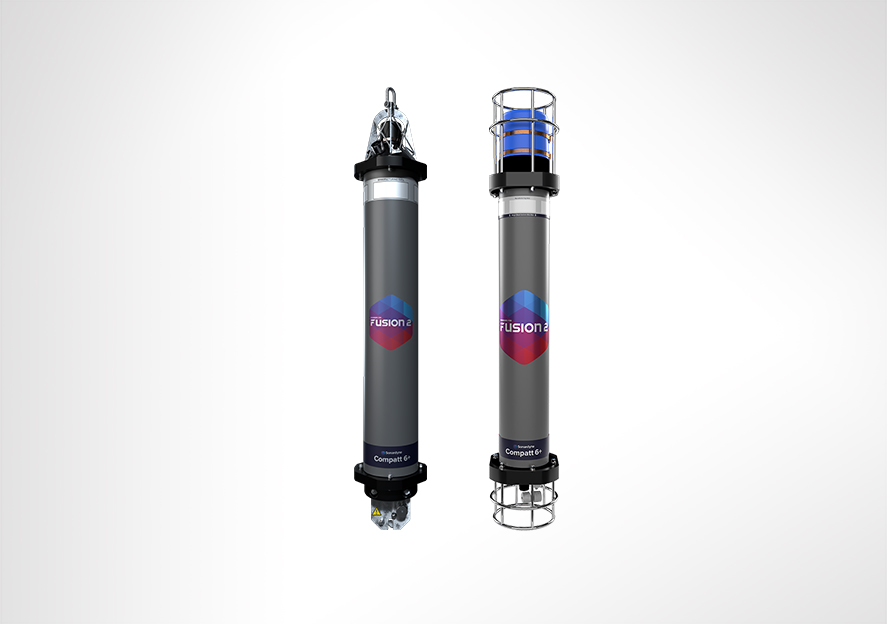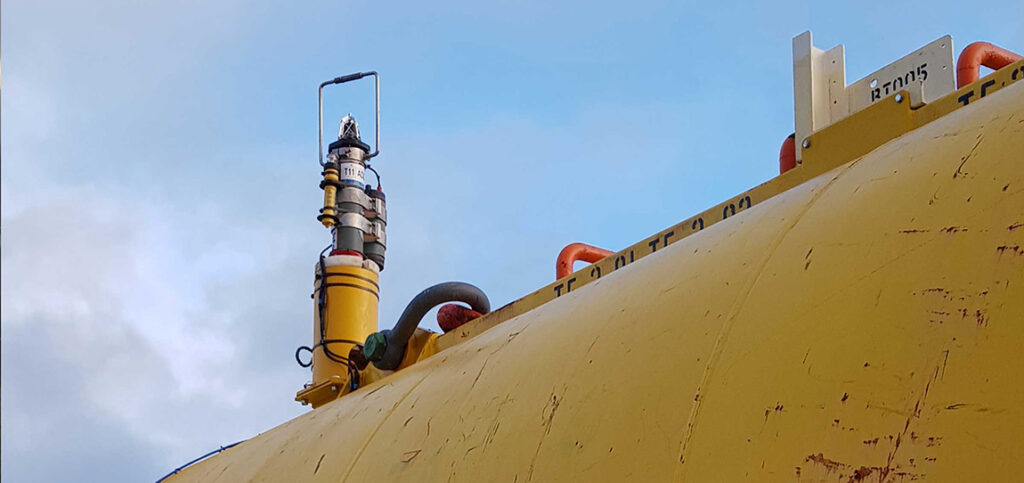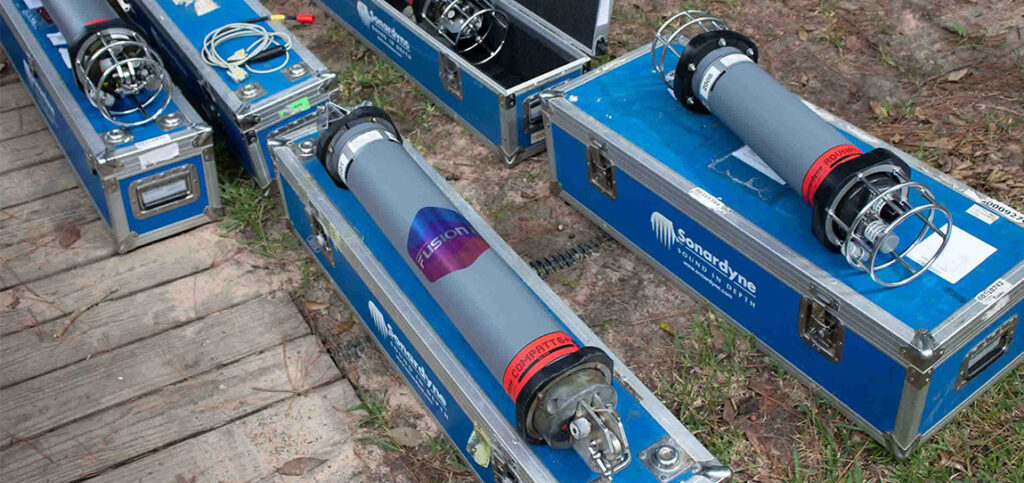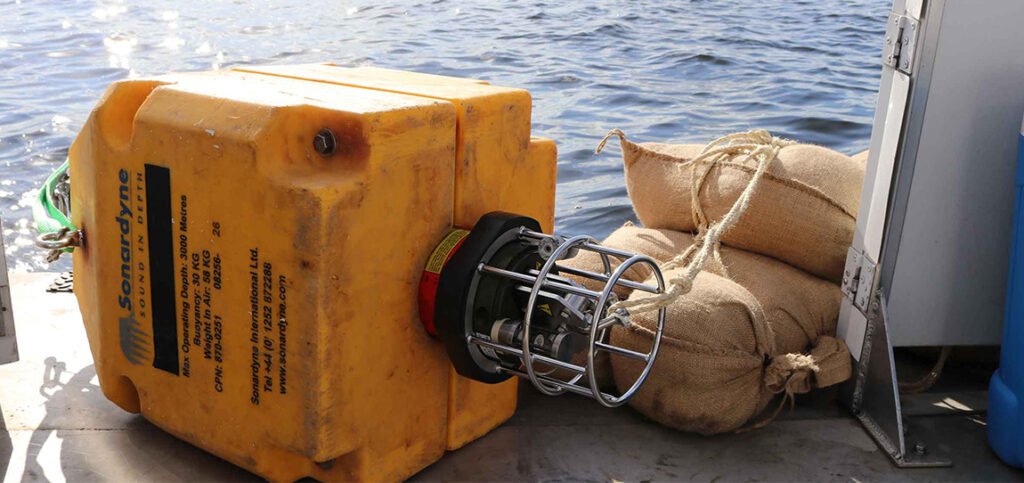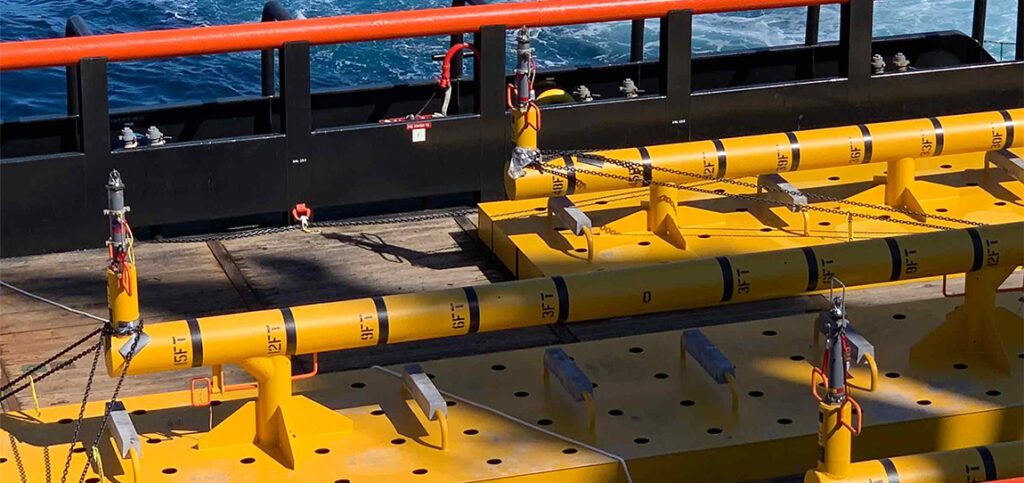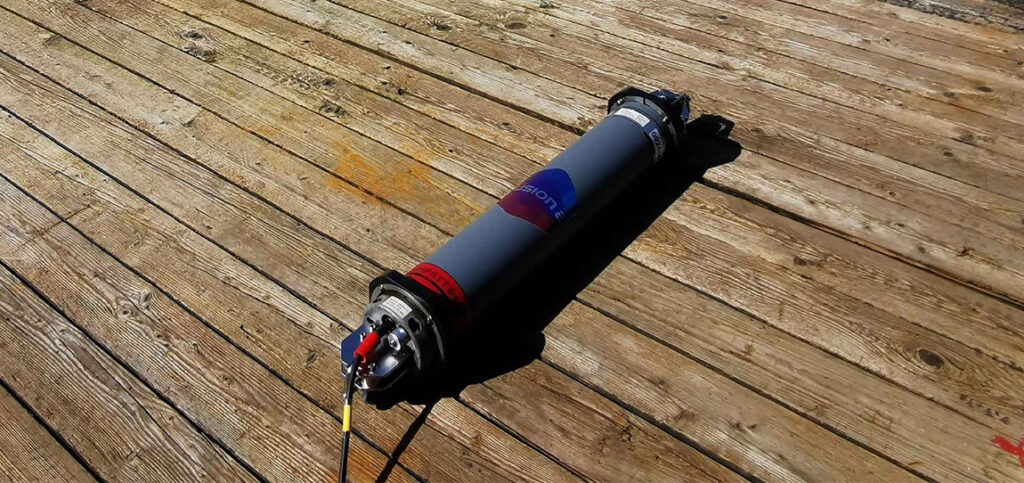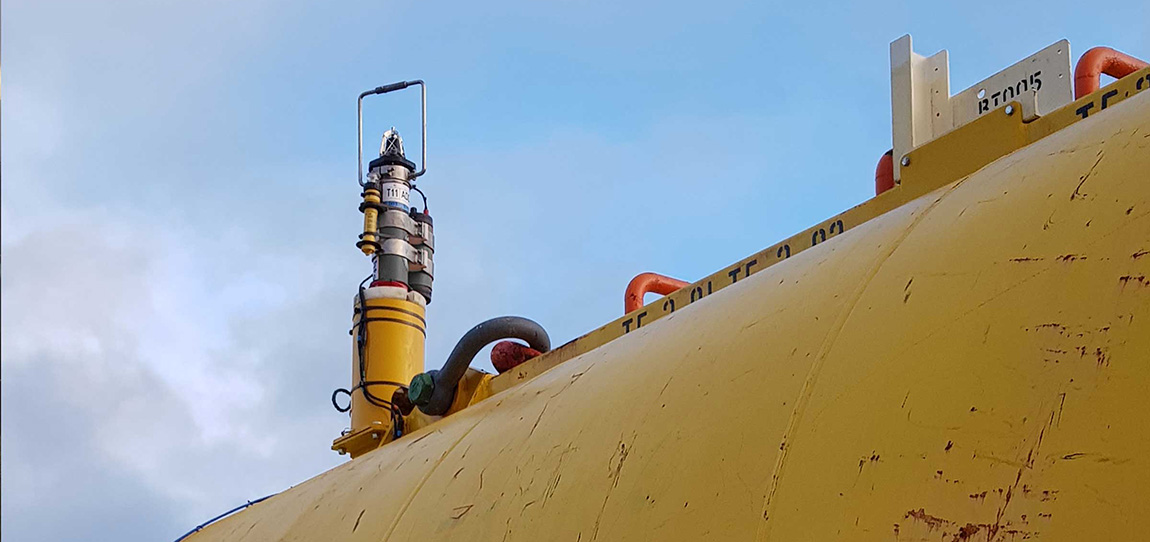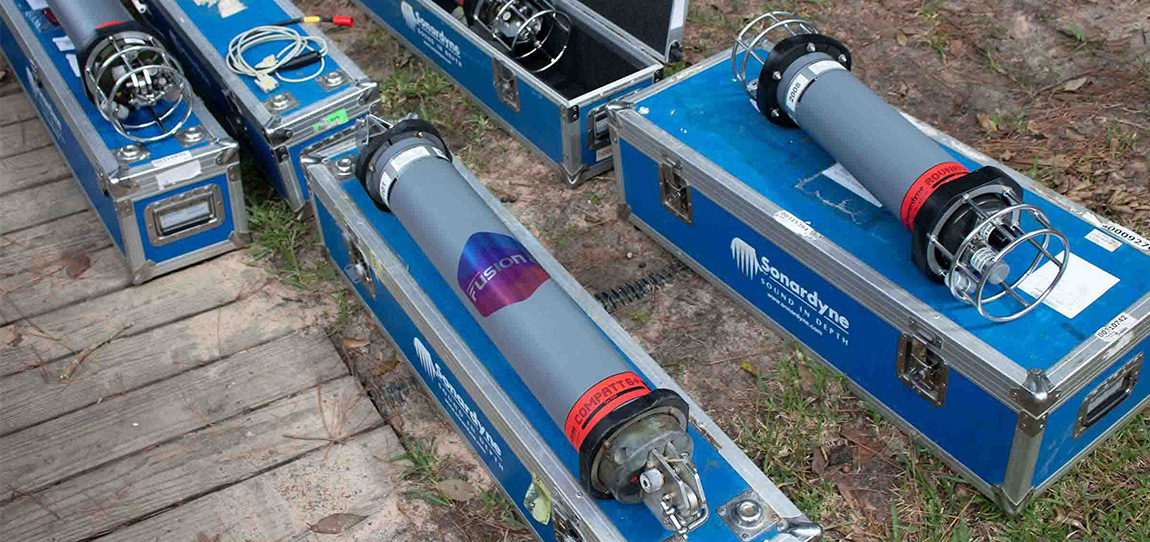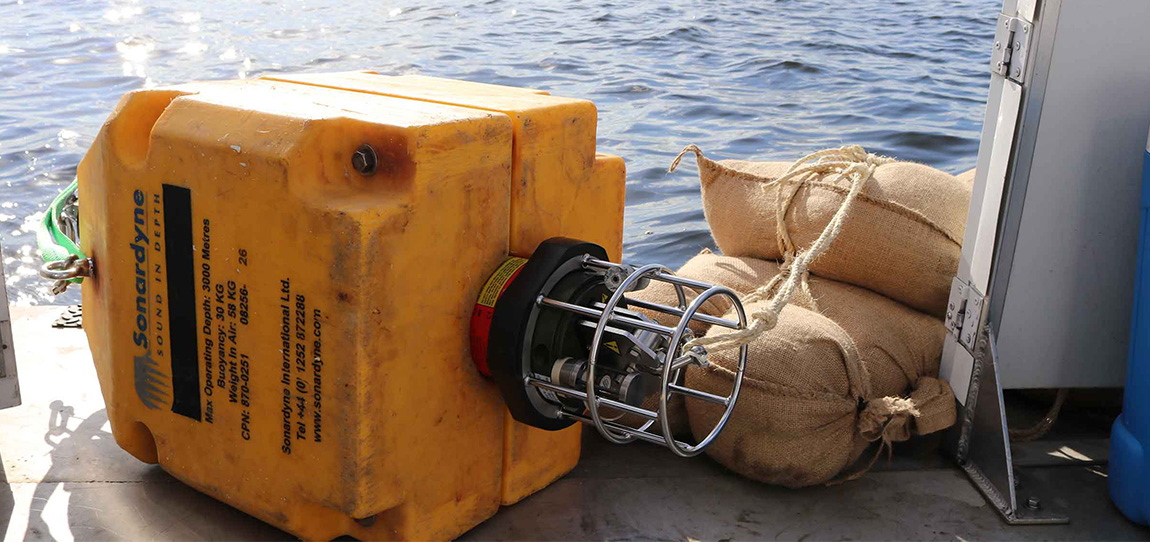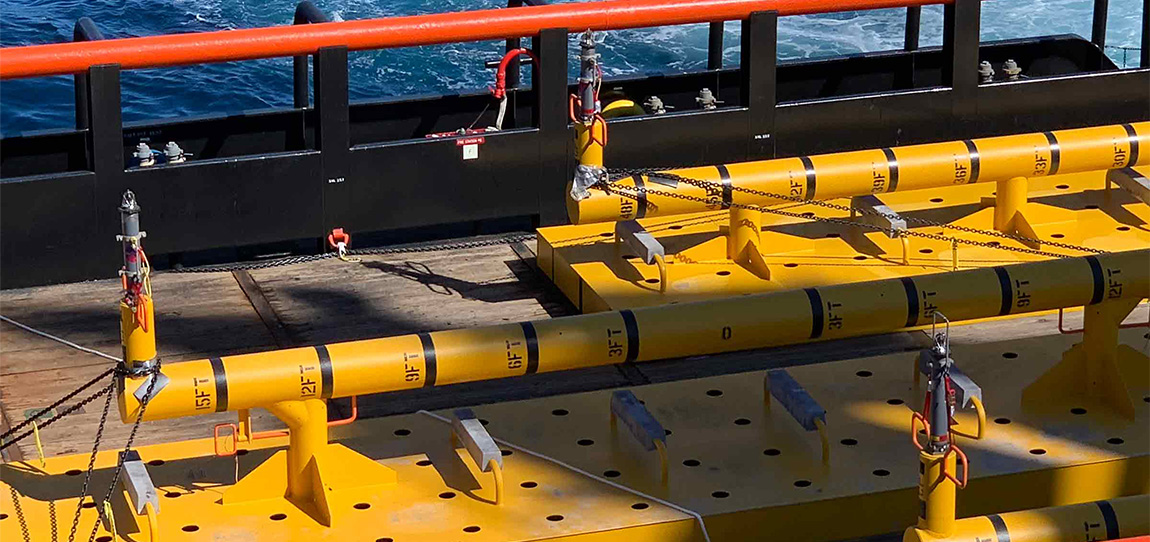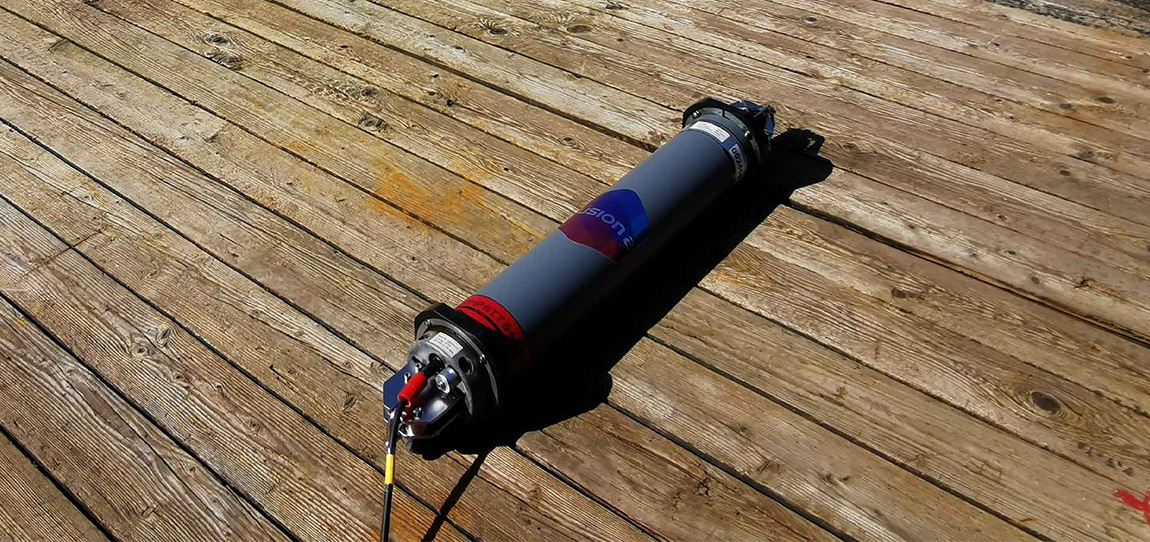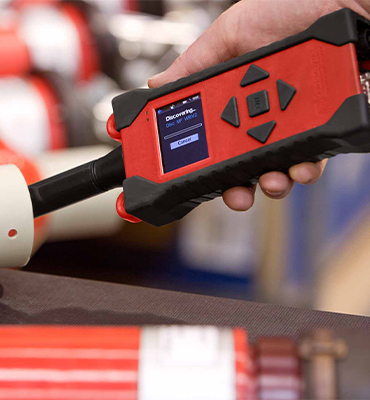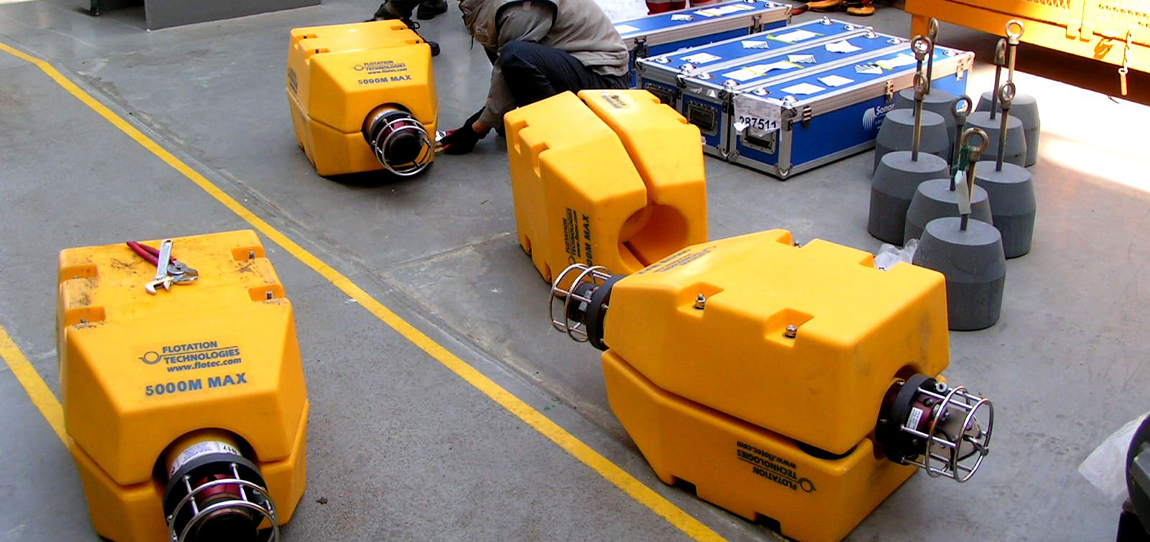Innovation at work
We’ve engineered BlueComm 200 to push the boundaries of your underwater communication. Using advanced LED technology and sensitive photomultiplier tubes, you’ll achieve communication ranges up to 150 m. Its design houses the emitter separately from the receiver, ensuring optimal performance and reliability.
Fast and flexible – key features to power your mission
- Lightning-fast data transfer: 2.5 to 10 Mbps at ranges up to 150 m
- Optimal performance: Perfect for moderate to low turbidity dark water (>200 m depth or at night)
- Flexible deployment: Connect with your AUV, ROV, USV or surface dunker system
- Deep-rated capability: Ready for operations up to 4,000 m
- Speed of light technology: Experience unprecedented data transmission rates
Perfect for your platform
Perfect for your:
- Autonomous Underwater Vehicles
- Extra-large uncrewed underwater vehicles (XLUUV)
- Uncrewed Surface Vehicles
- Remotely Operated Vehicles
- Tracking and communications systems
Choose your perfect match:
BlueComm 200
When you need maximum range and performance in dark water conditions, our visible light system delivers up to 150 m range – ideal for video transfer and direct vehicle control. You’ll transfer data up to 10,000 times faster than acoustic systems, although ambient light may affect operating range.
BlueComm 200 UV
Working with lights on? Our UV variant maintains reliable communication even with artificial lighting present. Operating at ranges up to 75 metres, it’s your go-to solution for ROV and AUV applications requiring illumination, such as video recording missions.
Both systems offer incredible energy efficiency – transfer more than nine gigabytes of data using just one Lithium D cell battery.
Specifications table
| Feature | Type 8361 BlueComm 200 UV | |
|---|---|---|
| Depth rating | Up to 4,000 m operation | |
| Data rate | 2.5–10 Mbps | |
| Optical communication range | Up to 75 m | |
| Mechanical construction | Anodized aluminium or titanium | |
| Supply voltage | 24–36 V dc | |
| Communications interface | 10/100 Base-T Ethernet (static IP address) | |
| Command interface | Graphical user interface or Ethernet UDP command set | |
| Receiver unit | ||
| Receive wavelength | UV (band pass filter blocking visible light) | |
| Receive angle | 180° (omni-directional) | |
| Receiver weight in air/water | 7.3/3.1 kg | |
| Power consumption | 10 W | |
| Emitter unit | ||
| Optical transmit power | 6 W (radiated light) | |
| Optical wavelength options | 450 nm (royal blue), 400–800 nm (white) | |
| Emitter beam shape | 180° (omni-directional) | |
| Emitter weight in air/water | 3.6/2.6 kg | |
| power consumption | 30 W (bandwidth allocation dependant) | |
| Environmental and dimensions | ||
| Operating temperature range | -5 to 40°C | |
| Storage temperature | -20 to 55°C | |
| Dimensions (length x diameter) | Receiver | 384 x 136 mm |
| Emitter | 199 x 136 mm |
STP files
Datasheets
Manuals and quick start guides
Optics
• 450 nm (royal blue), 405 nm (UV) optical wavelength
• 180° (omni-directional) beam pattern
• 10 W / 15 W receiver / transmitter optical transmit power
Design
• Titanium and glass construction
• Subconn connectors
• 5.7 kg weight in water, emitter and receiver
Performance
• 2.5 – 10 Mbps data rate
• 4000 m depth rating
• Up to 150m optical communication range
Ownership
What’s in the box?
• Manual, 2 test cables and 2 sets of one emitter and receiver
• Warranty: 1 year return to Sonardyne service centre
• ITAR Controlled: No
• UK Export Licence: Not required
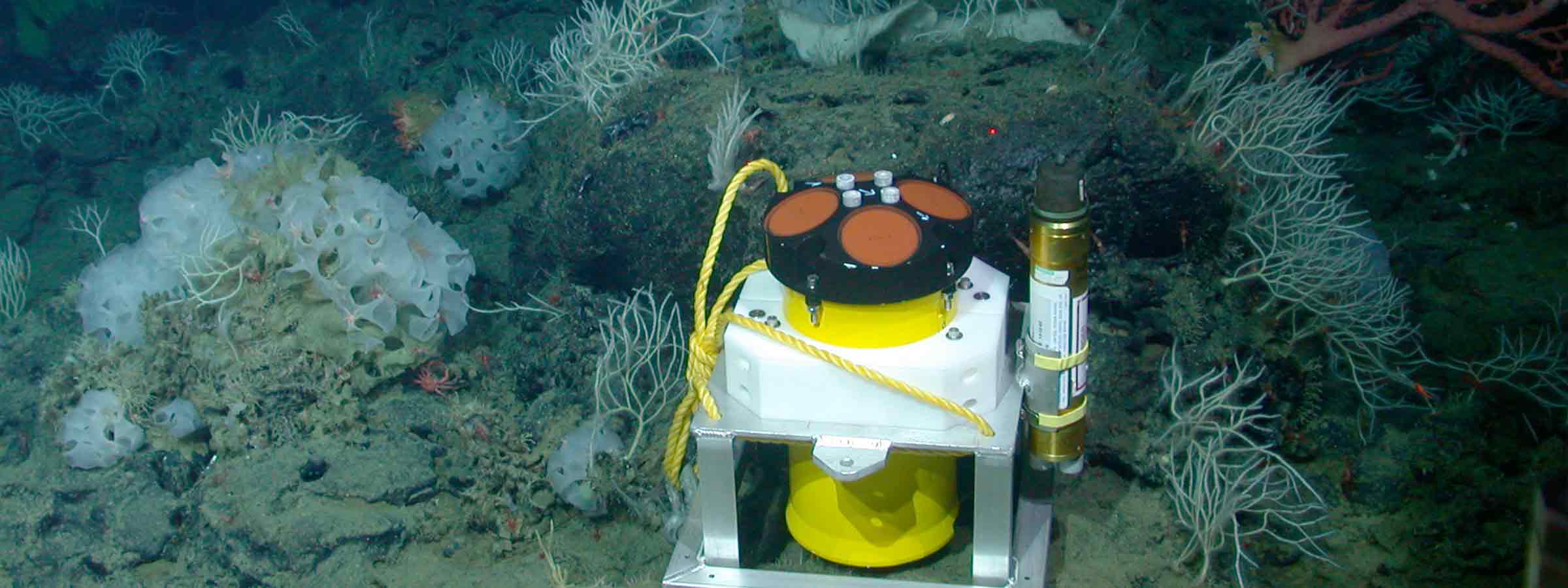
Modem 6 (subsea)
Modem 6 acoustic modems are a family of cost-effective solution for simple point-to-point data transfer from a wide range of sensors including, data loggers, ADCPs, CTDs and other subsea instruments.
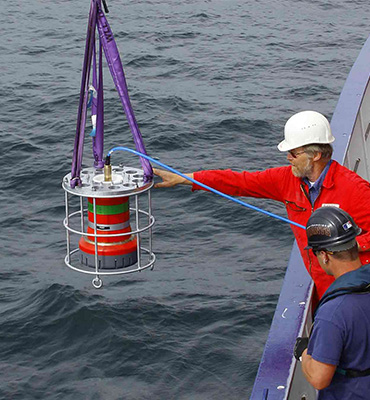
Modem 6 (surface)
Modem 6 acoustic modems are a family of cost-effective solutions for simple point-to-point data transfer from a wide range of sensors including, data loggers, ADCPs, CTDs and other subsea instruments.
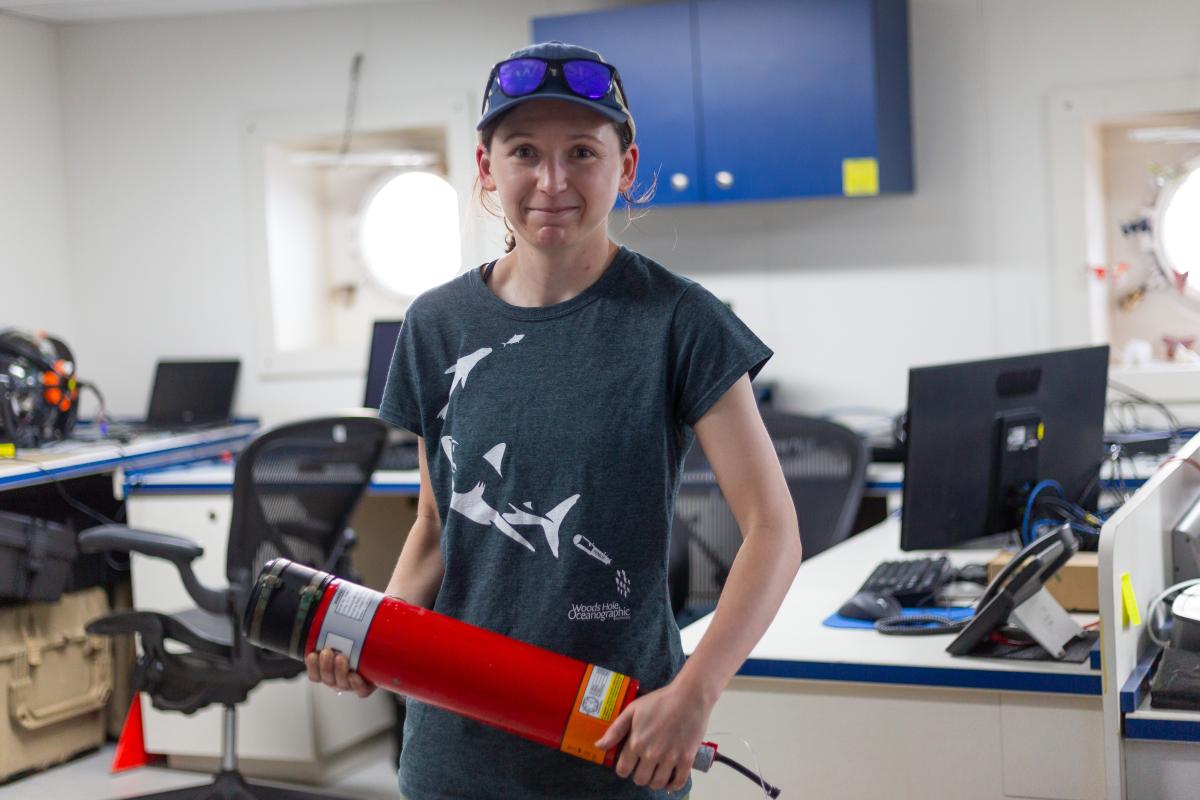
AvTrak 6
The most versatile instrument you can fit to your AUV. Built for simple integration on medium to large AUV platforms, all-in-one functionality comes as standard with AvTrak 6. It allows your AUV to undertake simultaneous LBL ranging, USBL tracking via a surface vessel and robust telemetry for AUV to vessel and AUV-to-AUV communications.
Navigate your marine environment with the confidence only SPRINT-Nav can provide.
Pinpoint location precision. Enhance your operations by adding valuable location detail enabling you to identify exactly where your data is drawn from or to pinpoint the location of assets, obstacles and pipelines.
Guide, control and navigate your USVs, ROVs and AUVs faster, safely and more efficiently with SPRINT-Nav. Operate your vehicles and vessels with the confidence of knowing exactly where they are and what they’re doing.
No calibration needed. Straight out of the box SPRINT-Nav is ready to go, saving you precious time on your operations.
Reduced in size – but not in performance, SPRINT-Nav Mini is the industry’s smallest all-in-one hybrid acoustic-inertial subsea navigator. It provides the perfect instrument for you to control your smaller inspection class ROVs and small to medium sized USVs.
Navigating – to hold station, SPRINT-Nav DP provides a reliable dynamic positioning reference in shallow water for your surface vessel to remain in one place without the need for a GNSS signal.
Engineered for all autonomous vehicles no matter what size or purpose, there is a SPRINT-Nav for your operations.
Why should you invest?
By choosing SPRINT-Nav you are choosing an all-in-one acoustic-inertial navigation sensor, replacing the need for a separate DVL, pressure sensor and INS/AHRS. Saving you the time, cost, cabling and integration challenges associated with using different sensors from different vendors.
At a glance
- Unique to Sonardyne
- Performance levels to suit your operations
- Tightly integrates raw acoustic, Doppler and inertial data
- Titanium housed for deep ROV missions
- Outputs altitude, depth, orientation and velocity
- Configure and control using a Web UI
Compact
Low power and small, it’s the ideal size for installing on all size ROVs as well as USVs undertaking data harvesting missions in shallow water and around offshore structures which often block GNSS signals.
Cost-effective
Because it’s cheaper than the four separate sensors it replaces (AHRS, DVL, INS and pressure sensor), it’s a cost-effective solution for your research platforms where budgets need to stretch as far as possible.
Specialist applications
SPRINT-Nav X is the highest-grade model in our SPRINT-Nav family designed for very specialist applications such as long endurance missions using XLUUVs.
Survey
Supports dual ROV and Survey use and standalone ROV guidance. Also provides mid-water station keeping with vendor independent USBL aiding.
Overview
Its high power output and Wideband 3 signal processing offers improved operating range and acoustic performance in challenging conditions such as when deployed from noisy vessels or in multi-path environments.
The internal Lithium-ion rechargeable battery pack minimises the supply current for long dunker cables. It also enables relocation of the dunker if the cable is cut.
The robust AGP connector on the Dunker 6+ is identical to the ROVNav 6+ and HPT USBL for compatibility and to reduce spares.
At a glance
- Perfect for commanding LBL transponders
- Use it to recover data from Fetch and AMTs
- Capability to operate as topside for RT 6 acoustic releases
- Deploy it over-the-side of your vessel
- Rugged mechanics and connectors
- Shock mounted internal electronics
Dunker 6+ LBL and telemetry transceiver is fully compatible with our modem and sensor logging instruments such as AMT and Fetch , allowing it to be used to retrieve data or configure logging regimes. It can also be used to release the RT 6 range of acoustic releases.
The Dunker 6+ system consists of 100 m of cable on a stainless steel cable drum with brake and locking mechanism. The 10 m deck cable between the 48 V Surface Interface Unit (SIU) and the cable drum allows the drum to be conveniently located. The connection to the cable drum is via an easily replaceable 8-way SubConn.
Optionally, an RT 6 topside kit with 30 m of cable is available in a carrying case without a cable drum.
Specifications table
| Feature | Type 8309-1351 | Type 8309-1353 | Type 8309-1355 | Type 8309-1356 | |
|---|---|---|---|---|---|
| Depth rating | 1,000 m | 1,000 m | 1,000 m | 1,000 m | |
| Operating frequency | MF (20–34 kHz) | MF (20–34 kHz) | LMF (14–19 kHz) | LMF (14–19 kHz) | |
| Transducer beam shape | Omni-directional | Directional | Omni-directional | Directional | |
| Transmit source level (dB re 1 µPa @ 1 m) | 187–196 dB (4 levels) | 190–202 dB (4 levels) | 187–196 dB (4 levels) | 187–202 dB (4 levels) | |
| Tone Equivalent Energy (TEE) | 193–202 dB | 196–208 dB | 193–202 dB | 193–208 dB | |
| Receiver sensitivity (dB re 1 µPa) | 90–120 dB (7 levels) | 80–120 dB (7 levels) | 90–120 dB (7 levels) | 80–120 dB (7 levels) | |
| Range precision | Better than 15 mm | Better than 15 mm | Better than 15 mm | Better than 15 mm | |
| Serial communications (software programmable) |
Primary port: RS485 (half-duplex) or RS232 Secondary port: RS485 (half-duplex) or RS232 or SYNC IN |
Primary port: RS485 (half-duplex) or RS232 Secondary port: RS485 (half-duplex) or RS232 or SYNC IN |
Primary port: RS485 (half-duplex) or RS232 Secondary port: RS485 (half-duplex) or RS232 or SYNC IN |
Primary port: RS485 (half-duplex) or RS232 Secondary port: RS485 (half-duplex) or RS232 or SYNC IN |
|
| Operating voltage | 24 or 48 V dc (±10%) | 24 or 48 V dc (±10%) | 24 or 48 V dc (±10%) | 24 or 48 V dc (±10%) | |
| External power | Active (listening) | <3 W typical (max 6 W when charging) | <3 W typical (max 6 W when charging) | <3 W typical (max 6 W when charging) | <3 W typical (max 6 W when charging) |
| Peak (during transmission | <80 W | <80 W | <80 W | <80 W | |
| Battery life Li-ion (listening) | 3 days | 3 days | 3 days | 3 days | |
| Connector type | AGP (8-way female) | AGP (8-way female) | AGP (8-way female) | AGP (8-way female) | |
| Mechanical construction | Super-duplex stainless steel | Super-duplex stainless steel | Super-duplex stainless steel | Super-duplex stainless steel | |
| Dimensions (length x diameter) | 692 x 200 mm | 660 x 200 mm | 586 x 200 mm | 641 x 230 mm | |
| Weight in air/water | 24/16 kg | 26/17 kg | 20/14 kg | 28/17 kg | |
| System kit | |||||
| Dunker 6, SIU, 100 m cable drum etc. | 602-0047 | 602-0053 | n/a | 602-0072 |
Frequently asked questions
STP files
Software and firmware
Software and control hardware
Datasheets
Manuals and quick start guides
Did you know?
Dunker 6+ can be used to recover data from Fetch and AMTs
Overview
Mini-ROVNav 6+ is designed to be significantly lighter and smaller than our standard ROVNav 6+ instrument, whilst providing full 6G LBL capabilities.
This makes it particularly suitable for inspection-class ROVs as well now uncrewed surface vessels (USVs) which can be configured to undertake routine LBL operations over-the-horizon from your survey vessel.
Its full support of Wideband 2 signal processing techniques offers long range and robust acoustic performance in challenging conditions such as on noisy vehicles or in multi-path environments.
At a glance
- Use it with Fusion 2
- Perfect when ROV space is limited
- USBL mode for emergency relocation
- Lightweight and easy to install
- Modem mode for data recovery from AMTs and Fetch instruments
Mini-ROVNav 6+ is also a fully compatible USBL responder or transponder compatible with Sonardyne Wideband 1 and 2 USBL systems and HPR 400. The internal Li-ion rechargeable battery pack also enables emergency transponder mode, so if the umbilical and therefore power is cut to the ROV it can still be located using a vessel equipped with a USBL system.
The integrated omni-directional MF transducer has a hemispherical beam pattern which is ideal for acoustics to an array and to a vessel alike.
Mini-ROVNav 6+ is fully compatible with our modem and logging equipment such as AMT and Fetch products, allowing it to be used to retrieve data or configure logging regimes. Data rates of between 100 to 9,000 bps user data rates can be supported depending on the environment.
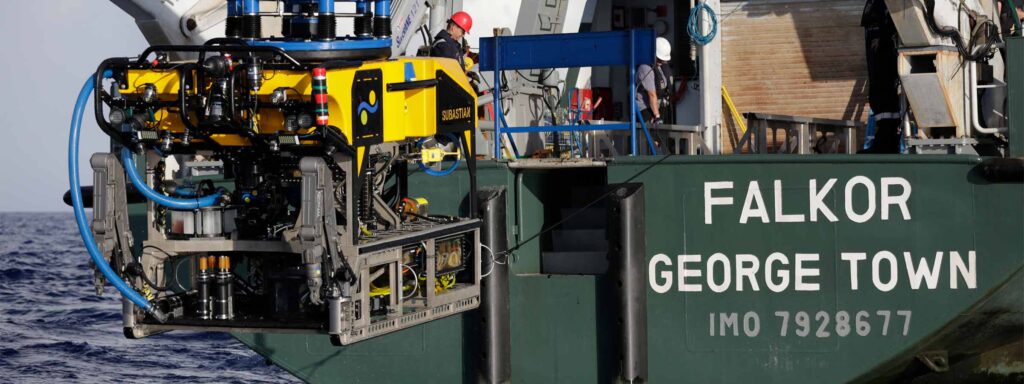
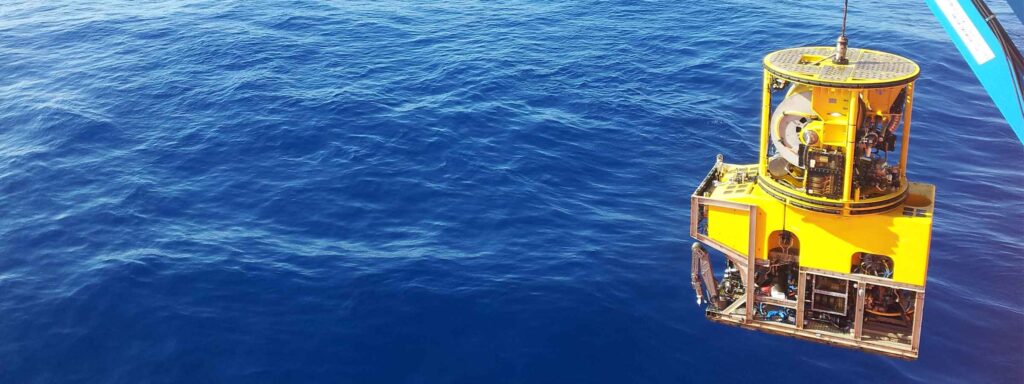
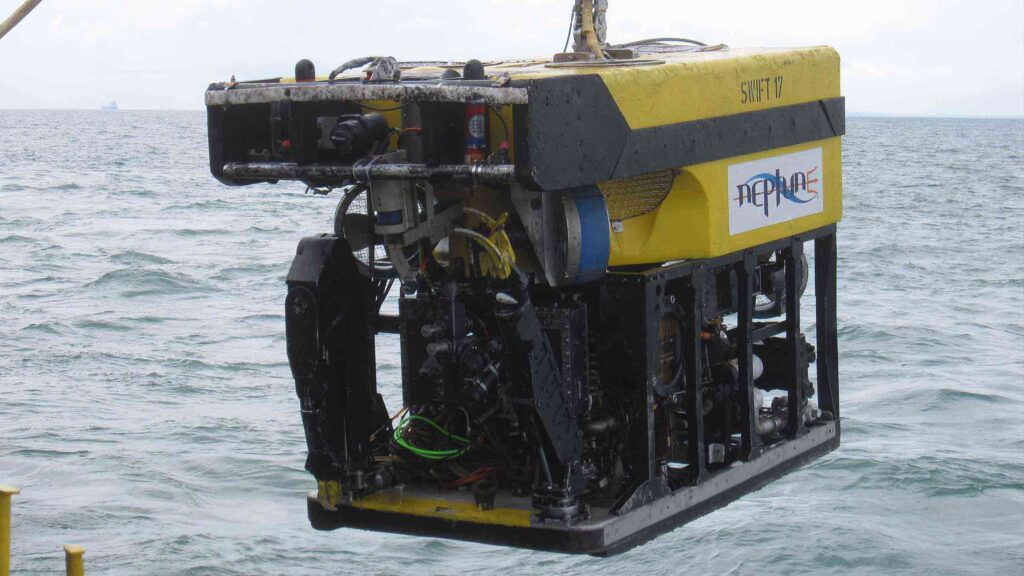
Specifications table
| Feature | Type 8240 | |
|---|---|---|
| Depth rating | 3,000 m | |
| Operating frequency | MF (20–34 kHz) | |
| Transducer beam shape | Omni-directional | |
| Transmit source level (dB re 1 µPa @ 1 m) | 181–187 dB (2 levels) |
|
| Tone Equivalent Energy (TEE) | 187–193 dB | |
| Receiver sensitivity (dB re 1 µPa) | 90–120 dB | |
| Range precision | Better than 15 mm | |
| Operating voltage | 24 or 48 V dc (±10%) | |
| Serial communications | Primary port: RS232 (9,600 – 115,200 baud) | |
| Responder input | 4 V to 24 V, >0.5 ms duration |
|
| Release output | 12 V (250 mA rated) |
|
| Battery life (listening) Li-ion | >7 days | |
| External power | Active (listening) | <2 W |
| Battery charging | <6 W | |
| Peak (during transmission) | <50 W | |
| Mechanical construction | Hard anodised aluminium alloy and stainless steel connectors | |
| Serial communications bulkhead connector | MCBH8M | |
| Dimensions (length x maximum diameter) | 501 x 93.5 mm | |
| Weight in air/water | 5.1/2.2 kg | |
| Operating temperature | -5 to 40°C | |
| Storage temperature | -20 to 55°C | |
| Sensors | ||
| Temperature (±0.25°C) | Standard | |
| Strain gauge pressure sensor (±0.25% FS) | Standard |
Frequently asked questions
Software and firmware
Datasheets
Did you know?
Mini ROVNav 6+ can be used with Fusion 2 software
Overview
Marker 6 is a low cost acoustic positioning transponder for when a compact design and deep operating capability are important operational factors. It enables targets such as underwater structures, vehicles or instrumentation packages to be marked, located or tracked using a Ranger 2 USBL system – Micro, Mini or Standard.
The instrument incorporates Near Field Communications (NFC) allowing for fast set-up. Its acoustic address can be selected from over 200 unique identities meaning that multiple Marker 6s can be deployed in close proximity to each other without causing interference.
At a glance
- Mark and relocate underwater equipment, vehicles and points of interest
- Compatible with all Ranger 2 USBL systems
- Depth rated up to 7,000 m
- More than 30 months’ listening life (lithium battery option)
- Over 200 unique acoustic addresses
On the backdeck, the address can be quickly programmed into each transponder using a suitable NFC enabled handset (including an NFC enabled Android™ handset with the Sonardyne NFC App) or a dedicated HF Radio Frequency Identification (RFID) reader.
Sonardyne Wideband signal encoding reduces the interference both on and by adjacent Sonardyne and other acoustic positioning systems.
The NFC link provides the ability to enter Marker 6 into a storage mode when not in use, thereby significantly increasing the overall battery endurance.
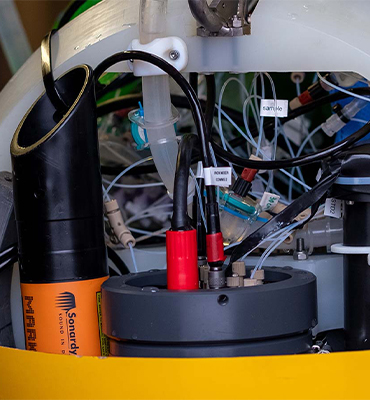
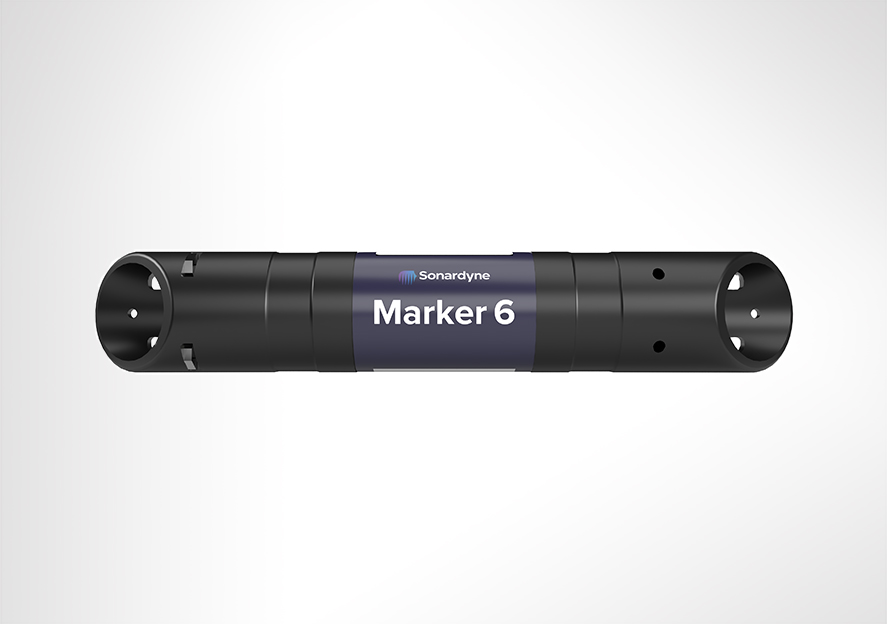
Specifications table
| Feature | Type 8326-4311 | Type 8326-7511 | |
|---|---|---|---|
| Depth Rating | 4,000 m | 7,000 m | |
| Operating Frequency | MF (20–34 kHz) | MF (20–34 kHz) | |
| Transducer Beam Shape | Omni-directional ±130º | Omni-directional ±130º | |
| Transmit Source Level (re 1 µPa @1 m) | 187 dB | 187 dB | |
| Inclinometer Sensor | ±5° | ±5° | |
| Battery Life (Continuously Listening) | Alkaline | >9.5 months | >9.5 months |
| Lithium | >30 months | >30 months | |
| Storage Mode (Battery Disconnect via NFC) | Alkaline | 5 years (battery self-discharge limited) | 5 years (battery self-discharge limited) |
| Lithium | >10 years (battery self-discharge limited) | >10 years (battery self-discharge limited) | |
| Operating Temperature Range | -5 to 40°C | -5 to 40°C | |
| Storage Temperature Range | -20 to 55°C | -20 to 55°C | |
| Mechanical Construction | Outer Housing | Polypropylene | Polypropylene |
| Inner Housing | Duplex stainless steel | Titanium grade 5 | |
| Dimensions (Length x Diameter) | 383.0 x 63.0 mm (15.1 x 2.5”) | 383.0 x 63.0 mm (15.1 x 2.5”) | |
| Weight in Air/Water | 2.0/1.3 kg | 1.5/0.7 kg |
Frequently asked questions
Software and control hardware
Datasheets
Manuals and quick start guides
Did you know?
Marker 6 is compatible with all of our Ranger 2 USBL systems
Overview
The instrument is a turn-key solution comprised of carefully selected high grade and highly reliable inertial sensors integrated into in-house designed inertial measurement unit (IMU).
The selected inertial sensors are the standard for commercial aviation with a proven 20+ year track record. These sensors have a highly desirable characteristic being insensitive to vibration, temperature changes and having very limited initial errors. The result is a system which is highly suitable for the marine environment where performance, robustness and data integrity need to be available from initialisation, even during the harshest conditions.
Lodestar requires no external aiding and settles robustly in dynamic conditions in less than five minutes. On-board data storage and backup battery functionality ensures continued operation and eliminates the risk of data loss even if communications or external power are lost. Power-pass through to external aiding sensors is supported to ease integration requiring only a single cable for comms and power.
If a full INS solution is required, Lodestar can easily be field upgraded to a SPRINT system (apart from Lodestar 200). This makes the Lodestar a flexible and future-proof solution for both ROV guidance and survey applications.
Lodestar has a proven track record spanning more than 10 years in the field in diverse applications from ROV guidance and autopilot to demanding survey applications. The instrument is available in 4,000 and 6,000 metre depth ratings with a variety of connector options and configurations.
At a glance
- Designed to aid subsea vehicle guidance: AUVs, ROVs and UUVs
- Uses high quality Honeywell gyro and accelerometers
- Sensors available in three performance levels: 200, 300 and 500
- Fast settling time so you can get straight to work
- Integrated DVL option available; Lodestar-Nav
- Factory upgradeable to SPRINT INS
Lodestar-Nav 200
Lodestar-Nav 200 provides all-in-one navigation solution for subsea vehicles by combining a Lodestar 200 AHRS with our Syrinx Doppler Velocity Log (DVL) and a high accuracy pressure sensor in a single housing. This saves cost, payload space and the complexity of integrating and operating separate sensors from different vendors.
Lodestar-Nav is pre-calibrated providing the ROV pilots with a robust and reliable solution, even in the most challenging operational scenarios, without needing to worry about sensor offsets.
Syrinx DVL inside that provides a large altitude range and high precision at all altitudes; this combines the best of 300 and 1200 kHz DVLs. Each DVL transducer is fitted with a full depth rated water block to ensure protection of the internal components and easy replacement if damaged.
Lodestar-Nav can be interfaced via a single connection and/or the DVL can be interfaced separately depending on requirements. Continuous on-board data storage supports post-mission diagnostics and post-processing.
Size
Measuring just 260 mm tall, the 4,000 m rated titanium housing allows easy fitment to any subsea vehicle. 6,000 m housing option.
Long life sensors
Lodestars and SPRINTs use Honeywell-supplied RLGs and inertial sensors with 400,000 MTFB, which have been proven in over 20 years in commercial aircraft.
Connectivity
Most Lodestars can be upgraded to SPRINT in the field as your requirements grow so there’s no need to remove and re-install a different instrument.
Specifications
| Feature | Lodestar 300 | Lodestar 500 | |
|---|---|---|---|
| Depth rating | 4,000 / 6,000 m | 4,000 / 6,000 m | |
| Heading | 0.2° | 0.1° | |
| AHRS settle time | <5 minutes in dynamic conditions | <5 minutes in dynamic conditions | |
| Roll and pitch | 0.01° | 0.01° | |
| Power requirement | 20–50 V dc, 15 W nominal, 35 W maximum | 20–50 V dc, 15 W nominal, 35 W maximum | |
| Power pass through | 3 x for external aiding sensors (up to 3A per sensor) | 3 x for external aiding sensors (up to 3A per sensor) | |
| Back up battery type/life | Li-ion/5 minutes | Li-ion/5 minutes | |
| Data storage | 8 GB internal memory | 8 GB internal memory | |
| Serial ports/protocol | 4x RS232 or RS485 | 4x RS232 or RS485 | |
| Other ports | 1x Ethernet, 4 triggers | 1x Ethernet, 4 triggers | |
| Output rate | Up to 100 Hz | Up to 100 Hz | |
| Output telegrams | Industry standard AHRS/INS telegrams including acceleration and rotation rates | Industry standard AHRS/INS telegrams including acceleration and rotation rates | |
| Connectors | 4x Seacon / Seanet, 1x Seacon / Seanet | 4x Seacon / Seanet, 1x Seacon / Seanet | |
| Mechanical construction | Titanium | Titanium | |
| Dimensions (diameter x height) |
4,000 m (Seacon) | 205 x 260 mm | 205 x 260 mm |
| 6,000 m (Seacon) | 205 x 280 mm | 205 x 280 mm | |
| 4,000 m (Seanet) | 205 x 250 mm | 205 x 250 mm | |
| Weight in air/water | 4,000 m | 18.5/11.5 kg | 18.5/11.5 kg |
| 6,000 m | 22/14 kg | 22/14 kg | |
| Operating temperature | -20 to +55°C | -20 to +55°C | |
| Storage temperature | -20 to +60°C | -20 to +60°C | |
| Shock rating | 22 g, 11 ms half sine | 22 g, 11 ms half sine |
Frequently asked questions
SPRINT, SPRINT-Nav, Lodestar and Lodestar-Nav troubleshooting
How to connect to the Lodestar within a Gyro USBL via an NSH
How to enter Transceiver & Lodestar Offsets for Optimised USBL
What cables do I need for my Lodestar?
How do I mate and calibrate a DVL to my Lodestar?
Can I power my subsea instruments with Lodestar or SPRINT?
How do I mate and calibrate a SPRINT or Lodestar to my Syrinx DVL?
What’s the difference between FOG and RLG?
STP files
Software and firmware
Software and control hardware
Manuals and quick start guides
Technical bulletin
Did you know?
Lodestar is highly optimised for cost, size, weight and power (C-SWaP)
Overview
ROVNav 6+ uses our new Wideband 3 signal technology, which is key to unlocking the benefits of your Fusion 2 LBL system.
It allows, for the first time, sensor telemetry data (e.g. pressure, depth or temperature) from a seabed or structure deployed Compatt 6+ to be embedded within navigation (ranging) data. This change has a big impact on operations such as structure installation, as breaks in tracking to get sensor reading updates at vital moments are now a thing of the past.
Its compatibility with Wideband 3 and Wideband 2 telemetry commands, and support of high power Wideband 2 ranging protocols, proven for their accuracy and robustness, means the ROVNav 6+ offers improved range and acoustic performance in challenging conditions such as on noisy vehicles or in multipath environments.
At a glance
- High power, long range LBL transceiver for ROVs
- Wideband 3-enabled supporting embedded sensor data with ranging data
- Optimised for Fusion 2 and compatible with Fusion 1
- 3,000, 5,000 or 7,000 m depth rated options
- USBL mode for emergency ROV relocation
- Modem mode for harvesting data from Sonardyne logging sensors; Fetch, AMT…
ROVNav 6+ is also a fully functional USBL responder or transponder, compatible with Wideband 2 USBL systems and HPR400. The internal li-ion rechargeable battery pack also enables emergency transponder mode, so if the umbilical and therefore power is cut to the ROV it can still be located by USBL.
The omni-directional remote MF transducer makes installation on an ROV easy. ROVNav 6+ is designed to be rugged and relatively lightweight and utilises robust underwater connectors. ROVNav 6+ supports a range of internal sensors including: strain gauge pressure, PRT temperature and MEMS based inclinometer.
ROVNav 6+ is also fully compatible with our modem and logging equipment such as AMT and Fetch products, allowing it to be used to retrieve data or configure logging regimes. It supports all of our Wideband 2 and Wideband 3 spread spectrum acoustic communication; 100 to 9,000 bps data rates can be selected depending on the environment.
Sensor options include a Digiquartz pressure sensor, precision inclinometer and altimeter interface. This provides a fully featured ROV manipulator deployable tool/sensor pack for a range of different applications including metrology, bathy survey and structure deployment operations, without the requirement for any additional interfacing on the ROV.
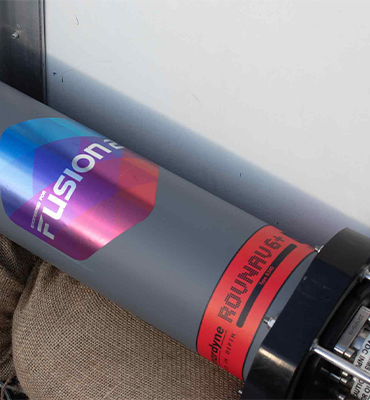
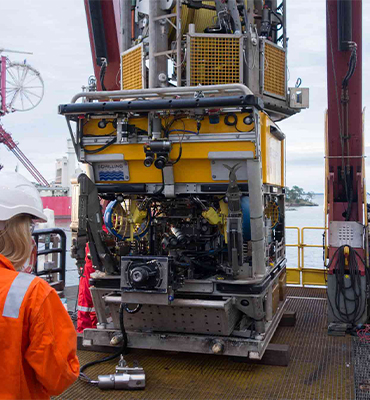
Specifications table
| Feature | 8340-3161 | 8340-5261 | 8340-7261 |
|---|---|---|---|
| Depth Rating | 3,000 m | 5,000 m | 7,000 m |
| Operating Frequency | MF (20–34 kHz) | MF (20–34 kHz) | MF (20–34 kHz) |
| Transducer Beam Shape | Omni-directional | Omni-directional | Omni-directional |
| Transmit Source Level (dB re 1 µPa @ 1 m) | 187–196 dB (4 levels) | 187–196 dB (4 levels) | 187–196 dB (4 levels) |
| Range Precision | Better than 15 mm | Better than 15 mm | Better than 15 mm |
| Serial Communications | RS232 or RS485 (half-duplex) | RS232 or RS485 (half-duplex) | RS232 or RS485 (half-duplex) |
| Battery Life Li-ion (Listening) | 3 days | 3 days | 3 days |
| Operating Voltage | 24 or 48 V dc (±10%) | 24 or 48 V dc (±10%) | 24 or 48 V dc (±10%) |
| Serial Communications Connector | Subconn (8-way female) | Subconn (8-way female) | Subconn (8-way female) |
| Remote Transducer Connector | Burton (3-way male) | Burton (3-way male) | Burton (3-way male) |
| Housing Mechanical Construction | Hard anodised aluminium 6082 | Hard anodised aluminium 7075 | Hard anodised aluminium 7075 |
| Remote Transducer Mechanical Construction | Stainless steel 316 | Stainless steel 316 | Stainless steel 316 |
| Dimensions (Maximum) (Length x Diameter) | 768 x 200 mm | 768 x 200 mm | 768 x 200 mm |
| Weight in Air/Water | 14.3/5.3 kg | 14.7/5.7 kg | 15.5/6.0 kg |
Frequently asked questions
If I’m using Fusion 2, can I choose to use Wideband 2 or Wideband 3 telemetry?
Can ROVNav 6+ be used with standard Compatt 6s?
Will my ROVNav 6 work with Fusion 2?
Do I need to upgrade to Compatt 6+ and ROVNav 6+?
Where should I install my ROVNav 6+ transducer?
What are the differences between a ROVNav 6+ and Mini ROVNav 6+ ?
How to QC a Sound Velocity (SV) in Fusion 2
How far can my Compatt 6+ be above the seabed?
How do I perform an LBL calibration in Fusion 2?
STP files
Software and firmware
Transponders
Datasheets
Manuals and quick start guides
Technical bulletin
Did you know?
ROVNav 6+ is compatible with Fusion 1 and can be depth rated up to 7,000 m
Overview
WMT is a 6G compatible, high acoustic output power USBL transponder available in two depth versions: 3,000 m and 7,000 m. The 7,000 m version has a higher acoustic output power level for improved long-range operation.
For ROV and towfish tracking, WMT supports responder trigger for faster position updates, an integrated rechargeable Li-Ion battery pack that is charged from the ROV’s power supply and full RS232 communications enabling channel set up, power and gain etc. to be changed from the surface.
At a glance
- Use it with Ranger 2 for deep water, long layback tracking tasks
- High power acoustic output and directional transducer
- Responder mode for fast position updates
- Full two-way Sonardyne Wideband 2 interrogation and reply
- Li-Ion rechargeable battery pack
- Optional remote transducer
An on/off switch (3,000 m only) helps to ensure the battery pack is not discharged when not in use. If an umbilical trigger is not available, then the full Wideband transponder mode provides excellent USBL performance in a small, lightweight package.
Remote omni or directional transducers are available for WMT. These make installation on a ROV easier as the remote transducer can be installed where there is good line-of-sight and is easily replaced if damaged. The main body of the transponder can then be installed within the ROV frame where it is well protected from damage.
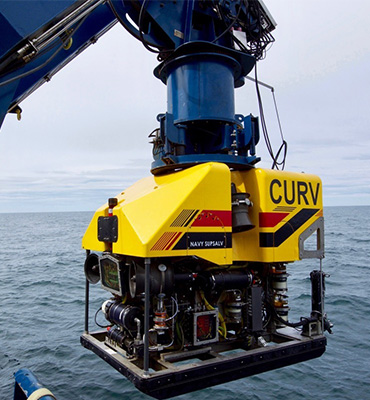
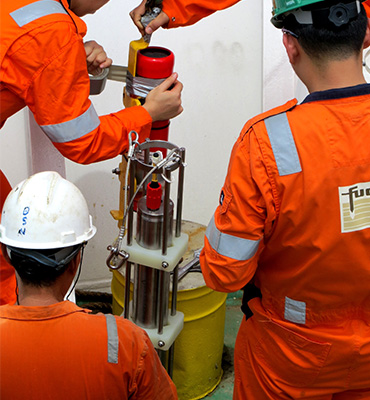
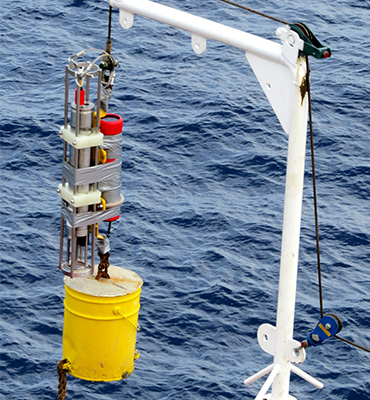
Specifications table
| Feature | Type 8190-3111 | Type 8190-3112 | Type 8190-7212 | |
|---|---|---|---|---|
| Depth Rating | 3,000 m | 3,000 m | 7,000 m | |
| Operating Frequency | MF (20–34 kHz) | MF (20–34 kHz) | MF (20–34 kHz) | |
| Transducer Beam Shape | Omni-directional | Directional | Directional | |
| Source Level (re 1 µPa @ 1 m) |
High Power | 187 dB | 193 dB | 199 dB |
| Low Power | 181 dB | 187 dB | 193 dB | |
| Tone Equivalent Energy (TEE) WBv2+ |
High Power | 193 dB | 199 dB | 205 dB |
| Low Power | 187 dB | 193 dB | 199 dB | |
| Range Precision | Better than 15 mm | Better than 15 mm | Better than 15 mm | |
| Depth Sensor | ± 0.5% full scale | ± 0.5% full scale | ± 0.5% full scale | |
| Communications Interface | RS232 (9,600–115,200 baud) | RS232 (9,600–115,200 baud) | RS232 (9,600–115,200 baud) | |
| External Supply Voltage | 24 or 48 V dc (± 10%) | 24 or 48 V dc (± 10%) | 24 or 48 V dc (± 10%) | |
| External Power | Sleep | ~650 mW | ~650 mW | ~650 mW |
| Wideband Listening | ~1 W | ~1 W | ~1 W | |
| Battery Charging | 6 W | 6 W | 6 W | |
| Peak (During Transmission) |
<50 W | <50 W | <50 W | |
| External Power Switch | Yes | Yes | No | |
| Battery Life (Li-ion 15 V) |
Listening | 30 days | 30 days | 30 days |
| Continuous 5 Seconds Interrogation |
Approx. 6 days at low power | Approx. 6 days at low power | Approx. 6 days at low power | |
| Mechanical Construction | Anodised aluminium alloy and plastics | Anodised aluminium alloy and plastics | Anodised aluminium alloy and plastics | |
| Operating Temperature | -5 to 40°C | -5 to 40°C | -5 to 40°C | |
| Storage Temperature | -20 to 55°C | -20 to 55°C | -20 to 55°C | |
| Dimensions (Diameter x Length) | 94 x 501 mm | 94 x 513 mm | 98 x 513 mm | |
| Weights in Air/Water | 5.1/2.2 kg | 7.0/3.5 kg | 7.0/3.5 kg | |
| Options | Remote, Cable Connected Transducer (see separate datasheet) |
Remote, Cable Connected Transducer (see separate datasheet) |
None |
Frequently asked questions
Software and firmware
Software and control hardware
Datasheets
Manuals and quick start guides
Technical bulletin
Did you know?
WMT is used with Ranger 2 USBL for tracking and communications
Overview
WSM 6+ is one our most popular USBL transponders, selected by customers for its small size, value and dependable performance in all environments, shallow or deep.
It’s the perfect choice for fitting to observation and work-class ROVs, towfish, submersibles and equipment being deployed onto the seabed for short durations.
WSM 6+ is compatible with all of our Ranger 2 USBL systems and we even include one with every Ranger 2 Standard – as standard.
The compact and rugged design is based on the field proven mechanics from previous generation designs and is available with omni-directional or directional transducers. The omni version is depth rated to 1,000 m and the directional is depth rated to 4,000 m.
At a glance
- Rechargeable USBL transponder designed for tracking ROVs, towfish and equipment
- Choice of 1,000 m (omni-directional) and 4,000 m (directional) depth ratings
- Compatible with our family of Ranger 2 USBL systems: Micro, Mini and Standard
- Transponder or responder operating modes
- Depth sensor for improved USBL positioning performance
- External on/off switch for battery saving
Both versions support transponder and responder operating mode if an external trigger from your platform is available. Responder mode provides significantly faster position updates than transponder mode.
WSM 6+ supports Wideband 2 acoustic signals and legacy Wideband 1 and HPR 400. The configuration is programmable using supplied software and a serial link or it can be configured acoustically via our back deck handheld test unit – iWand. This allows the WSM 6+ to be configured for use with all of the popular MF frequency acoustic navigation systems.
Both types of WSM 6+ are also fitted with a depth sensor fitted as standard to aid USBL positioning accuracy and an external on/off switch to save battery power when not in use.
WSM 6+ variants are available with acoustically controlled output lines suitable for external motor drive, burnwire or contact closure releases.
Watch our youtube video to learn more
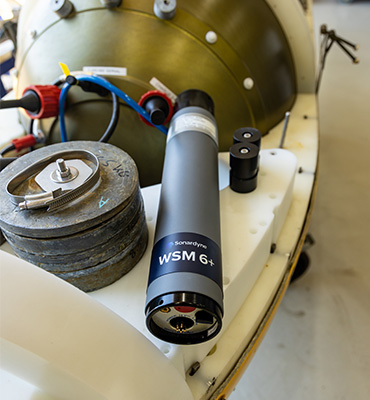
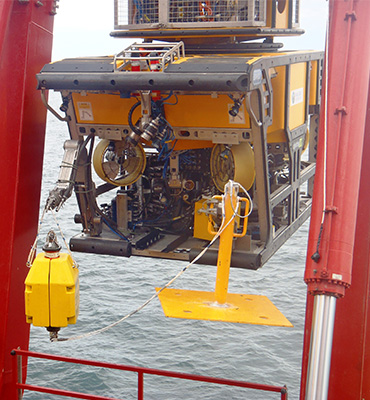
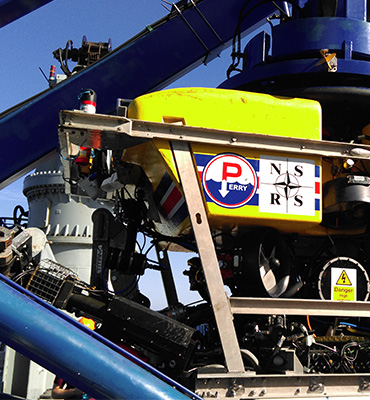
Specifications table
| Feature | Type 8370-1111 | Type 8370-4112 |
|---|---|---|
| Depth rating | 1,000 m | 4,000 m |
| Operational frequency | MF (20–34 kHz) | MF (20–34 kHz) |
| Transceiver beam shape | Omni-Directional | Directional |
| Transmit source level (dB re. 1 µPa @ 1 m) (external power/battery) | 187 dB/ 184 dB |
196 dB/ 193 dB |
| Tone Equivalent Energy (TEE) (external power) | 193 dB | 202 dB |
| Receive Sensitivity (dB re 1 μPa) | <85 dB | <80 dB |
| Power supply | Rechargeable NiMH battery or ext. 24 V via ROV umbilical | Rechargeable NiMH battery or ext. 24 V via ROV umbilical |
| Operating channels | All Sonardyne Wideband HPR 400 Channels | All Sonardyne Wideband HPR 400 Channels |
| Depth sensor | ±0.5% Full Scale (100 Bar) | ±0.5% Full Scale (400 Bar) |
| Operating life (1 s update rate, max. power, Wideband 2 ) |
>6 days | >3 days |
| Update rate (maximum) | >2 Hz | >2 Hz |
| Quiescent life (battery) | >35 Days | >35 Days |
| Connector (5-Way (standard)/ 8-Way (burnwire/motor release)) |
Subconn MCBH5M/ Subconn MCBH8F |
Subconn MCBH5M/ Subconn MCBH8F |
| Operating temperature | -5 to 40ºC | -5 to 40ºC |
| Storage temperature | -20 to 55ºC | -20 to 55ºC |
| Mechanical construction | Anodised aluminium alloy | Anodised aluminium alloy |
| Dimensions (length x diameter) | 420 x 75 mm | 429 x 96.5 mm |
| Weight in air/water | 3.2/1.3 Kg | 5.5/3.2Kg |
| Battery charger | 8370-011-01 | 8370-011-01 |
Frequently asked questions
STP files
Software and firmware
Software and control hardware
Transponders
Datasheets
Manuals and quick start guides
Technical bulletin
Did you know?
WSM 6+ is compatible with our Ranger 2 family of USBL systems: Micro, Mini and Standard
Overview
Compatt 6+ is used for high precision survey and construction operations in all water depths, including: spool piece metrology, pipeline touchdown monitoring, structure installation and dynamic positioning reference.
Compatt 6+ offers significant time saving with fast update rates (up to 1 Hz LBL tracking), all made possible using the Wideband 3 acoustic telemetry protocols. Support of Wideband 2 ranges maintains backwards compatibility. This makes any system operating with Compatt 6+ significantly easier to operate therefore de-risking operations, reducing vessel time and reducing training requirements for offshore personnel.
At a glance
- Compatible with all 6G LBL, INS and USBL systems
- Wideband 3 enabled
- Versatile, flexible and cost-effective
- Over 3,600 different configurations available
- Choice of depth ratings to 7,000 m
Our Wideband advanced signal processing offers improved acoustic performance in challenging conditions, longer ranges, improved multipath rejection around structures and real-time range diagnostics for quality control. Wideband also reduces the interference to and from adjacent Sonardyne and other acoustic positioning systems.
The integrated communications and navigation technology allows the transponder to be used as a multi-purpose modem, autonomous data logger and navigation reference transponder.
Wideband 3
For the first time, sensor telemetry data (e.g. pressure, depth or temperature) is embedded within ranging data so no more waiting for sensor readings at vital moments.
Compatible
Compatt 6+ transponders are backwards compatible with your existing Compatt 6 inventories so you can mix and match in the field.
Upgradable
We can upgrade your existing Compatt 6 into plus units quickly and cost effectively meaning you can go on to realise the full benefits of Fusion 2.
Overview
Compatt 6+ is used for high precision survey and construction operations in all water depths, including: spool piece metrology, pipeline touchdown monitoring, structure installation and dynamic positioning reference.
Specifications table
| Feature | Type 8300-3111 | Type 8300-3113 | Type 8300-5213 | |
|---|---|---|---|---|
| Depth rating | 3,000 m | 3,000 m | 5,000 m | |
| Operating frequency | MF (20–34 kHz) | MF (20–34 kHz) | MF (20–34 kHz) | |
| Transducer beam shape | Omni-directional | Directional | Directional | |
| Transmit Source level (dB re 1 µPa @ 1 m) | 187–196 dB (4 levels) |
190–202 dB (4 levels) |
190–202 dB (4 levels) |
|
| Tone Equivalent Energy (TEE) | 193–202 dB | 196–208 dB | 196–208 dB | |
| Receive sensitivity (dB re 1 µPa) | 90–120 dB (7 levels) |
80–120 dB (7 levels) |
80–120 dB (7 levels) |
|
| Ranging precision | Better than 15 mm | Better than 15 mm | Better than 15 mm | |
| Number of unique Wideband 2 addresses | >300 | >300 | >300 | |
| Battery life (listening) | Alkaline | 833 days | 833 days | 833 days |
| Lithium | 1,390 days | 1,390 days | 1,390 days | |
| External power supply | 24 V | 24 V | 24 V | |
| Safe working load (4:1) | 250 kg | 250 kg | 250 kg | |
| Operating temperature | -5 to 40°C | -5 to 40°C | -5 to 40°C | |
| Storage temperature | -20 to 55°C | -20 to 55°C | -20 to 55°C | |
| Dimensions (maximum) (length x diameter) |
With sensor guard | 1,034 x 200 mm | 1,018 x 200 mm | 1,018 x 200 mm |
| Without sensor guard | 1,034 x 178 mm | n/a | n/a | |
| Weight in air/water | 23.8/11.8 kg | 27.0/14.0 kg | 29.0/15.0 kg | |
| Endcap sensors and options | ||||
| Temperature (±0.1°C) | Standard | Standard | Standard | |
| Tilt switch (±30–45°) | Standard | Standard | Standard | |
| Strain gauge pressure sensor (±0.1%) | Standard | Standard | Standard | |
| High precision strain gauge (±0.01%) Presens or Keller |
Optional | Optional | Optional | |
| Paroscientific digiQuartz pressure sensor 1,350 m, 2,000 m, 4,130 m, 6,800 m (±0.01%) |
Optional | Optional | Optional | |
| Inclinometer (tilt sensor) range ±90°, accuracy: ±1° |
Standard | Standard | Standard | |
| High accuracy inclinometer
range: ±90°, accuracy: ±0.05° over 0 – ±15°; ±0.2° over 0 – ±45° |
Optional | Optional | Optional | |
| Sound velocity sensor ±0.02 m/s accuracy under calibration conditions | Optional | Optional | Optional | |
| Release mechanism | Standard | Standard | Standard | |
| Power for external sensors | Standard | Standard | Standard | |
| Gyro input | Standard | Standard | Standard |
Frequently asked questions
Compatt 6 and 6+ Deployment Tests
Frequency management is obsolete. Here’s why.
6G Terminal Lite Range Test
When to use a float, when to use a stand?
How can I get the best performance from my long layback tracking operations?
How can I deploy my Compatt 6+ using iWand?
How to correctly set a Compatt 6+ release mechanism
Does Compatt 6+ have modem capabilities?
How often do endcap sensors need calibrating to keep them in spec?
Is it possible to position Compatt 6+s independently within the same array and send each positioning out of Fusion to our navigation software?
Will Compatt 6+ work with Ranger 2 and Marksman?
I want to buy standard red Compatt 6, are they still available for sale?
Can Compatt 6+ be used in the same LBL array as standard Compatt 6?
What is the difference between Compatt 6 and Compatt 6+?
If I’m using Fusion 2, can I choose to use Wideband 2 or Wideband 3 telemetry?
Can ROVNav 6+ be used with standard Compatt 6s?
Will my ROVNav 6 work with Compatt 6+?
Do I need to upgrade to Compatt 6+ and ROVNav 6+?
How to QC a Sound Velocity (SV) in Fusion 2
How far can my Compatt 6+ be above the seabed?
How to replace a battery in Compatt 6 and 6+ family of transponders
How to plan my sparse LBL array (guidance note)
How do I calibrate my sparse LBL array?
How do I set up structure deflection monitoring (SDM) in Fusion 2?
Can I use Compatt 6+ Multiuser in Fusion 2?
How do I perform a SLAM calibration in Fusion 2?
How do I set up sound speed collection and pressure to depth conversion in Fusion 2?
Software and firmware
Software and control hardware
Transponders
Manuals and quick start guides
Did you know?
Compatt 6+ uses Wideband 3 technology
